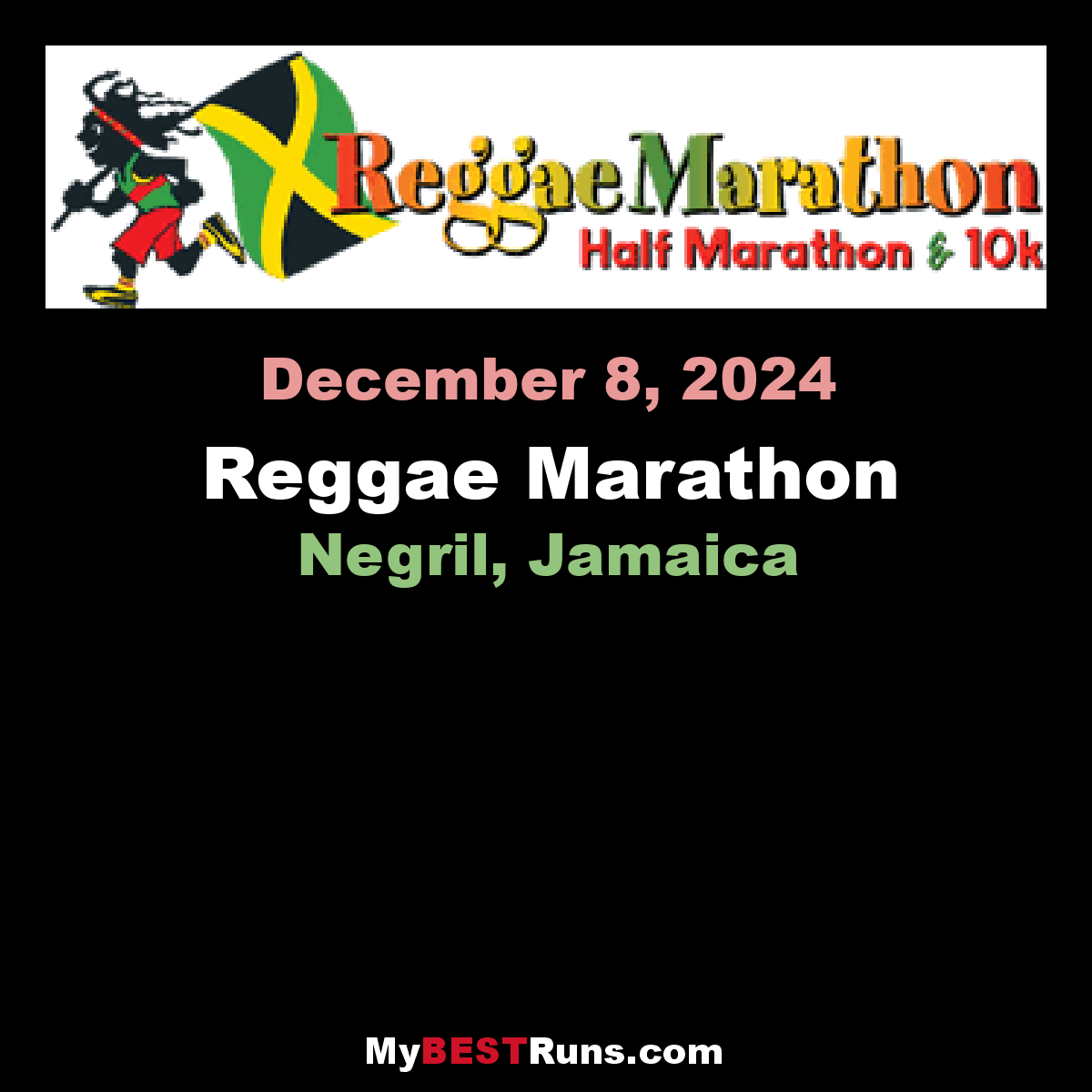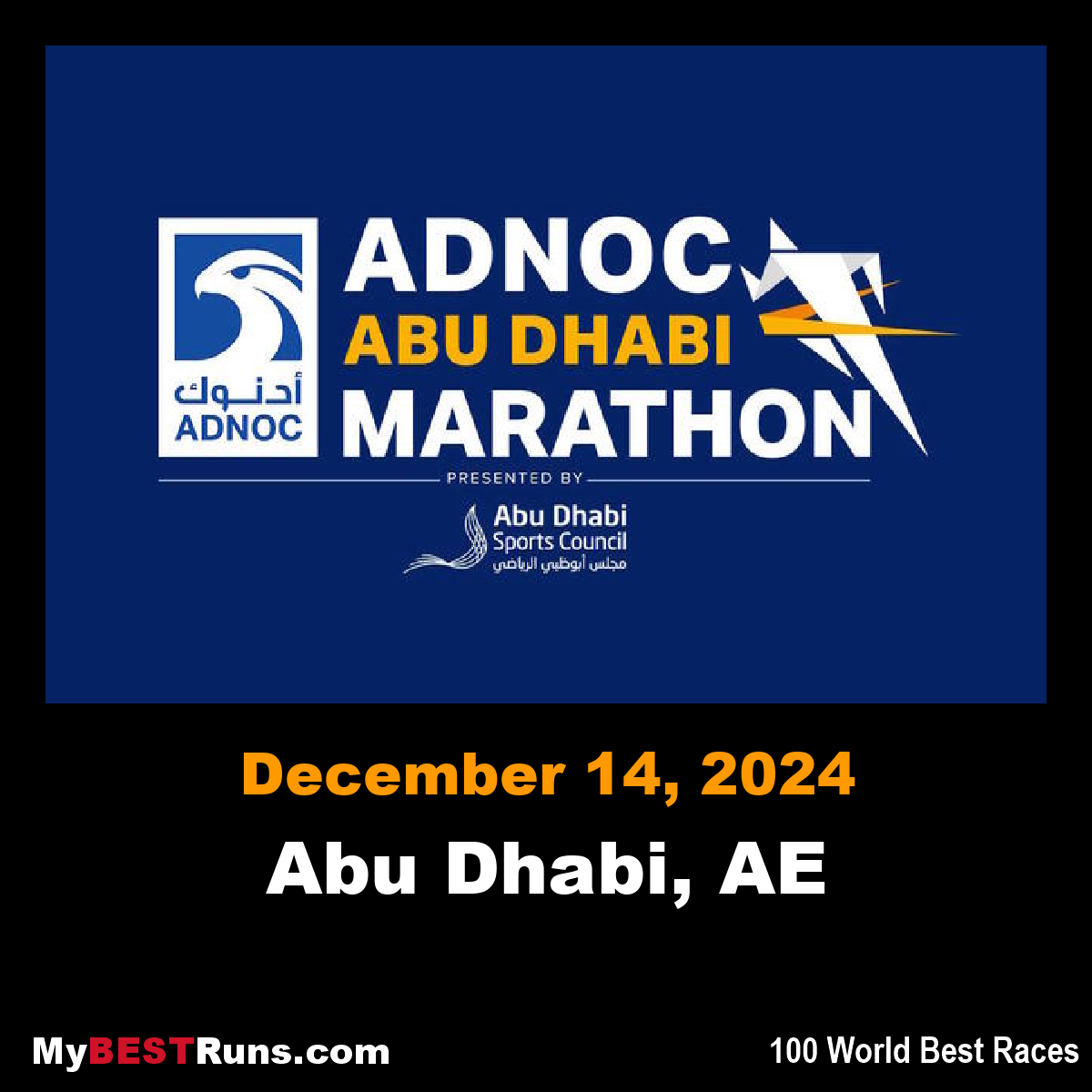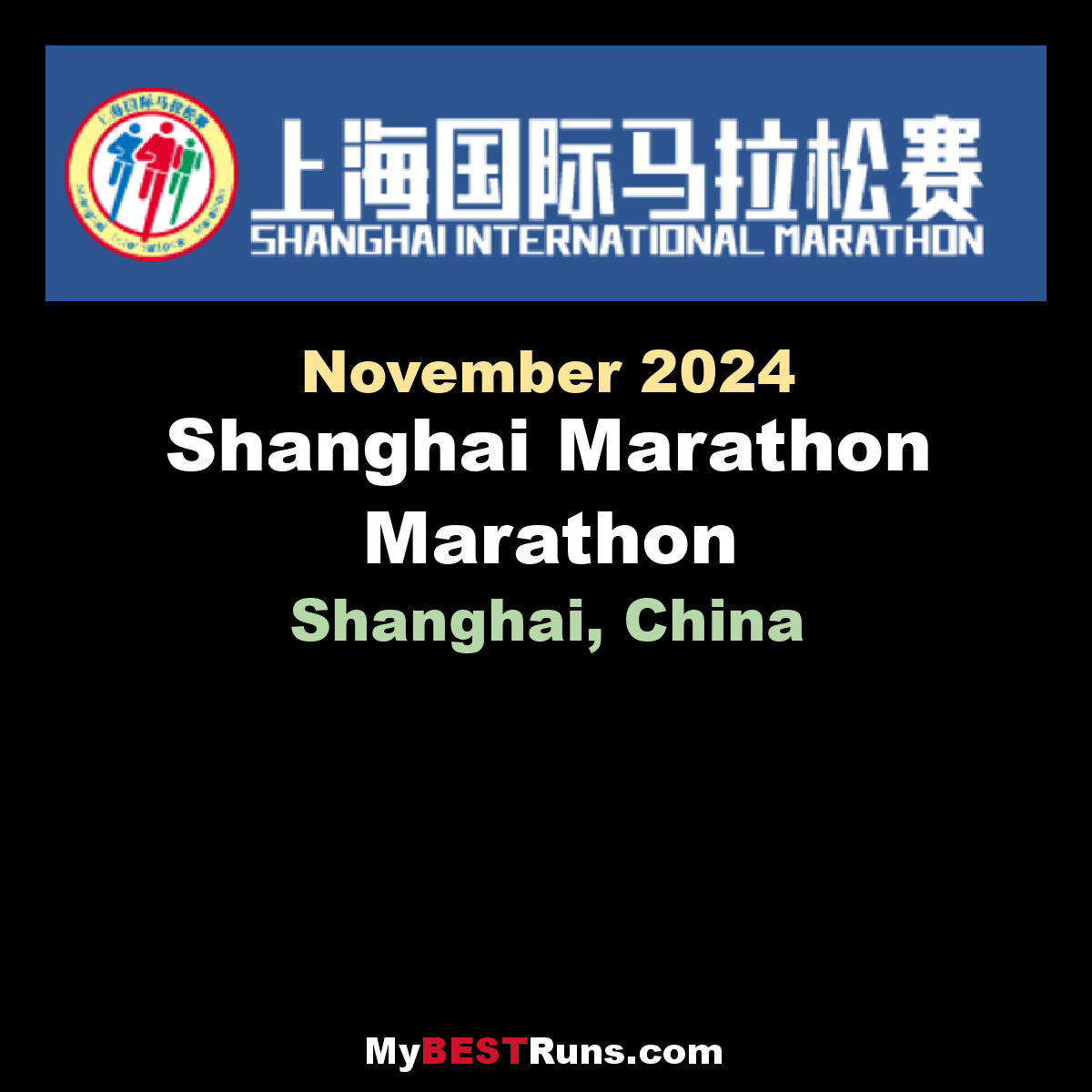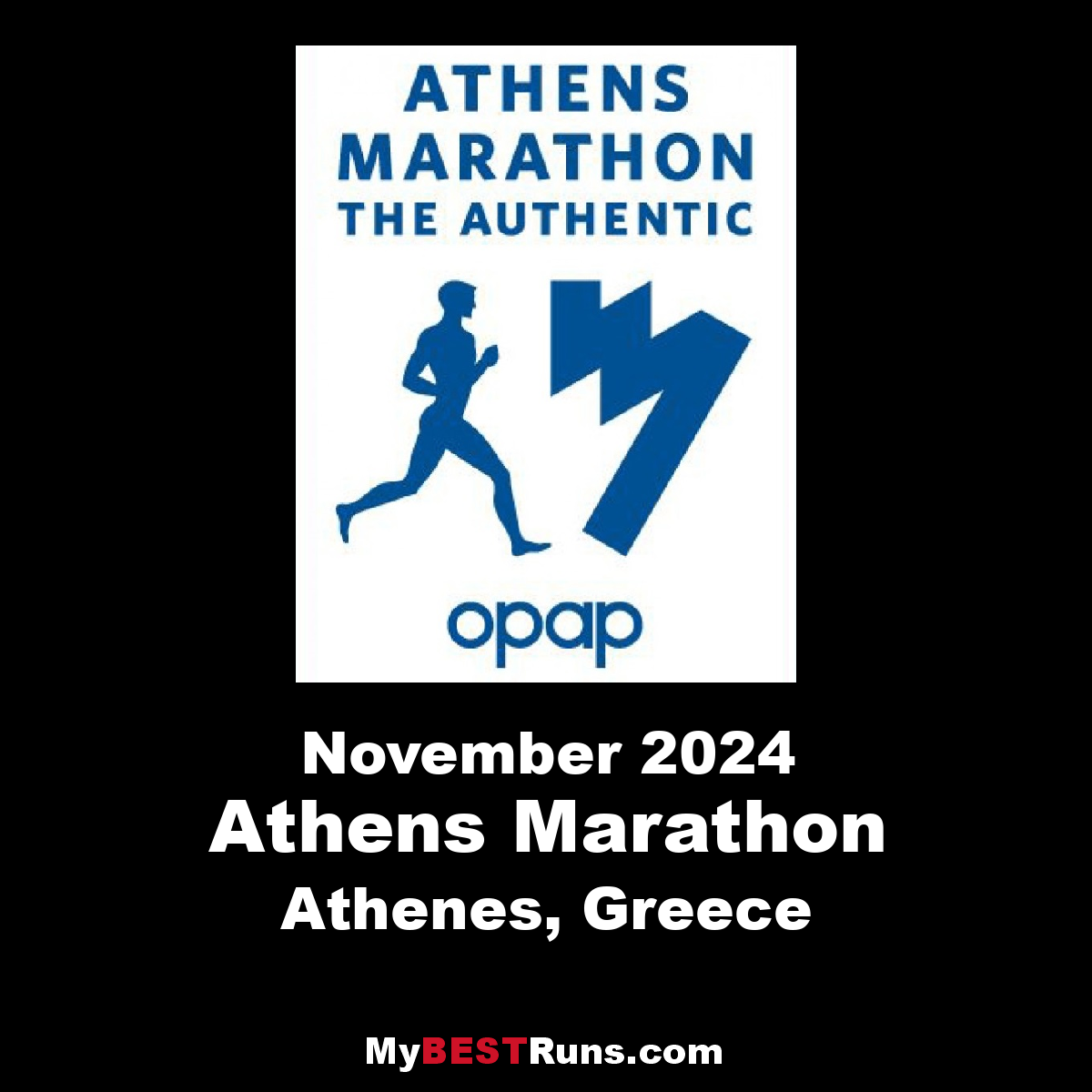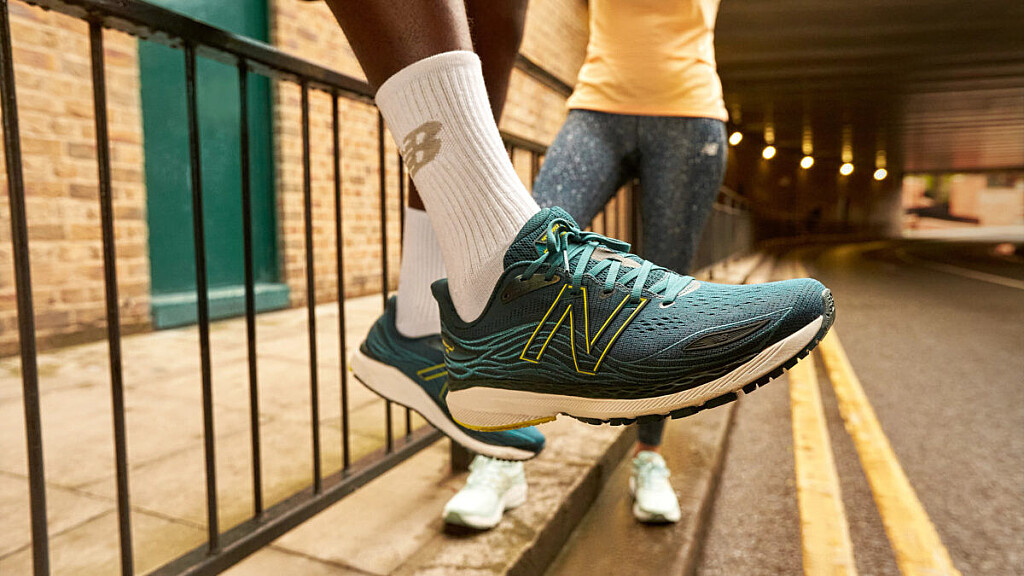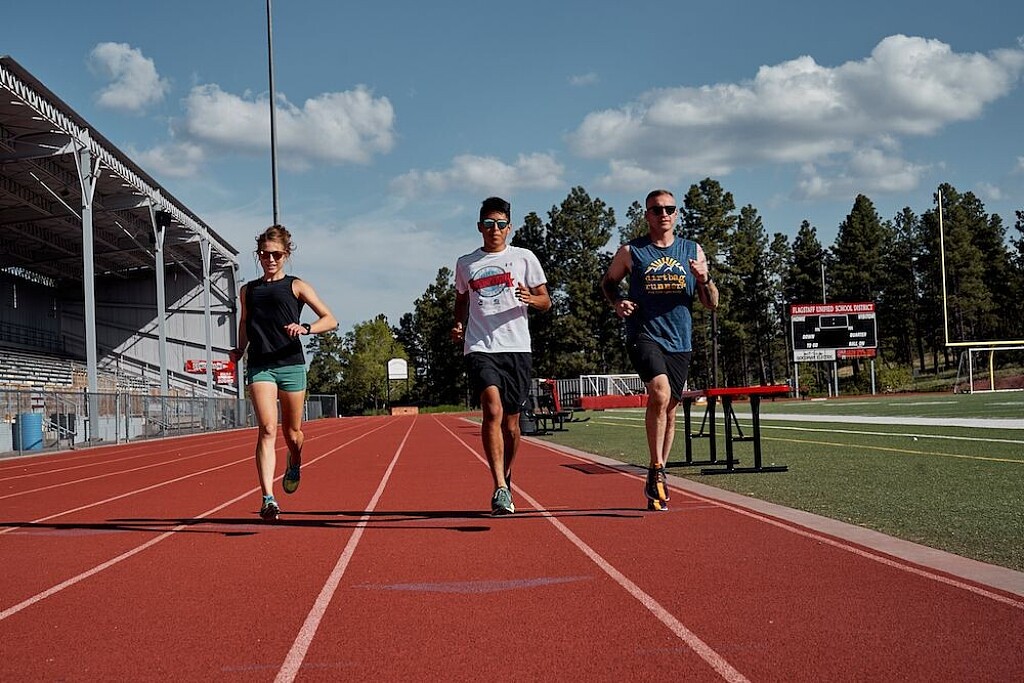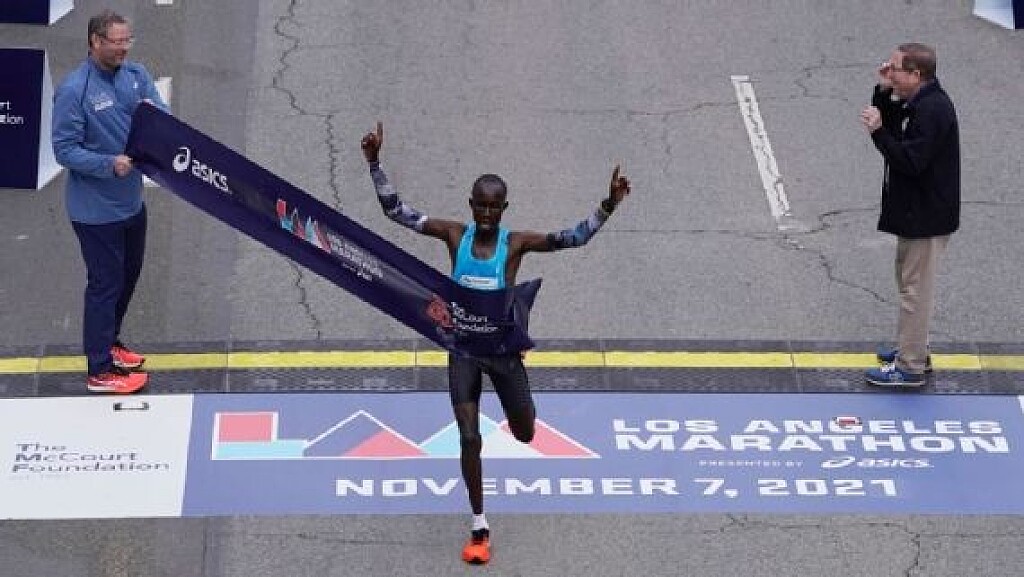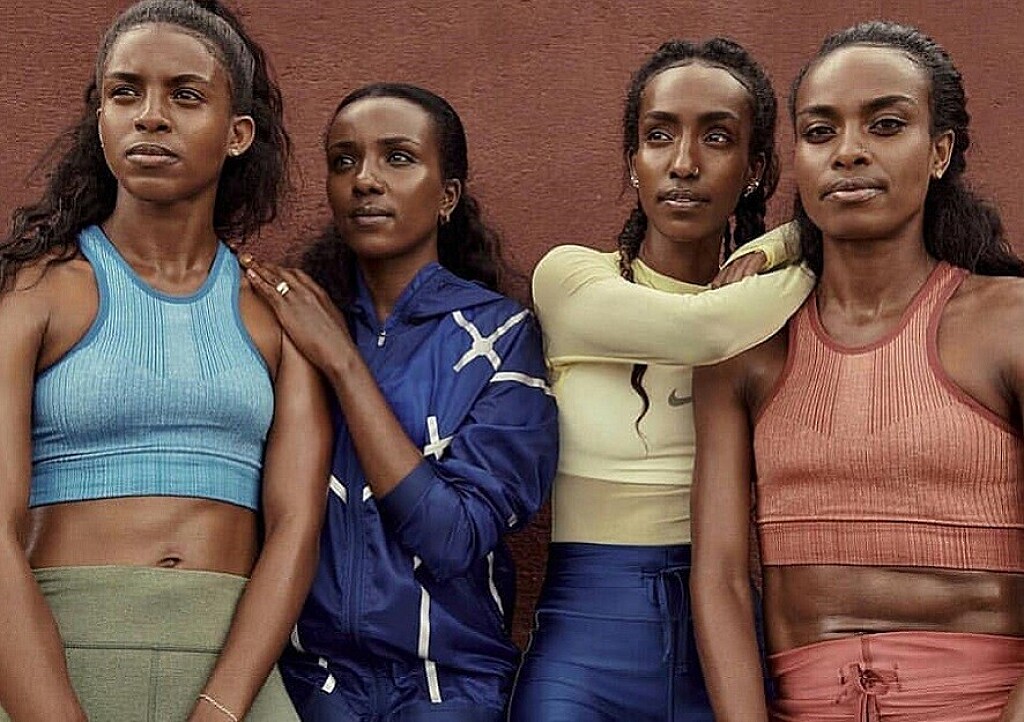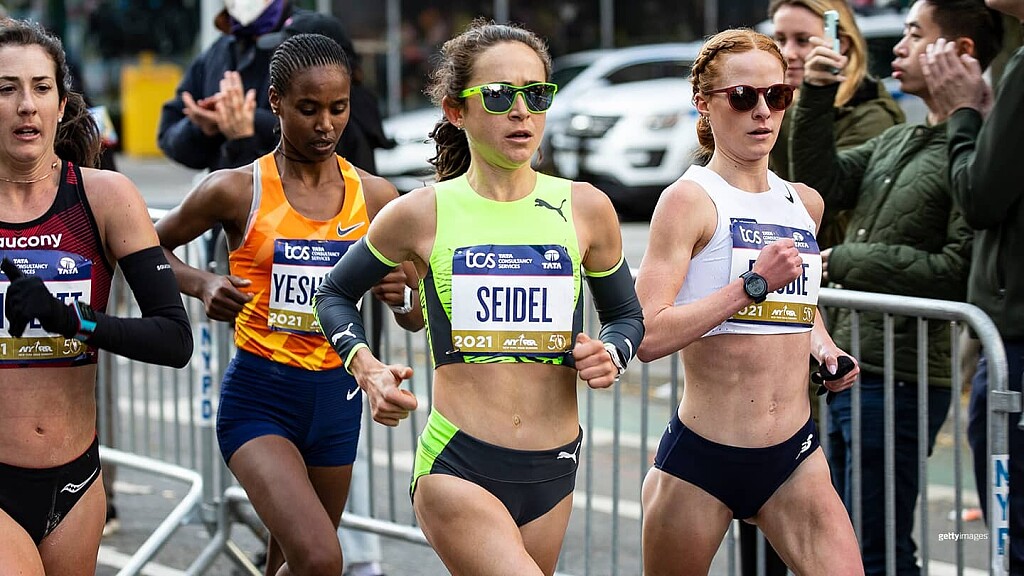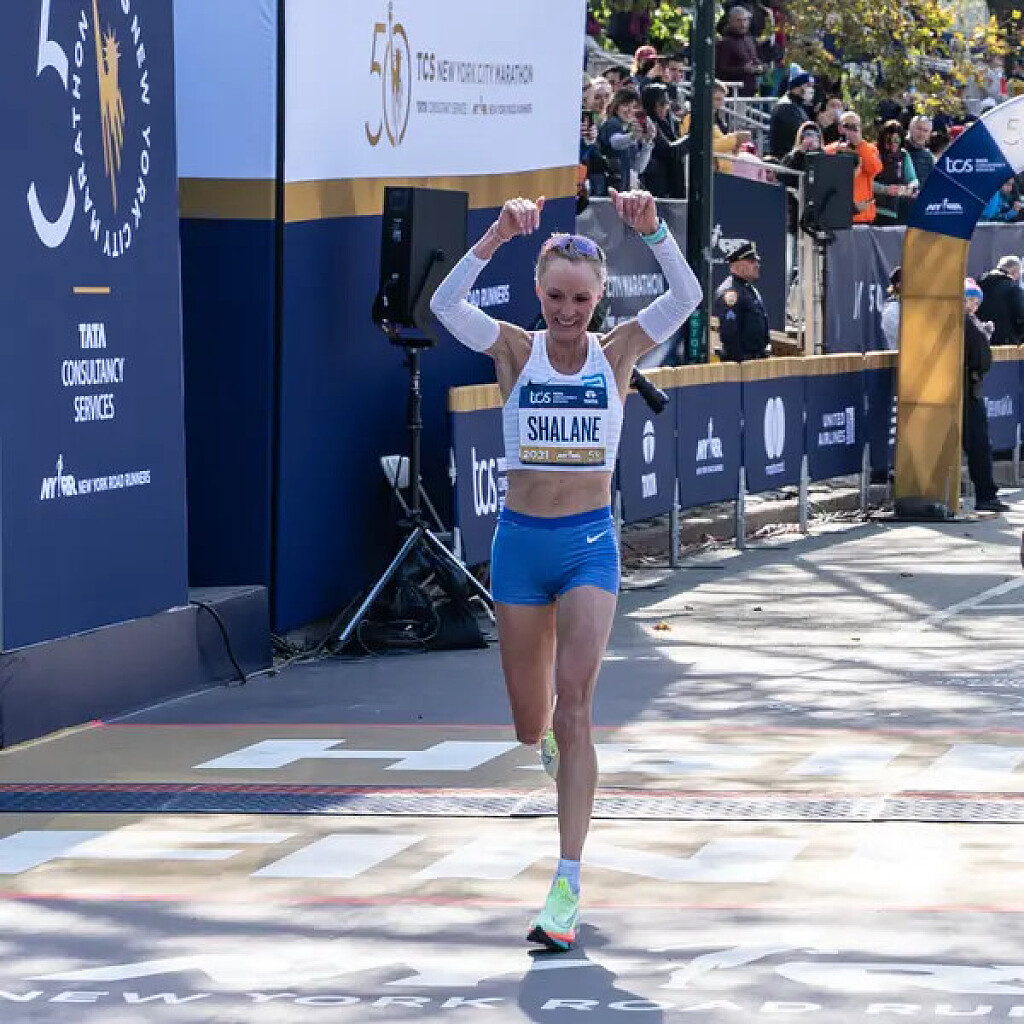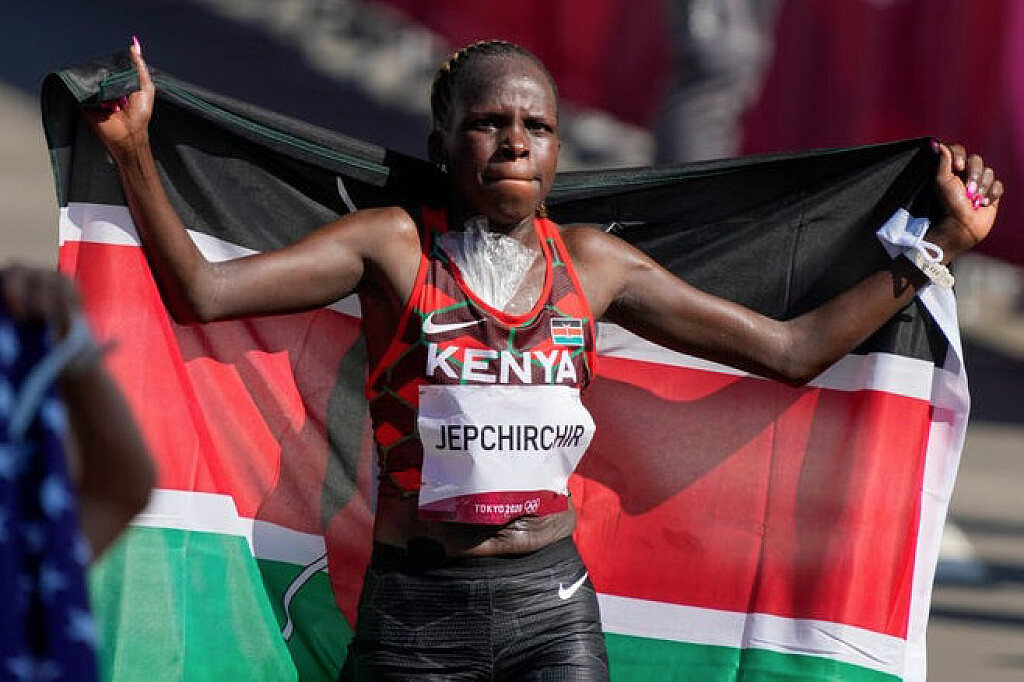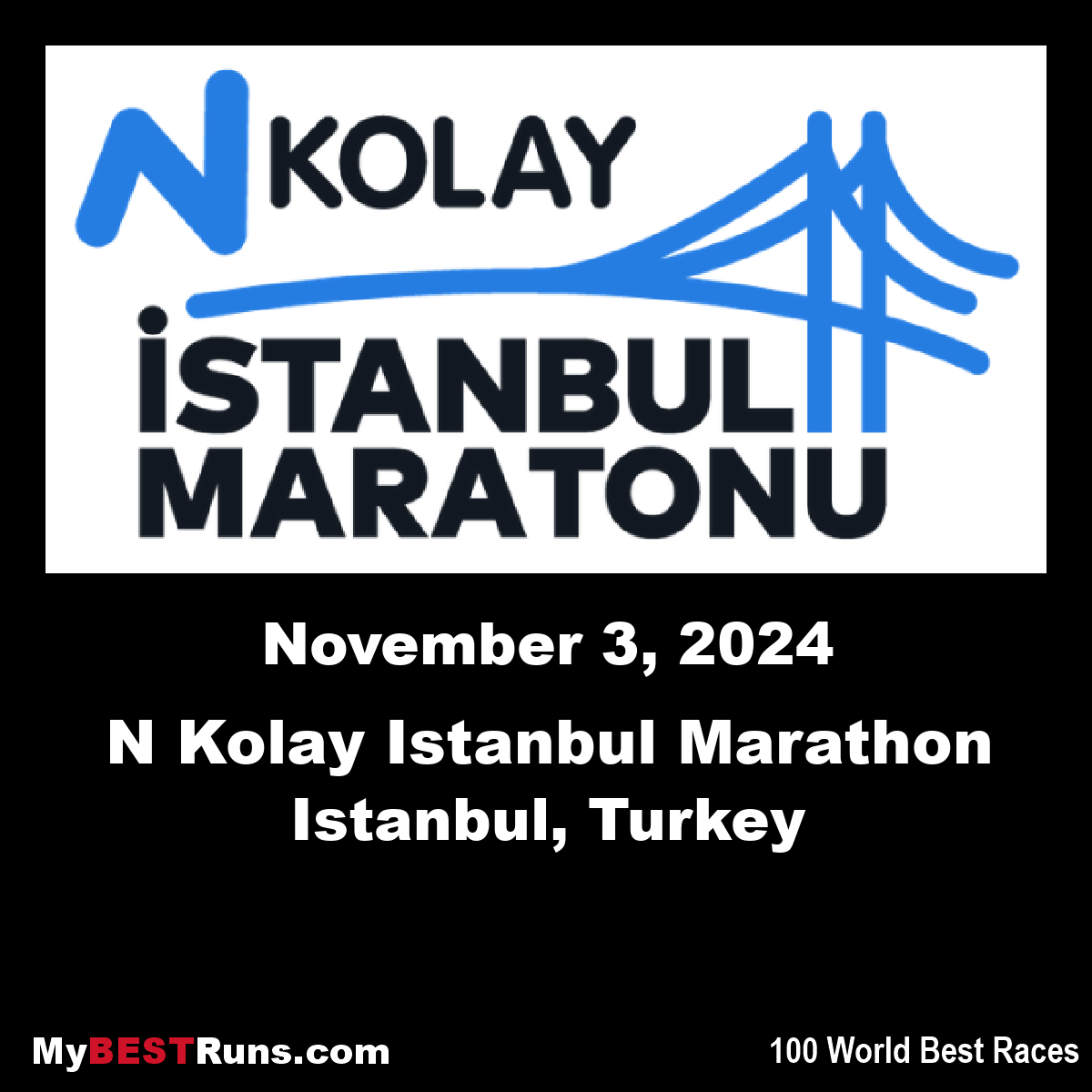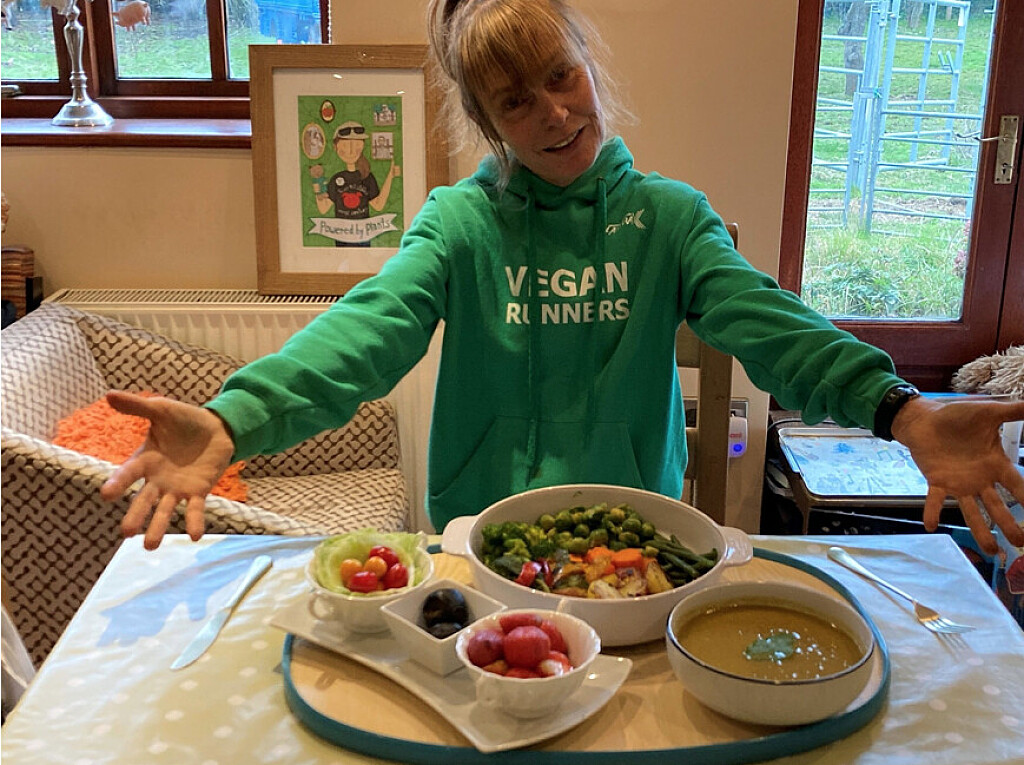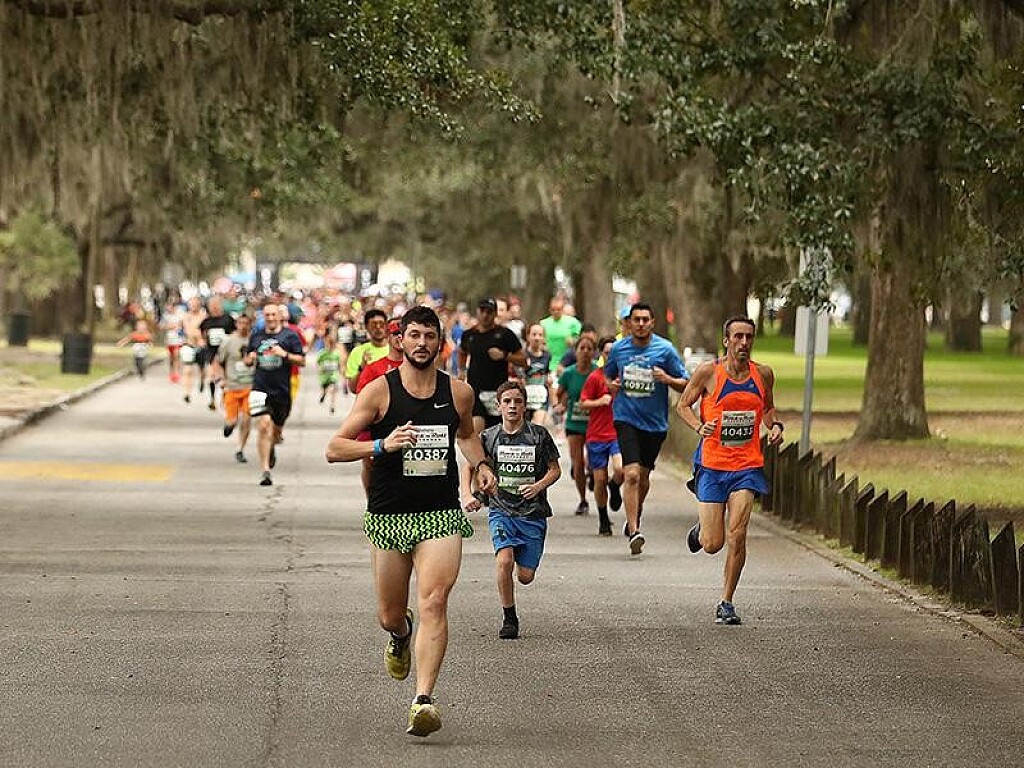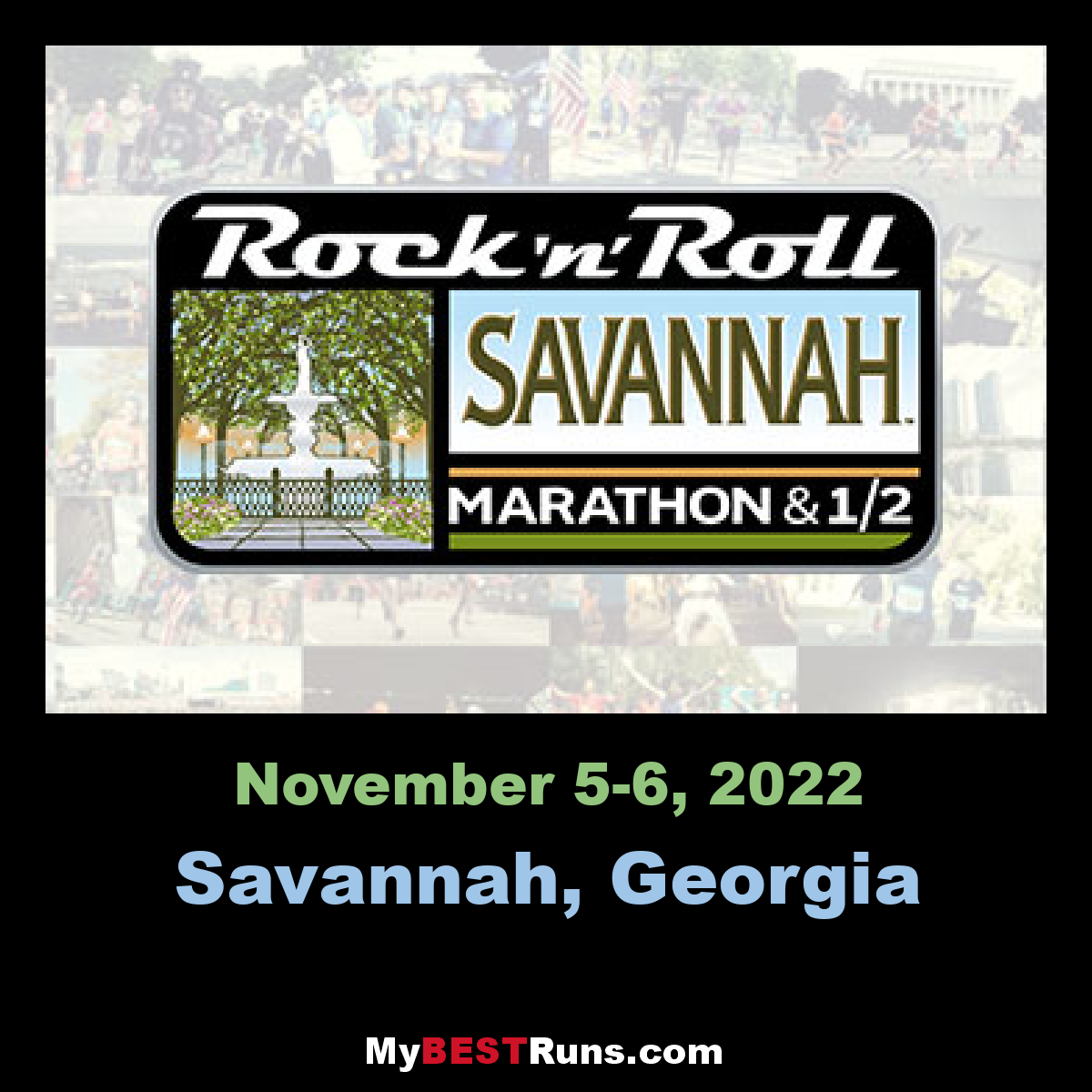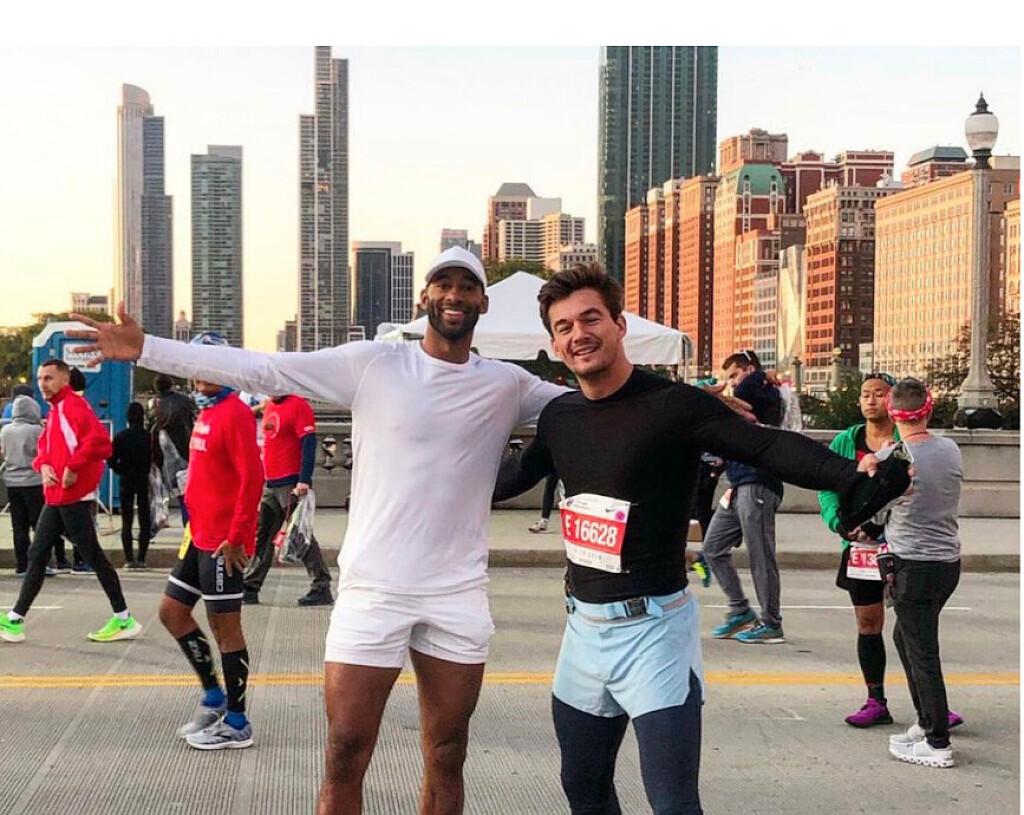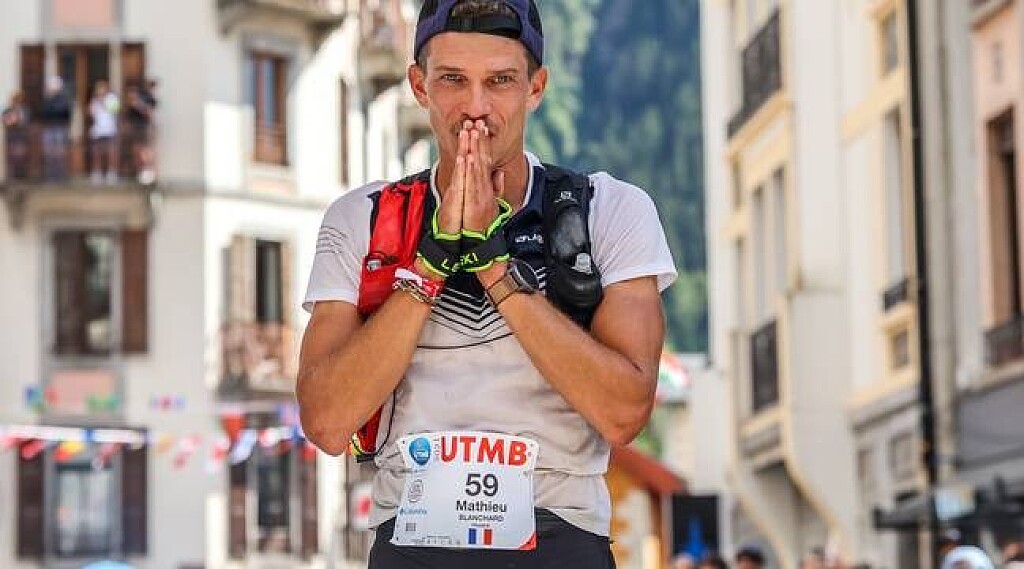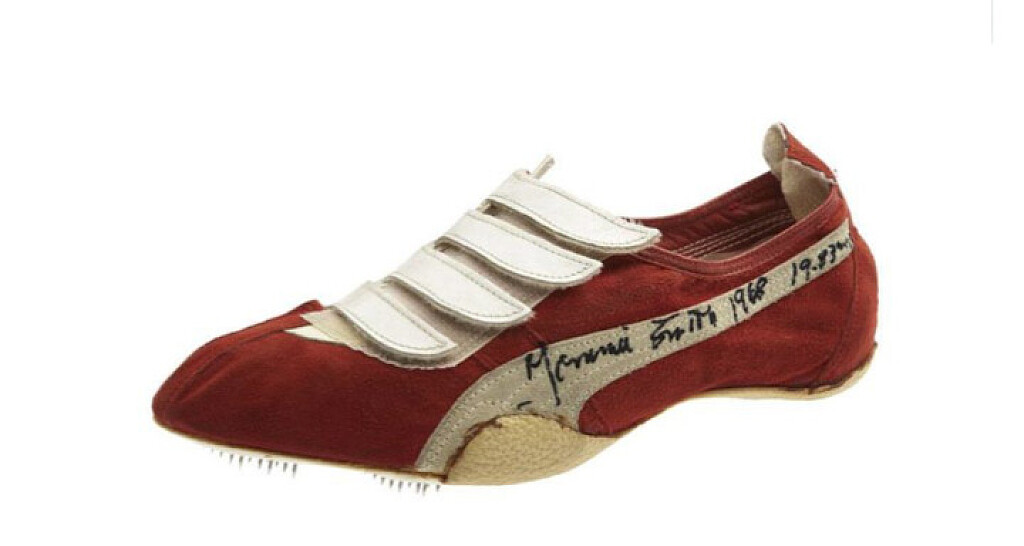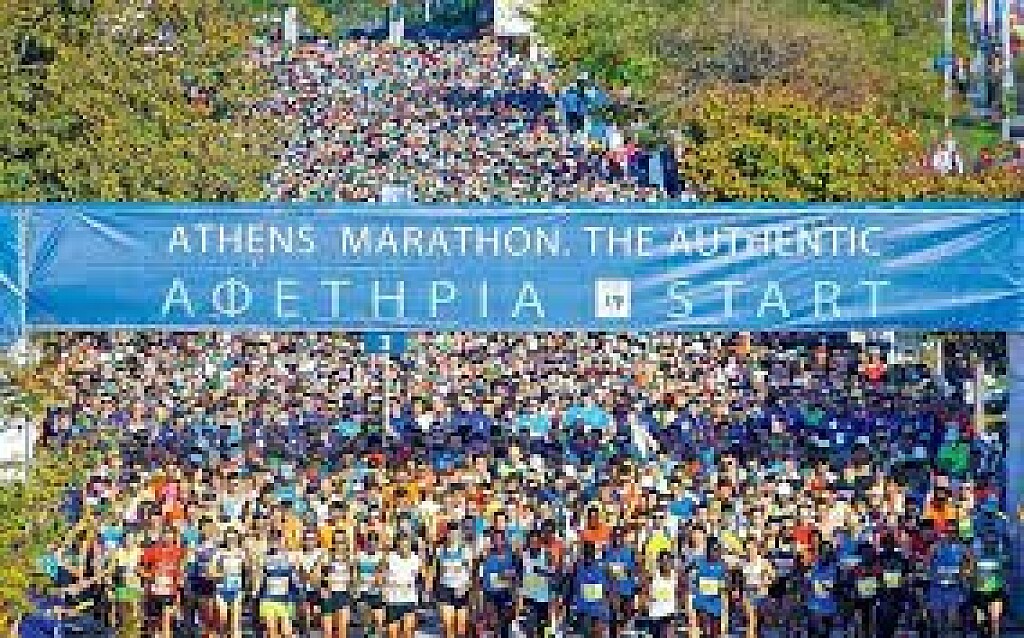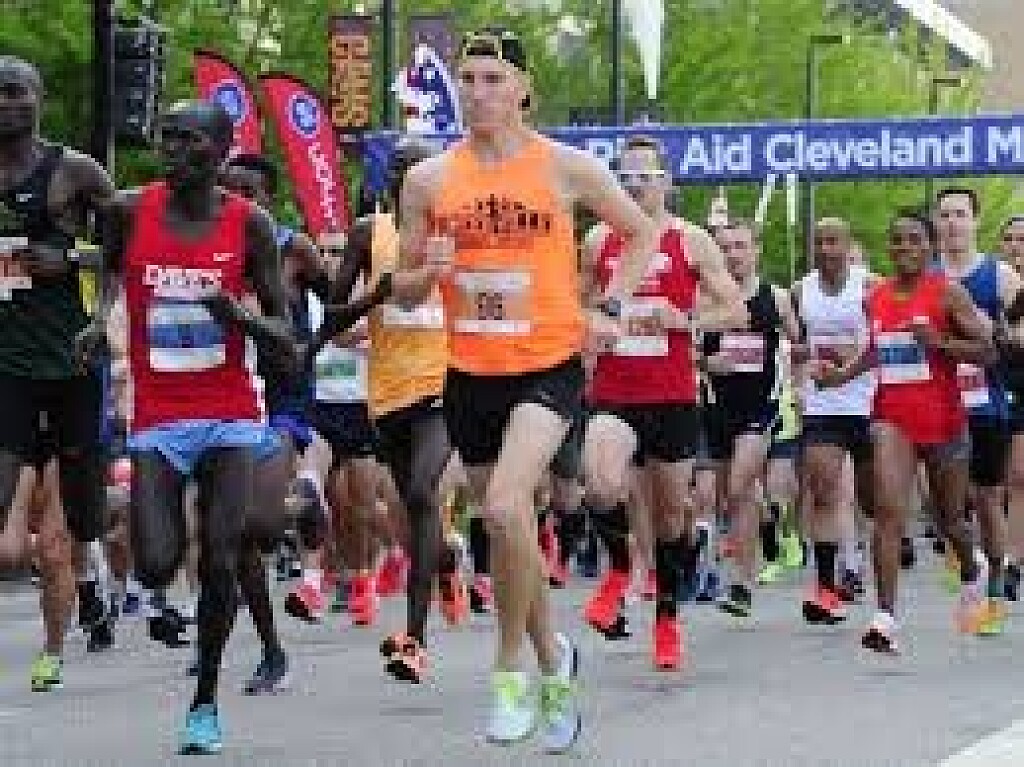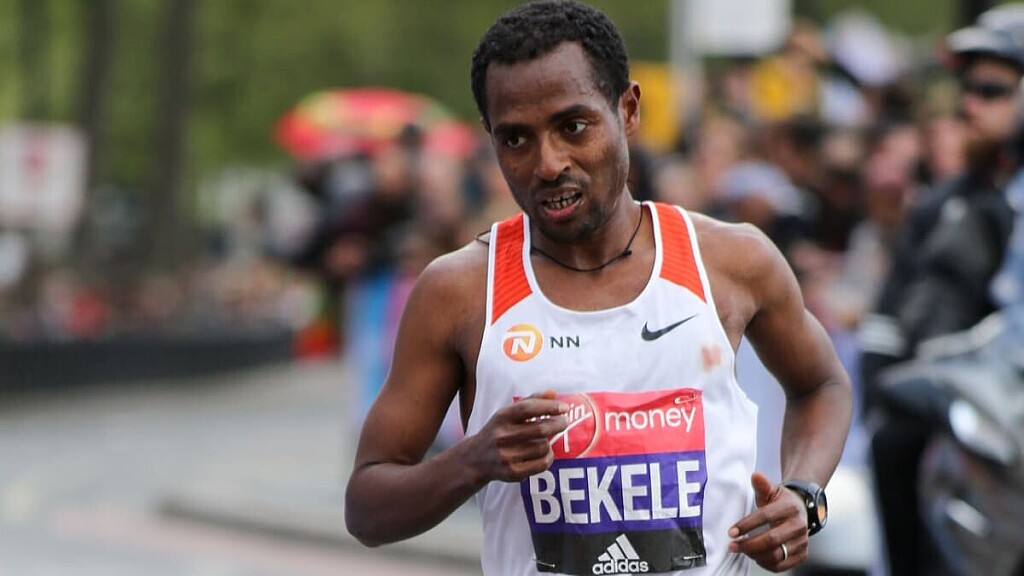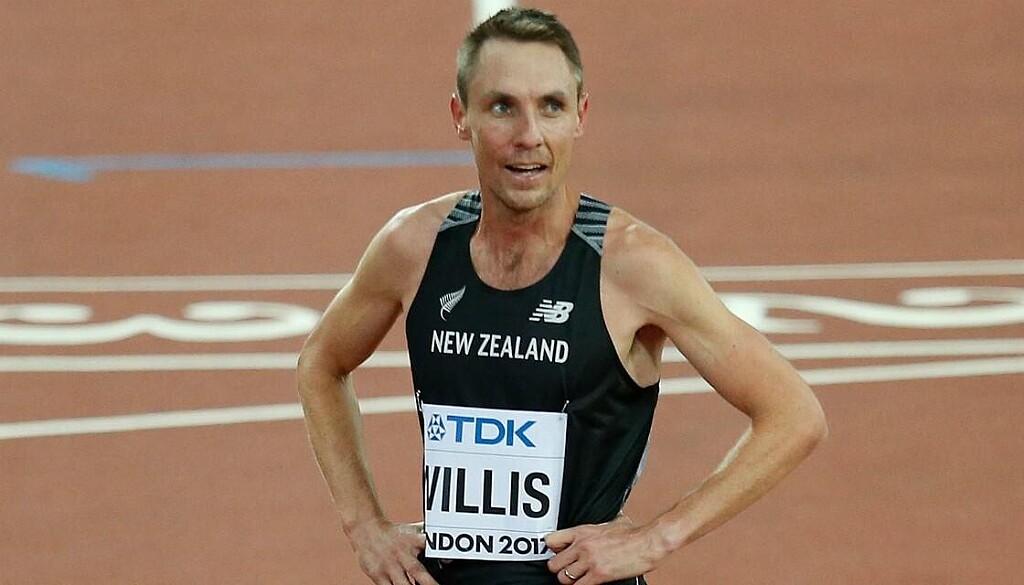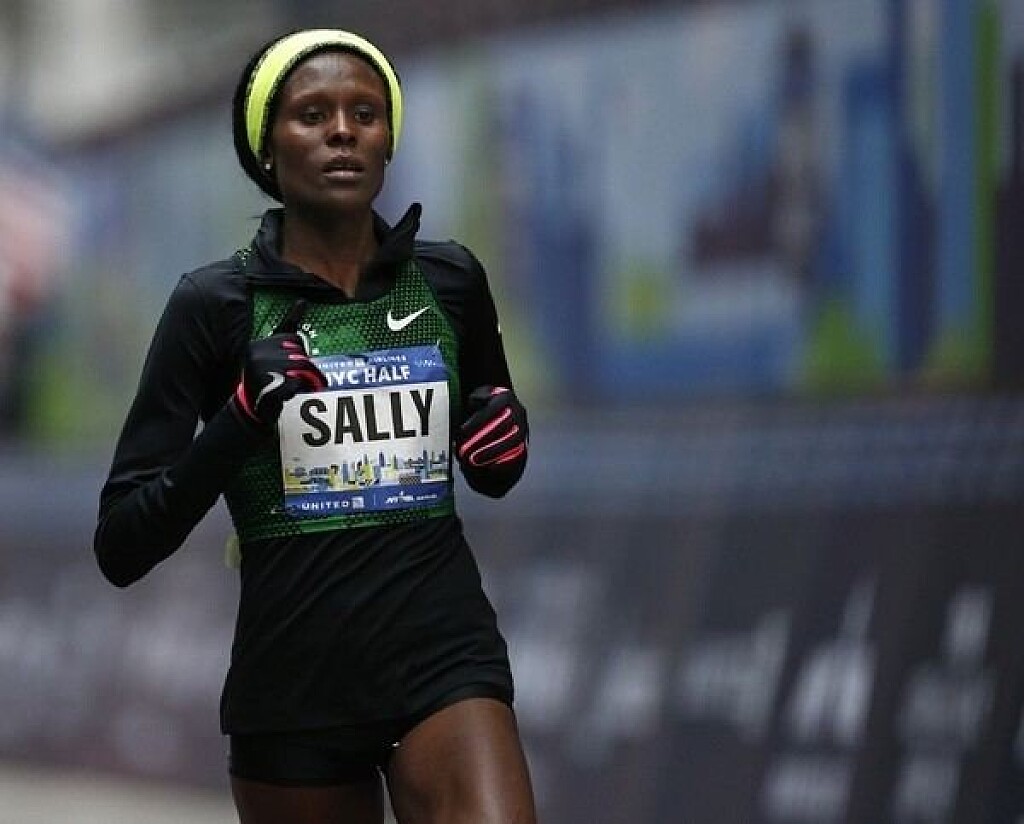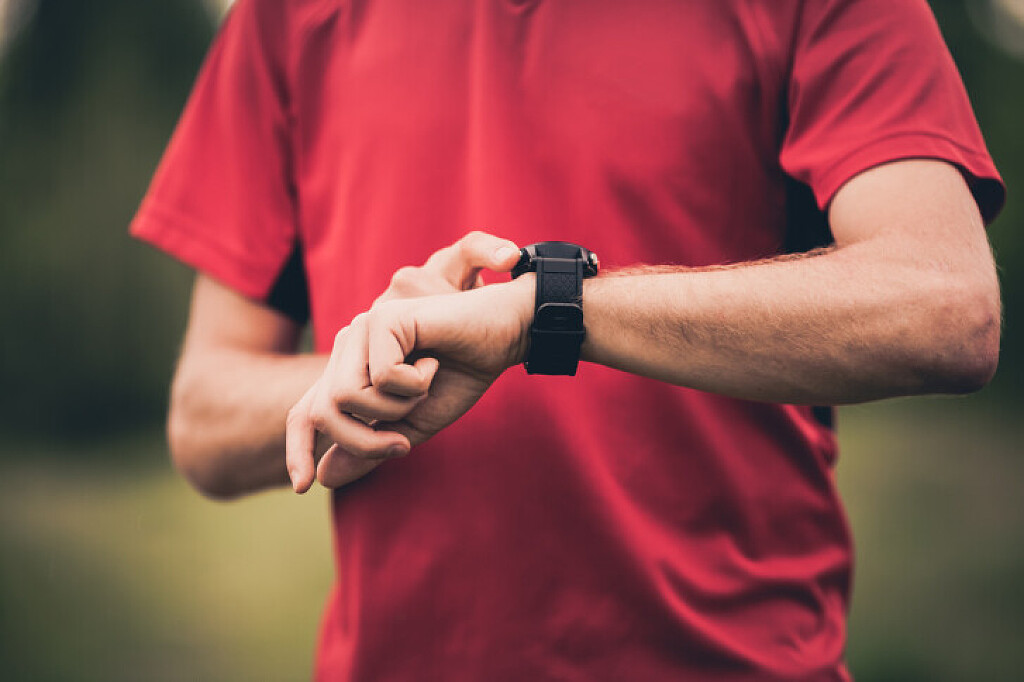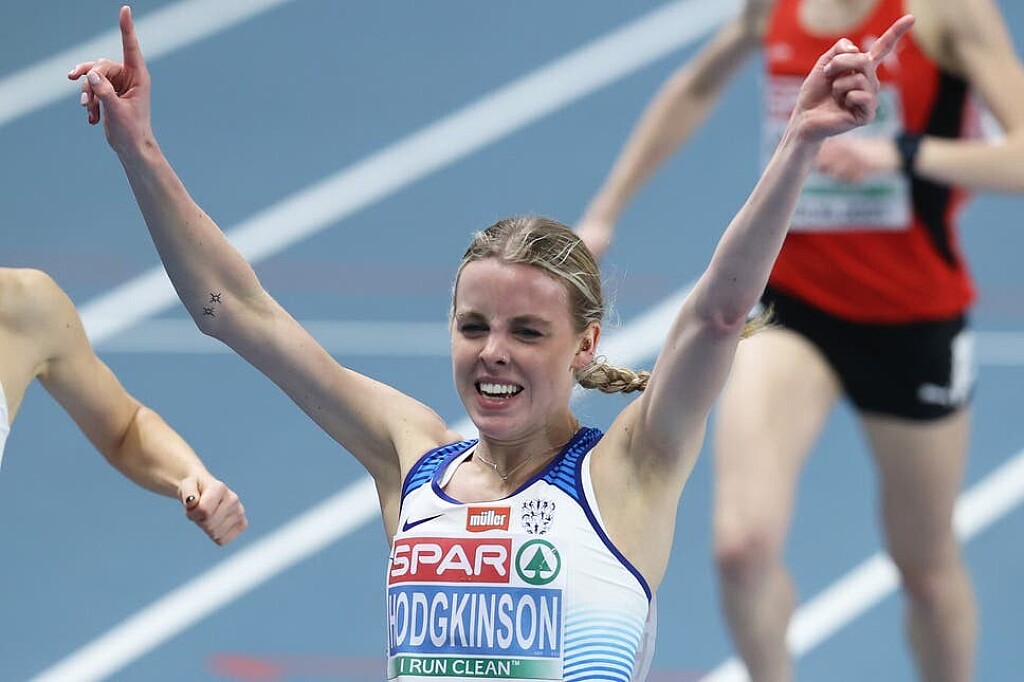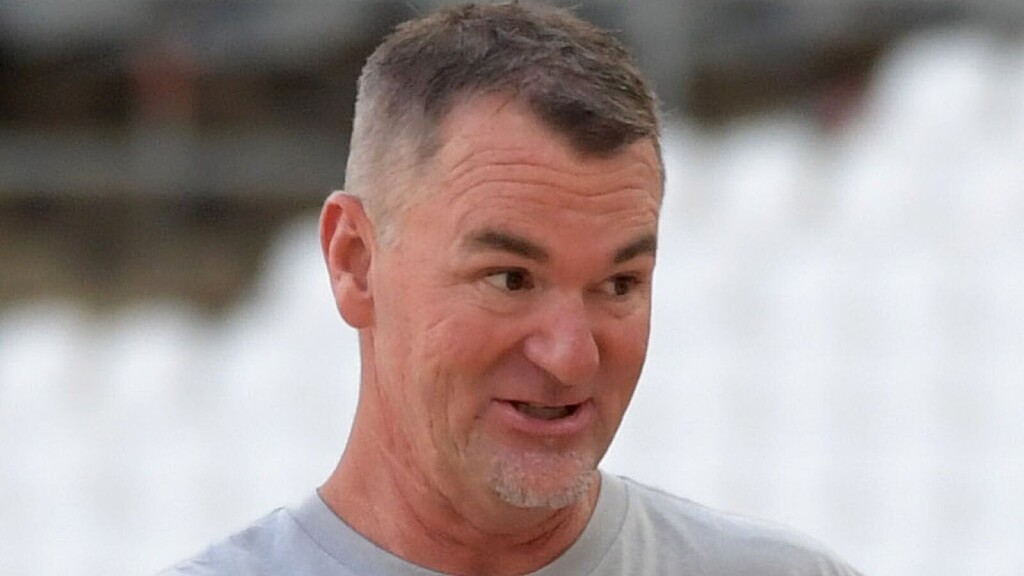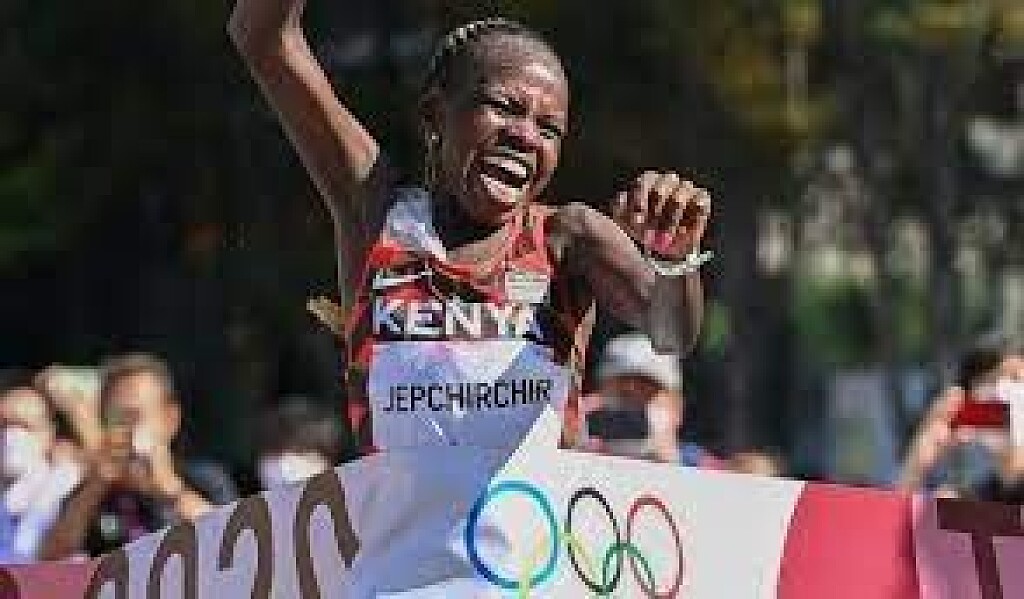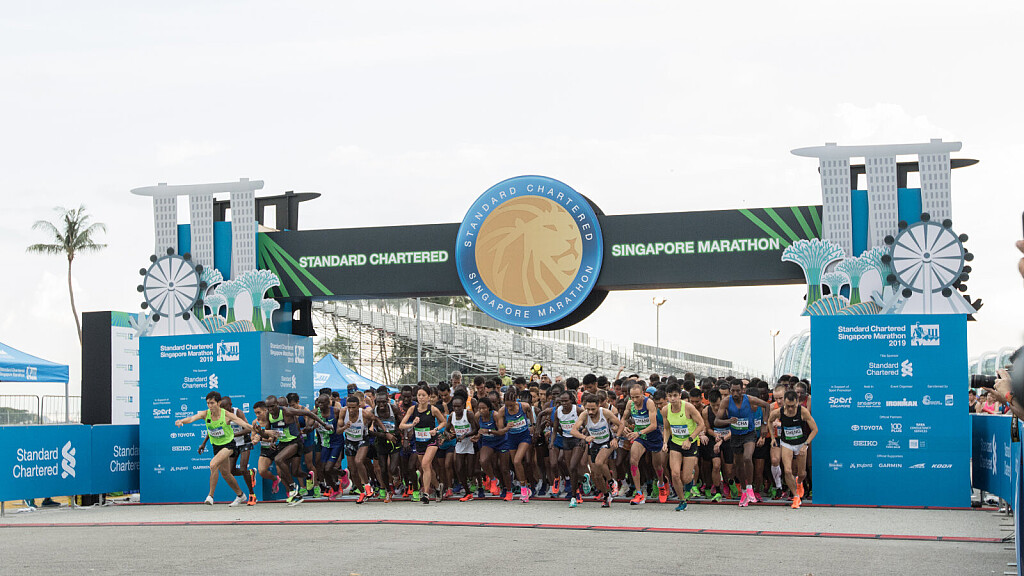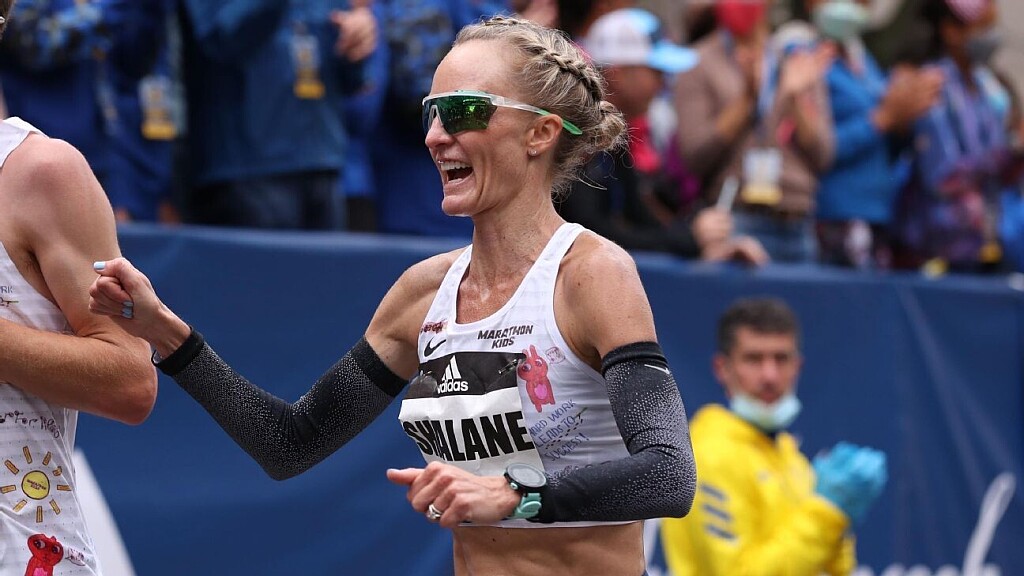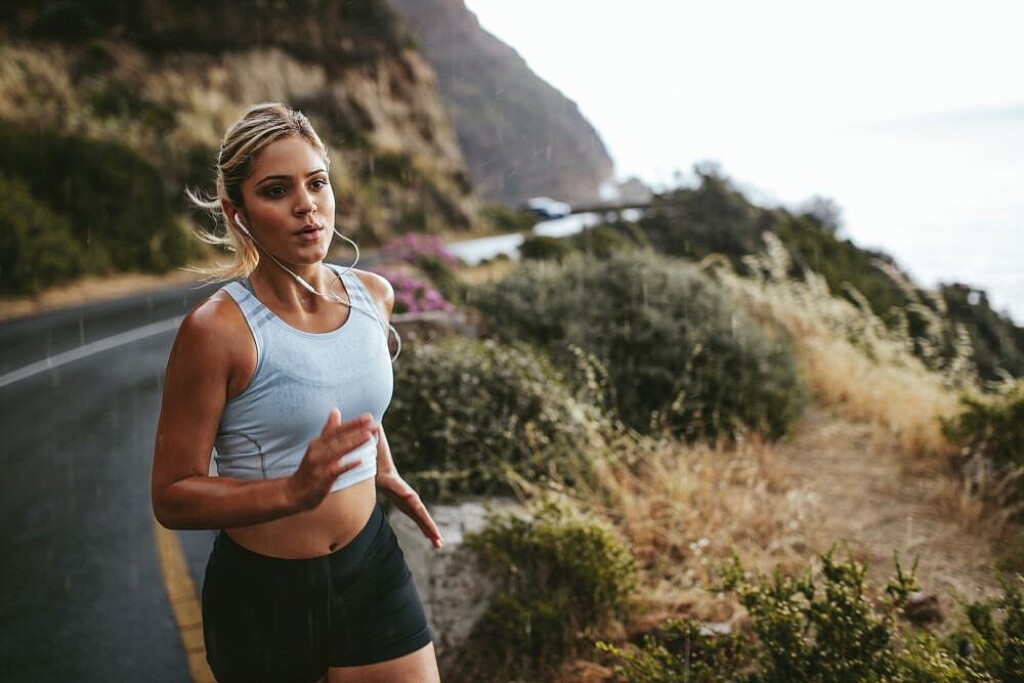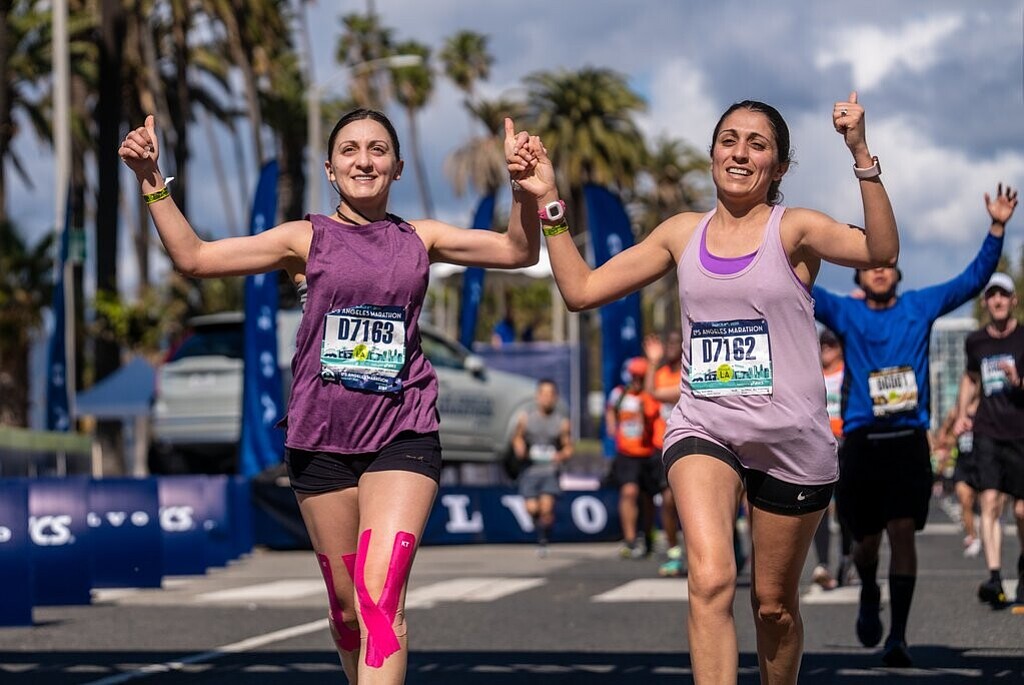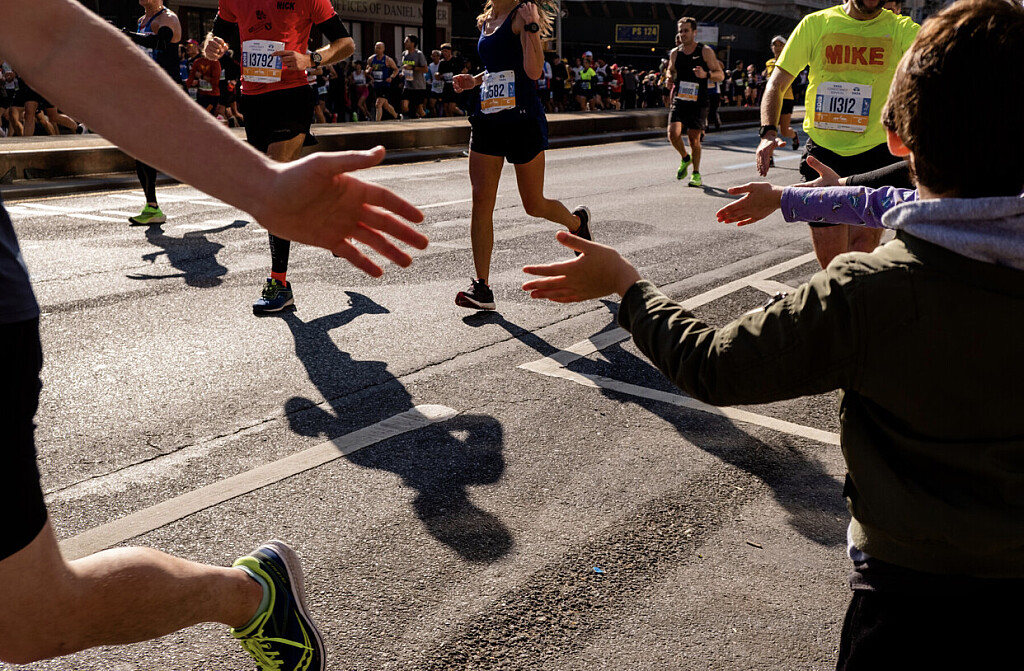Running News Daily
Running News Daily is edited by Bob Anderson. Send your news items to bob@mybestruns.com Advertising opportunities available. Train the Kenyan Way at KATA Kenya and Portugal owned and operated by Bob Anderson. Be sure to catch our movie A Long Run the movie KATA Running Camps and KATA Potato Farms - 31 now open in Kenya! https://kata.ke/
Index to Daily Posts · Sign Up For Updates · Run The World Feed
High school cross-country runner disqualified for swearing
Michigan High School Cross-Country Championships, a runner was disqualified after cussing in disbelief at his second-place finish.
Parchment High School’s Garrett Winter passed a competitor during the final 100 metres of the race and celebrated by yelling “Holy f@#king s^*t, let’s go” as he crossed the line. You can check out the video below. Winter is the second runner to cross the line.
His disqualification has caused a stir online, but according to the National Federation of High School Sport (NFHS), the governing body for U.S. high school sports, states that “Unacceptable conduct by a competitor, failing to follow the meet rules and directions of a meet official, or using profanity that is or isn’t directed at someone will result in disqualification from the event.”
According to his Twitter, his coaches appealed the ruling, but it was upheld. Winter ran a 22-second personal best in the 5K race for a time of 15:27 – a time that he didn’t think was possible. He issued a Twitter apology on Monday night.
Many runners on Twitter are in disbelief over the ruling, as Shalane Flanagan once yelled a similar term after winning the 2017 New York City Marathon and no one batted an eye.
Since Winter’s disqualification, an online petition has gained traction to change Rule 4-6 of the NFHS rule book, to reinstate Winter’s second-place finish. The petition was tweeted out by Canadian marathoner Rob Watson, who recalls saying similar words during his collegiate days at Colorado State University.
(11/13/2021) ⚡AMPby Running Magazine
The Air Force Marathon Expands Military Discount to Veterans, Military Service Members for 2022 Registration
The 2022 Air Force Marathon is gearing up for registration on Jan. 1 with the new year arriving.
Along with active duty, reservists, and National Guard members, discounts will be also offered to veterans and members of the ROTC. All who qualify will be offered $10 off the full marathon, half marathon, relay, and the Fly! Fight! Win! Challenge Series, or $5 off the 10K and 5K.

As the Air Force Marathon celebrates the 75th Anniversary of the United States Air Force, race director Brandon Hough is ready to welcome runners back to Wright-Patterson Air Force Base.
“The Air Force Marathon is thrilled to be able to extend a registration discount to those who have proudly served their country and have turned to a new chapter in their lives. Once a veteran, always a veteran,” he said.

The Annual Air Force Marathon is scheduled for Saturday, Sept. 17, 2022. The Health & Fitness Expo, held at Wright State University’s Nutter Center is scheduled for Thursday, Sept. 15 and Friday, Sept. 16. The weekend will also feature a Breakfast of Champions and Gourmet Pasta Dinner the same day as the 5K and Tailwind Trot on Friday, Sept 16, as well as an After Party on Saturday, Sept. 17.
Coronavirus trends and local guidance is being monitored to maintain a safe experience for all attendees and the community.
For more information about the race weekend visit www.usafmarathon.com
(11/12/2021) ⚡AMPby Running USA
Air Force Marathon
The first official marathon was held on September 20, 1997, celebrating the 50th anniversary of the Air Force, and is held the third Saturday in September each year. 2023 marks the 27th year and is set forSeptember 16th, 2023. To commemorate our rich history in flight, each year one aircraft is chosen to be highlighted during the marathon and on...
more...Study says endurance training beats strength at improving long-term health
Runners and gym-goers have often been at odds over the years, arguing which one is better for overall health, and it appears that science has given one point to team endurance.
A recent study determined that endurance exercise is better for improving blood sugar, cholesterol, blood pressure and waist circumference than lifting weights.

The study
The study, published in the Journal of Applied Physiology, found that endurance exercise, like running or biking, stimulates circulating levels of certain mitochondrial-derived peptides (MDP’s), which could lead to increased longevity and metabolic health. They found that strength training, on the other hand, did not have the same effect.
Your mitochondria are known as the “powerhouses” of the cell, and are responsible for energy production. MDP’s perform similar functions to the mitochondria, and they play a protective role in maintaining mitochondrial function. Endurance exercise appears to stimulate the production of MDP’s, which translates into better blood sugar and cholesterol levels, improved blood pressure and a healthier waist circumference — all factors in good long-term health. (Note that a healthier waist circumference does not mean thinner — it simply means a size that is appropriate for the individual).
To come to this conclusion, researchers put participants into one of three groups: one that cycled for 45 minutes at 70 per cent of their estimated VO2 max, one that performed a strength training session including leg press and knee extension exercises and a third group as the control. Skeletal muscle biopsies and blood samples were collected before and at 30 minutes and three hours following exercise.
The researchers found that the participants who performed the endurance workout had increased levels of circulating MDP’s, while the strength training group did not see any change. “In conclusion, our results indicate that circulating levels of mitochondrial-derived peptides are upregulated by endurance exercise in healthy subjects,” the researchers wrote.
This doesn’t mean you should give up strength training
If you were hoping this was finally the excuse you were looking for to skip your next gym session, don’t get ahead of yourself. While strength training may not have as beneficial an impact on blood sugar, pressure, and other biomarkers of health, it still provides plenty of benefits. As a runner, it’ll make you stronger and more injury-resistant, and when it comes to healthy aging, strength training can prevent a lot of muscle loss that often comes with getting older.
So no, you shouldn’t stop strength training, but the next time your non-running gym friends try to convince you running isn’t as good as for you as lifting weights, you can show them this study (and maybe convince them to join you for a run sometime).
(11/12/2021) ⚡AMP
by Brittany Hambleton
New York Marathon champ Peres Jepchirchir gets huge reception at airport upon return to Kenya
New York City Marathon champion Peres Jepchirchir on Thursday received a rapturous reception at Eldoret International Airport as she jetted back home following Sunday victory which marked an end to a successful season.
Jepchirchir won the New York Marathon in 2 hours, 22 minutes, 39 seconds barely three months after winning the Olympic Marathon tittle in Sapporo, Japan in 2 hours, 27 minutes, 20 seconds.
At the airport the mood was exuberant as Jepchirchir's family members, athletics Kenya officials, relatives and friends together with students of Moi Girls Kapsowar joined in welcoming her.
Jepchirchir is Moi Girls Kapsowar patron, and recently helped the school organise charity race for conservation.
Jepchirchir said she was not thinking of winning but was hopeful she would do her best New York.
“When I was at the 27 kilometre mark, I saw Violah (Lagat) and I slowed the pace to wait for her. When she caught up she told me the race was getting tougher but I encouraged her we soldier on because when we are done with 35 kilometres, no one would catch up with us,” she said.
“We kept on encouraging each other and I am happy for Violah because it was her marathon debut and she fought well.”
She said she was grateful to all who prayed for her and for the best wishes extended to her as she prepared for the race and even while in New York.
“For now I am going to relax and wait for next season. I commit all to God and look upon Him on what He has prepared for me next year,” she said.
Her father Paul Kipkoech Chepkwony was lost for words following his daughter's exploits.
“I am grateful to God and all those who have been supporting my daughter’s talent which manifested itself while she was still a student. She used to run to and from school each day and this shaped her athletics prowess,” said Chepkwony.
Moi Girls Kapsowar head teacher Hellen Mabese Luhangala hailed Jepchirchir for the exemplary performance noting it has been a motivation to the young people.
“She has demonstrated resilience and determination by winning two marathons. At our school she is a champion of environmental conservation and motivating young people that the sky is no limit by surmounting all challenges,” she said.
Athletics Kenya President Rd. Gen Jack Tuwei said the season has been good for Kenyan athletes.
“She has kept the Kenyan spirit high. I was worried when she going for the New York Marathon because she had not recovered well from the Olympics but she assured us she was determined ahead of the race. I am happy for her because she kept our hopes alive,” he said.
Concerning the ongoing athletes workshops, Tuwei said he was impressed by the turnout.
“So far marital, relationship and investments are some of the issues athletes have revealed are affecting them. At the end of the forums, I am sure we will have known the real issues ailing them and how best to address them,” said Tuwei.
(11/12/2021) ⚡AMPby Fred Kibor
TCS New York City Marathon
The first New York City Marathon, organized in 1970 by Fred Lebow and Vince Chiappetta, was held entirely in Central Park. Of 127 entrants, only 55 men finished; the sole female entrant dropped out due to illness. Winners were given inexpensive wristwatches and recycled baseball and bowling trophies. The entry fee was $1 and the total event budget...
more...I want to run till death do me apart, Mark Kiptoo says after Masters win
Former African 5,000m champion Mark Kiptoo says he wants to continue running into his twilight years because of love for the sport.
Kiptoo said he has come to learn that running does not only benefit one financially but also has additional perks to make one a well-rounded human being.

"Of course, it is my desire to continue running even when it no longer puts food on the table. If my body allows me, I want to continue running until I am very old. I think this is something that should be encouraged even among the younger generation. If many of us can embrace running even as a hobby, then that translates into a healthy nation," Kiptoo, 45, said.
The 2010 Commonwealth 5,000m bronze medalist shone in the men's 10,000m final during the national trials for the Open Africa Masters Athletics Championships at Nyayo Stadium where he came first.
Competing against athletes of different ages, Kiptoo said he has been inspired by the determination of his older competitors.
"They have shown that age is just but a number and that inspires me a lot. It feels great running with them because they challenge you to enjoy this sport and give it your all. Many more would do well to learn from them," the KDF officer based in Laikipia, said.
The 2014 Frankfurt Marathon champion has not competed this year due to Covid-19 disruption but that has not cut his attachment to athletics.
A core part of his exceptional performance at Nyayo Stadium, Kiptoo said, is his diligence in training even when there are no competitions lined up.
"There is no race that is ever easy although that is what some fans might think. The secret to winning is to work hard in training and approach races with the same attitude. You can't be complacent in a competition setting because your opponents want the same training and have been working towards the same victory," Kiptoo, who boasts a personal best of 12:53.46 in 5000m, said.
He has now set his sights on road races in the coming year and is already training towards that.
"God willing, I will be able to compete in various road races next year and compensate for the time out of action this year. There is also the World Masters and Africa Masters coming up so I expect to be quite busy," he said.
(11/12/2021) ⚡AMPby Omondi Onyatta
Top mistakes beginner runners make
Running isn’t easy, and there are many myths about how beginners can improve. If you are a new runner or someone who’s considering trying out the sport, take a look at these mistakes runners make before heading out the door, so you can avoid them.
Overtraining
Many runners go from doing nothing to high-volume training in a short period. This is an injury waiting to happen, as there is no better way to shock your body than going from nothing to running five days a week. Running more distance needs to be done gradually. Some runners follow the 10 per cent rule, which follows a slight increase in mileage each week.
Running the same route at the same pace
It is great to have favourite routes, but running the same distance at the same pace on the same route won’t help if you are looking to improve. Try mixing up the route and adding a bit of distance to your current route. You can drop down the pace if you are feeling good that day. If you are wanting to run further or improve your endurance, you will need to make time each week for a longer run. Speed workouts are also important once or twice a week for runners looking to improve their speed. Try this speed workout for all levels.
Running hard on easy runs
Newsflash: unless it’s a race, no one on Strava cares about the pace of your easy run. This mistake goes hand and hand with overtraining. The point of easy runs is to keep your heart rate low recover from faster efforts. Your body will take longer to recover if you are doing hard effort after hard effort. You should be able to engage in conversation on your easy runs. If you can’t, it’s a sign that you are going too fast.
Choosing your running shoes by the way they look
The most important consideration should be comfort, not colour The point of buying running shoes is to have a pair that can get you from point A to point B without pain or discomfort. When buying shoes, it’s important to find the right pair. Be open to the shoes that are recommended for your feet and check out online reviews.
Many new runners fall victim to the hype and hysteria of “bucket list” type achievements like running the marathon. While certainly an achievable goal for most, marathons require a lot of time and training. Runners are better off starting with reasonable short-term goals over a month or two. Those new to running should also complete shorter benchmark races and distances such as the 5K, 10K and half-marathon before moving on to the marathon. Don’t try to run before you can walk – racing shorter distances will build up your confidence and running experience.
Ignoring your body
Don’t feel like you have to run. No one has to run, especially if you’re injured or tired. It’s important to listen to your body when you are starting. Don’t make running harder than it should be.
(11/11/2021) ⚡AMPby Marley Dickinson
105-Year-Old Julia Hawkins Sets World Record for Age Group in 100-Meter Run
It's a bird! It's a plane! It's Julia Hawkins!
The speedy 105-year-old known as the "Hurricane" ran 100 meters with a time of 1:02:95 at the Louisiana Senior Games in front of her adoring friends and family.
With the feat, Hawkins set a new world record by becoming the first female track and field athlete, and the first American, to set a track and field world record and establish an age 105 and older category, according to the National Senior Games.
"It was wonderful to see so many family members and friends," Hawkins said after the race, according to the organization. "But I wanted to do it in less than a minute."
When asked if she wanted to run the 100-meter race again, she told CBS News, "Yeah!"
This isn't the first time Hawkins has made headlines for her show of endurance.
At age 101, the former schoolteacher from Baton Rouge, Louisiana, won the 100-meter dash in a blazing 40.12 seconds at the USA Track and Field Outdoors Masters Championships.
"I love to run, and I love being an inspiration to others," Hawkins told reporters after Saturday's race.
"I want to keep running as long as I can," she added. "My message to others is that you have to stay active if you want to be healthy and happy as you age."
In 2019, Hawkins won two gold medals in the 50- and 100-meter dashes at the Senior Games in Albuquerque, New Mexico.
"I'm thrilled I did as well as I did but I didn't do as well as I have done," the mother of four told Good Morning America at the time. "I don't know if it's because I'm older, or maybe it was the atmosphere."
"Realize you can still be doing it at this kind of an age," she continued. "I just keep busy. I keep moving. I don't do any exercises particularly. I used to, but I don't think I need to anymore."
(11/11/2021) ⚡AMPby Jason Duaine Hahn
Registration for the 2021 Virtual Reggae Marathon race is open and runners from 17 different countries have already shown interest in participating
Each participant has been charged to recreate the Reggae Marathon experience wherever they are in the world. However, some runners have expressed their desire to travel to Jamaica to run the race along the established Negril route during the run period, November 13 to December 5, 2021.
According to Alfred ‘Frano’ Francis, race director: “Another exciting feature for this year is that marathoners participating in this year’s Reggae Marathon can use their participation to qualify for a position in the virtual rankings platform of the 2022 AbbottWMM Wanda Virtual Age Group World Rankings.”

The AbbottWMM Wanda Age Group World Rankings comprises a one-year qualifying period during which athletes in nine separate age groups can compete in marathons across the world to earn ranking points.
Mr. Francis explained that at the end of the qualifying period, the top runners in each age group will get invited to the AbbottWMM Wanda Age Group World Championships. The rankings cover age groups from 40 to 80+ for men and women. More information on how to qualify for an invitation is available at: Virtual Rankings (worldmarathonmajors.com)

The first such championship was held as part of the 2021 Virgin Money London Marathon on October 3 this year. The race involved a combination of qualifiers from the first and second editions of the rankings.
Reggae Marathon is one of 250 international marathons offering this unique opportunity to athletes.
As in past years, the organisers of the 2021 virtual race event continue their support of Reggae Marathon’s charity partner, the Heart Foundation of Jamaica. Runners can make direct donations to the Heart Foundation or have their race distances covered by sponsorship. This year’s fundraising efforts have already received a boost by the efforts of two young runners from Jamaica, whose results are celebrated on the event’s website’s fundraising page: https://www.givengain.com/e/reggae-marathon-half-marathon-and-10k
Mr. Francis noted: “The addition of the Virtual 5K is another exciting feature of this year’s event, and though the Reggae Marathon event has had to go virtual again this year, we have left no stone unturned in our efforts to give all our participants a great running experience and an opportunity to make their mark in more ways than one.”
(11/11/2021) ⚡AMPby Running USA
Reggae Marathon
The Reggae Marathon & Half Marathon is Jamaica’s premier International Marathon Event. Marathoners, sports enthusiasts as well as beginners, converge in Negril, Jamaica’s capital of casual, for a fun event characterized by good vibes and lots of Reggae music. Enthusiastic supporters come out along the looped, internationally certified course to support participants. Meanwhile, hard working volunteers offer uniquely packaged water...
more...Reuben Kipyego, Abel Kirui, Vivian Kiplagat and Alemu Megertu confirmed to participate in the 2021 ADNOC Abu Dhabi Marathon
With less than three weeks to go until the third edition of the ADNOC Abu Dhabi Marathon, race organiser, Abu Dhabi Sports Council (ADSC), and race title sponsor, Abu Dhabi National Oil Company (ADNOC), have confirmed four more elite athletes that will be vying for the top spot in the highly anticipated race on November 26.
Following the recent announcement of the first group of world-class athletes, the latest additions to the elite category of male runners include the reigning 2019 ADNOC Abu Dhabi Marathon winner, Reuben Kiprop Kipyego.
Returning to try and beat his personal best race time of 2:03:55 while defending his crown, the Kenyan is ranked 20th in the world, and his recent successes include a second-place finish in 2019’s Buenos Aires Marathon and the 2021 Milano Marathon.
He will be joined by fellow Kenyan Abel Kirui, whose personal best record of 2:05:04 makes him a serious contender in Abu Dhabi. He has won both the 2009 Berlin Marathon and 2011 Daegu Marathon and was placed 4th in 2018’s London Marathon.
The confirmed female elite athletes include Kenya’s Vivian Kiplagat, who returns to the UAE in a bid to defend her 2019 ADNOC Abu Dhabi Marathon win. Kiplagat was also crowned the winner of the 2019 Milano Marathon and the 2018 Buenos Aires Marathon and will be going all out to beat her personal best record of 2:22:11.
Joining her will be Ethiopian, Alemu Megertu, who is currently ranked 40th in the world with a personal best time of 2:21:10. Her marathon achievements include 1st place in 2019’s Rome Marathon and 2nd place in the 2019 Frankfurt Marathon.
Speaking on the confirmation of the latest world-class athletes, Aref Al Awani, General Secretary of the Abu Dhabi Sports Council, said: "As we return for our much-anticipated third edition, this year’s elite level line-up will see some of the world’s best male and female runners heading to Abu Dhabi to compete for the top prize.
With two ADNOC Abu Dhabi Marathon champions returning in 2021 to defend their title, we can look ahead to an incredible display of competition and talent, further enhancing the event’s global reputation as one of the most prestigious races to participate at. We are proud that they have chosen our wonderful city and this fantastic event, and we look forward to welcoming them to the start line in Abu Dhabi."
Prior to the race, on November 22-25, a vibrant race village will be hosted at the ADNOC HQ Campus, welcoming participants and supporters with photo opportunities, family entertainment and a dedicated race pack collection area.
Open to 6 to 70 - year-olds and runners of all fitness levels, the family-friendly event aims to promote healthy lifestyles and elevate the physical wellbeing of the Abu Dhabi community. To register for the 2021 ADNOC Abu Dhabi Marathon, please visit:https://www.adnocabudhabimarathon.com/register-now/
(11/11/2021) ⚡AMPby Tariq alfaham and Hatem Mohamed
ADNOC Abu Dhabi Marathon
The Abu Dhabi Marathon is shaping up to being first class marathon for both elite runners and average runners as well. Take in the finest aspects of Abu Dhabi's heritage, modern landmarks and the waters of the Arabian Gulf, at this world-class athletics event, set against the backdrop of the Capital's stunning architecture.The race offered runners of all abilities the...
more...New Study: Drink coffee to improve muscle glycogen recovery
A lot of runners drink coffee before they hit the road to give them a boost of energy and improve performance, but a new study suggests that a cup of joe after your workout provides benefits as well.
Research published in the journal Nutrients showed that drinking coffee after a hard workout improves muscle glycogen synthesis, so you can recover more effectively before your next run.
The study
To perform the study, researchers had 11 trained male cyclists complete an exhausting, four-hour ride in the afternoon, and another the following morning. In between, the cyclists ate a low-carb dinner to prevent them from fully replenishing their carbohydrate stores between the two workouts. After the second workout, the participants were either given a drink of coffee, milk and sugar, or an equally-sugary drink without the coffee. To make sure they didn’t know the difference between the two drinks, both were served in opaque containers with dark straws and lids infused with coffee. They were also served the drinks in a room where coffee was openly brewing.
After the study, the cyclists who drank the coffee beverage saw their glycogen supply increase 57 per cent more than the cyclists who drank the beverage without coffee. This led the researchers to conclude that “the consumption of coffee with sweetened milk improved the muscle glycogen resynthesis during the four-hour recovery period after the exhaustive cycling exercise when compared to the consumption of sweetened milk.”
What does this mean for runners?
In other words, adding coffee to your post-workout beverage will help you replenish your carbohydrate stores more effectively, which will improve your rate of recovery between runs and workouts. The researchers note the importance of replenishing your carbohydrate stores during the early phase of post-workout recovery, which they say is between zero and four hours after you’re done because your rate of glycogen synthesis is higher during that time.
(11/10/2021) ⚡AMPby Brittany Hambleton
The best three week training plan to run your fastest mile ever
The mile is a tricky distance. It’s not a sprint, so you’ll need aerobic endurance, plus enough speed to make it a true race. Still, even if you’re new to running, the distance is accessible, while veteran pavement-pounders can push themselves in a new way.
“The mile is a great test of overall fitness,” says Michael Olzinski, a San Francisco–based run coach.
First, do the mile run test (see below). Then do two cycles of the three-week plan, courtesy of Olzinski. Retest, aiming to run 30 seconds faster.
Mile Run Test
To warm up, jog for 10 minutes, then do basic running drills (high knees, butt kicks). Pace yourself by imagining the flat track is actually uphill. “Don’t blow yourself up in the first lap,” Olzinski says. And make your last lap the fastest. “Give yourself the chance to have a sprint finish, which means using up every last bit of effort by the end,” he says.
The 3-week Plan to Run Your Fastest Mile
Day 1: Light Strength Work
Each week, do 3 sets of 6 to 10 reps of the following exercises: lunges (forward, lateral, reverse), bodyweight row (using a barbell resting on a rig, or rings), squat jumps, glute bridges, ending with 1-minute side planks.
Day 2: Power Run
Week 1.
2 Rounds: 6 x 200m at 1-mile goal pace with 90 seconds rest, into 6 to 8 minutes light jogging. (You should be able to carry on a conversation.) Rest 3 to 4 minutes between rounds.
Week 2.
2 Rounds: 4 x 400m at 1-mile goal pace with 2 minutes rest, into 6 to 8 minutes light jogging. Rest 3 to 4 minutes between rounds.
Week 3.
5 or 6 x 1000m at a 5K pace. Rest 1 minute between reps.
Day 3: Active Recovery/Mobility Workout
Take a yoga class, roll out using a foam roller and lacrosse balls, go for a walk, etc.
Day 4: Hill Repeats
Run 2 to 4 minutes on an incline. Jog on a flat stretch for 90 seconds to recover. Repeat 3 to 5 times. As it gets easier, increase reps or interval time.
Day 5: Light Strength Work
Day 6: Speed-Endurance Run
Week 1.
Jog 5 minutes, then run 2 x 10 minutes at a challenging but sustainable pace. Jog 5 minutes, and end with 5-minute run.
Week 2.
Jog 5 minutes, then run 2 x 12 minutes at challenging but sustainable pace; jog for 6 minutes between runs. Then jog lightly for 5 minutes to cool down.
Week 3.
Time yourself for a hard 5K run, then subtract 30 seconds from your mile pace. That’s your mile run goal. On second cycle of the program, test your mile.
(11/10/2021) ⚡AMPby Cassie Shortsleeve
World Athletics announces Safeguarding Policy
World Athletics today (10) launches its Safeguarding Policy, which is designed to ensure that those in positions of authority in athletics adopt practices that actively prevent harassment, abuse and exploitation within the sport.
The new policy aims to create a safe and welcoming environment at all levels of the sport, where everyone involved is respected, valued and protected.

This policy is founded on the principles that everyone has the right to participate and enjoy athletics in a safe inclusive environment, that everyone has the right to have their voice heard in raising welfare and behavioural issues, and that everyone involved in planning and delivering programmes for children is responsible for the care and protection of those children.
It defines the specific roles and responsibilities of Member Federations, Area Associations and World Athletics in protecting athletes and other participants in our sport.

These responsibilities include:
- Implementing and embedding this policy- Raising awareness of harassment, abuse and exploitation- Developing and delivering education and training for all those involved in athletics- Supporting victims of abuse, harassment and exploitation- Vetting and recruiting staff and volunteers in line with ethical practices- Responding to concerns raised- Reporting concerns expeditiously- Establishing partnerships with organisations and institutions in the safeguarding sector
This policy describes the procedures to be followed if harassment, abuse or exploitation occurs and sets out processes for victims to be supported.
World Athletics, its Area Associations and Member Federations will work together to implement the policy, working closely with the World Athletics Athletes’ Commission.
World Athletics will promote best practice throughout the athletics community by providing safeguarding resources and guidance to Area Associations and Member Federations, and will provide its workforce with education and training in safeguarding. Consultation on the development of these resources and guidelines is currently under way with stakeholders across the sport.
World Athletics will also review its reporting and disciplinary procedures for any alleged incidents of abuse, harassment and exploitation that fall within its jurisdiction.
Area Associations and Member Federations are asked to adopt and implement a safeguarding policy which follows both local legislation and the World Athletics policy by 2023. This policy needs to include the procedures to follow when a concern is reported, as well as investigative and disciplinary processes.
These organizations must inform the relevant public authorities, where this is required by legislation. Their workforces should be regularly trained in all aspects of safeguarding to ensure they can provide support and advice to their athletics communities.
World Athletics President Sebastian Coe said it was important for the sport to have strong safeguarding procedures in place, from grassroots to elite level around the globe, to protect all participants.
"Athletics clubs, schools and community sports environments should be safe and happy places for those in our sport," Coe said.
"A written policy gives our participants confidence that there are consistent structures and processes in place to report safeguarding abuses and that we will listen and we will act. But the policy is just the start. It must be implemented, monitored and developed at all levels in our sport and we will make that a priority as we move forward."
The Safeguarding Policy has been published on the World Athletics website today.
(11/10/2021) ⚡AMPby World Athletics
2021 Shanghai Marathon has been postponed indefinitely due to COVID-19
The total number of cases reported during China’s current Covid-19 wave passed 1,000, as Shanghai’s marathon became the latest to fall victim to one of the country’s most serious outbreaks this year.
But the National Health Commission on Wednesday reported the lowest daily figure in just shy of two weeks, with 39 new local symptomatic cases. It also reported 25 asymptomatic cases – which it does not count in its official case tally – and 29 imported cases, 15 of them symptomatic.

That took the outbreak’s total local symptomatic cases to 1,023, so far traced to two separate chains of transmission starting in the northern Inner Mongolia autonomous region and Heilongjiang province in the northeast.
The organizers of the Shanghai International Marathon on Tuesday announced the postponement of November 28’s race, following the decisions in late October to postpone marathons in Wuhan, Shijiazhuang and Beijing.
“Please know that our every decision was made on the premise that we have a responsibility to runners and the city,” the Shanghai organisers said. “We have chosen to be cautious and have chosen to prioritise the health and safety of runners and citizens.”
The outbreak was easing, however, based on the moving seven-day average of daily local symptomatic cases, a short-term indicator of whether infections are rising or falling. That figure dropped to 56 after hovering around 65 since last Wednesday.
The coronavirus was spread initially in mid-October when domestic tourists visited restaurants in Inner Mongolia that had infected workers, before travelling by rail and air on cross-provincial routes. The first cases linked to the outbreak were discovered on October 17.
Residents of six neighbourhoods under lockdown in Erenhot, a city in Inner Mongolia, could leave their homes again on Wednesday. City authorities also lifted restrictions in 84 controlled areas that residents had been banned from leaving.
Some of the areas, such as the Mingda and Fenghuafudi residential communities, had been in lockdown since October 20. Authorities had also held seven rounds of mass testing in the city, which borders Mongolia, by the end of October.
China has faced difficulties in limiting the spread of the coronavirus in regions close to less tightly controlled borders. Ruili, which borders Myanmar in the southwestern Yunnan province, and Heihe in Heilongjiang, which borders Russia, have both been localised centres of infection.
The Chinese authorities have continued to pursue a zero-Covid policy, aiming to suppress cases whenever they arise with tough measures including limitations on movement.
The ruling Communist Party is this week holding a high-profile leadership meeting in Beijing. The capital will also host the Winter Olympics in February, bringing athletes and officials to the region and posing challenges for the country’s pandemic control efforts.
(11/10/2021) ⚡AMPby Jack Lau
Shanghai International Marathon
Shanghai International Marathon has established itself as the marquee running event on China’s Marathon calendar. Every November, tens of thousand participants run passing the many historical places of this city such as Bund Bull, Customs House, Shanghai Museum, Shanghai Grand Theater, Shanghai Exhibition center, Jing’an Temple, Nan Pu Bridge, Lu Pu Bridge, Long Hua Temple, Shanghai Stadium. The course records...
more...Nominees have been announced for 2021 Male Rising Star Award
Ahead of next month’s World Athletics Awards 2021, World Athletics is delighted to announce the five nominees for the 2021 Male Rising Star Award to recognise this year's best U20 athlete.
The nominations reflect the many incredible performances that the sport has witnessed this year, at the World Athletics U20 Championships in Nairobi, Tokyo 2020 Olympic Games and other events around the world.
The winner of the 2021 Male Rising Star Award will be selected by an international panel of experts and be announced live at the World Athletics Awards 2021 on December 1.
The nominees are:
Sean Burrell, USA
- World U20 400m hurdles record
- NCAA 400m hurdles champion
- Sixth on world U20 indoor 400m list
Erriyon Knighton, USA
- Olympic 200m fourth place
- World U20 200m record
- World U18 200m best
Emmanuel Wanyonyi, KEN
- World U20 800m champion
- World U20 leading time
- National U18 800m record
Tadese Worku, ETH
- World U20 3000m champion and 5000m silver medalist
- World U20 leading times at 3000m, 10,000m and 10km
- Senior Ethiopian 10km record Sasha Zhoya, FRA
- World U20 110m hurdles champion
- European U20 110m hurdles champion
- World U20 110m hurdles record
Further information about the World Athletics Awards 2021 will be announced in the weeks leading up to the event.
(11/09/2021) ⚡AMPby World Athletics
What Happens When You Run Every Day
Running every day may have some health benefits. Studies show that running just 5 to 10 minutes each day at a moderate pace may help reduce your risk of death from heart attacks, strokes, and other common diseases. But the same research also shows that these benefits top off at 4.5 hours a week, meaning there’s no need to run for hours each day. Running is a high-impact exercise and overtraining can lead to injuries such as stress fractures and shin splints.
How many days it’s safe for you to run each week depends on your goals and physical fitness levels. Scheduling days for cross training, strength training, and rest should be part of your training plan. They may make you a stronger and healthier runner overall.
What are the benefits of running every day?
Running every day may have benefits for your health. Studies show that the benefits of running for just 5 to 10 minutes at a moderate pace (6.0 miles per hour) each day may include:
reduced risk of death from heart attack or stroke
reduced risk of cardiovascular disease
lower risk of developing cancer
lower risk of developing neurological diseases like Alzheimer’s and Parkinson’s diseases
While these benefits can be achieved by a minimal amount of daily running, a group of Dutch researchers recommends running 2.5 hours per week, or 30 minutes, five days a week to enjoy maximum longevity benefits.
Other benefits of running may include improved sleep and mood. Researchers in one study observed a group of healthy adolescents who ran for 30 minutes at a moderate-intensity pace every morning for three weeks. Their sleep, mood, and concentration ability during the day tested better than a control group of non-runners.
You may be able to experience these same benefits from 30 minutes of other daily activity, too, such as walking, cycling, swimming, or yoga.
To avoid an overuse injury:
Make sure you have appropriate running shoes and change out your shoes often.
Gradually increase the number of miles you run each week.
Mix up running days with cross training, such as cycling or swimming.
Warm up before you run and stretch after.
Run with proper form.
If you experience a running injury, stop training and see your doctor for a recovery plan. RICE (rest, ice, compression, elevation) may help with your recovery.
Do you need other exercise?
Cross training, or training with another form of exercise other than running, may be beneficial to runners. Some potential benefits include:
reduces risk of injury
engages different muscle groups
increases flexibility and core strength
aids injury recovery without compromising fitness level
offers variety
If running is your main form of exercise, consider cross training one to two times a week with cycling, swimming, yoga, or Pilates to experience the above benefits. You should consider adding anaerobic activities such as strength training and weights into your routine one to two times a week.
Supplies
The only items you need to start running every day include a pair or two of running shoes and socks. You may want to alternate between two pairs of shoes in case one gets wet or muddy.
You’ll also need sweat-resistant running clothes like shorts and T-shirts. If you run at night or in the early morning, get a reflective vest or light for safety.
Weekly plan
How often you run each week should depend on your goals and physical fitness level. For example, if you’re a beginner, you don’t need to start out running every day because you’re at a higher risk of burnout or injury. Instead, start by running every other day for 20–30 minutes. Consider trying a couch-to-5K program to start.
Fitting in enough time to run daily or several times a week can be a challenge. Try to run first thing in the morning before your day gets busy. Or, run during your lunch break. Look for run clubs and running meetups in your area for support and motivation. Do short runs during the week, and save your long runs for the weekends when you have more time.
If you’re an experienced runner and plan to run every day, it’s important to schedule your weekly training with plenty of variety. For example, one day a week you could do a long run at your goal race pace. You could spend another day on speed work. One to two days could be short, recovery runs. The other days can be spent doing a hill workout, where you run up an incline repetitively to build up strength in your legs. You also can run or jog in a pool for an active recovery.
Safety
Running safety
Wear bright colors.
Look for popular or well-lit trails or running paths.
Let someone know where you are.
Be sure to stick to well-lit, populated areas when you run. Look for popular running paths and trails in your area. Wear bright colors and a reflective vest if you run at night or early in the morning. You can also run laps on a track or do your speed work there. Watch out for branches and sticks when running on trails. They’re a tripping hazard and can cause an injury.
Stretching
You don’t always need to stretch before you run. You can walk the first few minutes or jog at a slower pace to warm up your muscles. After your run, always stretch out.
Bottom line
Running just a few minutes each day may benefit your health. Research shows it may even extend your life. But do you need to run every day of the week to benefit? No.
Remember, even elite runners stay injury free by scheduling in rest days and cross training days. Try lower-impact activities like swimming and cycling on cross- training days to recover and give your hard-working running muscles a break.
If you aren’t sure how often to exercise or whether it’s safe for you to start running, talk to your doctor. They can recommend a physical fitness program that’s appropriate for your age and fitness level.
(11/09/2021) ⚡AMPby Healthline
Marathon runner Stelios Prassas, at 90 years old, will likely be the oldest athlete to participate in the upcoming Athens Marathon
Stelios Prassas, who prides himself in maintaining not only the physical fitness of a teenager, but also the spirit of one, was born in 1931.
The incredible athlete has won eight national awards, and plans to test out his skills at the Athens Marathon, which will take place on November 13-14.
He is likely the oldest out of all 30,000 runners that will participate in the Marathon, which follows the same route taken by Pheidippides when he ran from Marathon to Athens during the Persian Wars.
In a historic moment that made him the most lauded runner in history, the military courier ran from the battlefield at Marathon, northeast of the Greek capital, to Athens, and then collapsed and died afterward. He was sent to deliver the urgent message that the Greeks had defeated the Persians in 490 BC.
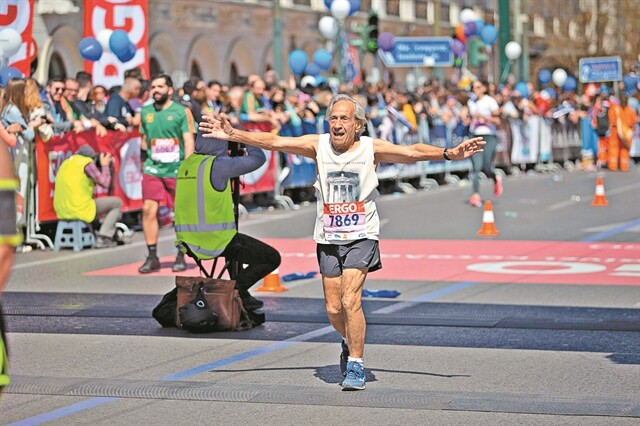
“The most moving moment is always when I finish the Marathon. It’s an indescribable moment! I love it when I enter the stadium, above all when I enter the one in Greece, the Panathenaic Stadium.”
“It’s a temple, all athletes need to kneel there. There are no stadiums with that kind of marble in the world. In other countries, we run to skyscrapers and apartment buildings,” the 90-year-old Greek marathon runner noted.
90-year-old Greek Marathon runner Stelios Prassas loves life
Prassas has a holistic philosophy to health and fitness. In terms of his diet, he mainly eats legumes and vegetables, and very little meat.
He has always been an active person, and he has never exercised with a trainer, rather he listens to “what my body and my heart tell me. My body gives me the ability to be in the stadium and run eight to 10 km (five to six miles) every day at 90.”
“A person must do what he does because he loves it very much,” the athlete stressed.
“The moment I go to the stadium to work out, I feel great love that fills my heart. I feel so much happiness when I am inside the stadium,” he continued.
Prassas, who owns a store in the Athenian neighborhood of Vyronas and is the head of his family, began running as an adult after a friend asked him to come along with him for a run.
“I like what I do very much. I started running marathons at 59,” Prassas stated. His love affair with running has never burnt out.
Yet his love for his wife is even stronger. “My wife’s love is indescribable. She is a heroine of Greece.”
The athlete does not think about the end of his life, rather, he prefers to enjoy each day he is on this earth.
“I have never been afraid of death, I have never thought of it, and it has never passed through my mind.”
“I want all young people to be happy and to enjoy their lives because we are all impermanent, no one will stay here forever,” Prassas stressed.
(11/09/2021) ⚡AMPby Anna Wichmann
Athens Marathon
The Athens Classic (authentic) Marathon is an annual marathon road race held in Athens, Greece, normally in early November. The race attracted 43.000 competitors in 2015 of which 16.000 were for the 42.195 km course, both numbers being an all-time record for the event. The rest of the runners competed in the concurrent 5 and 10 kilometers road races and...
more...Five most common running pains and how to fix them
Running can sometimes lead to aches and pains due to its repetitive nature, but that doesn’t necessarily mean you have to suffer. Here’s a rundown of five common conditions you might experience as you accrue mileage — and how to heal them or even avoid them altogether.
1.- Runner´s Knee
Patellar tendonitis earned its “Runner’s Knee” moniker because it’s so common — for runners, that is. It’s essentially swelling in the tendon, either above or below the kneecap, though most experience swelling and pain below. “It’s usually from the hip or ankle, from a biomechanics standpoint,” says Nashville, Tennessee-based sports doctor and running specialist, Jesse Riley, DC, MS. “I’ll first check to see if the ankle or hip might be stiff, because if another joint like the ankle isn’t handling the impact, the knee is taking a lot of that load.”
Skip it: Avoid running too much, too soon. “If there’s not enough endurance in the tissues, you’re more than likely going to experience joint pain,” Riley says. “Sometimes a runner may not be doing enough strength training, too.”
Be sure to hit the gym at least twice per week, to strengthen quads, hamstrings and calf muscles. “It’s also important to run with proper form. If you’re not soft or agile on the ground,” that also leads to inflammation.
Heal it: “Back off your volume for at least two weeks,” Riley says. “That will change the amount of impact you’re putting on your joint.” (Riley also notes that how much someone should ease up depends on the individual injury. “If someone can’t tolerate moderate walking for example, I advise complete rest.”
Riley also recommends foam-rolling the quads and hip flexors and stretching the ankles, to loosen the surrounding areas and release stress on the knee joint.
2.- Plantar Fasciitis
“It’s usually known now by its modern name: Plantar fasciopothy, and it’s basically an overloading of the tissue at the bottom of your foot,” Riley says.
Poor form can be a common cause. “I also check to see how well someone can balance,” Riley says. “If you can’t balance very well on one leg, for example, the tissues work extra hard to keep you from falling over while running.”
Skip it: Add balance moves to your strength routine. “Integrate single-leg exercises, like one-legged deadlifts, or practice balancing on one foot,” Riley says.
You can also work on improving your cadence. “Shortening your stride can help improve your form and decrease the load on your feet,” Riley says. “The typical recommendation is 160–180 steps per minute.”
Heal it: First, reduce your running volume (rest), and heat and ice as needed. Riley also recommends rolling a lacrosse ball under your foot to boost circulation and speed healing. “Ankle stretches and building calf endurance through calf raises can also help reduce stress on the area,” Riley says.
3.- Shin Splints.
“Most people feel these on the outside of the shin, which is the tibialis anterior muscle,” Riley says. “It can sometimes get inflamed from being overloaded or simply overlooked.”
This is a case when it’s especially important to visit your doctor to rule out a stress fracture.
Skip it: “There’s often not one definitive cause,” Riley says. But running with proper form and cadence (i.e., a shorter stride) can help keep shin splints away. You can also improve your balance to reduce load on the muscle, by performing single-leg exercises in the gym, and boost muscular endurance by tapping your toes.
Heal it: Stretching the muscle between runs can help you feel better. Practice pulling the toes away from your body. “It’s also good to foam-roll the muscle, to bring blood flow to the area.”
You can run with shin splints — depending on the severity of your pain. “It’s still a good idea to play with your mileage to find what works. And if you’re limping, it’s best to slow down to a walk until you’re feeling better,” Riley says.
4.- It Band Symdrome.
Much like other running injuries, this one relates to overuse and resulting inflammation. “It usually presents as a hip or knee issue — perhaps an ankle isn’t mobile enough, so the knee turns inward,” Riley says. “Often the vastus lateralis muscle (which runs along the side of the thigh and is the largest of the quadricep group) fires extra hard to stabilize the knee and becomes overworked. It can feel like it’s always tense.”
Skip it: There can be multiple causes, so your best bet is to ensure all of your joints are mobile and working properly. Riley also recommends incorporating balance exercises and minding your form as you run.
Heal it: You’ll need to see a doctor or mobility specialist to first determine what’s causing your IT Band pain. Treatment is much like what you’d do to prevent issues: Once you determine the cause, strengthen your running muscles as necessary.
You can also foam-roll your muscles, but avoid rolling your IT band, itself. “It doesn’t feel good, and doesn’t achieve anything,” Riley says. Instead, roll along the front of your quad: Tilt your body forward so you can bring blood to the area.
5.- Hip Pain.
Runners often experience hip pain simply from muscles feeling tight, and the hips can especially feel the effects of repetitive motion. The problem can also be an impingement (from too-tight muscles) or, often, bursitis — which is swelling of a bursa: a fluid-filled sac designed to decrease friction in the joint.
Skip it: “Mobility is your best adversary,” Riley says. “Along with stability. Strength training can really help protect your hips.” Riley recommends hitting the gym three times/week if you’ve ever had hip pain and performing moves like hip thrusters, lunges (with a longer stride, to focus on hips) and isometric holds that allow you to build muscular endurance.
Heal it: You’ll first need to pinpoint the cause of your pain to determine treatment. But usually you’ll need some time to rest and then modify your training. You may need to alter your running technique or adjust your volume.
You may also benefit from modalities like dry needling, depending on the nature of your injury, which can calm the surrounding area so as not to cause further irritation to the joint.
(11/09/2021) ⚡AMPby Lara Rosenbaum
A shoe built for all distances - The New Balance 860v12
The New Balance Fresh FoamX 860v12 is a go-to shoe that you can rely on for daily comfort over all distances. The new version has been designed to keep up with the demands of the everyday stability runner.
This shoe is intended for runners who overpronate, and its light and supportive features are what keep runners coming back year after year.
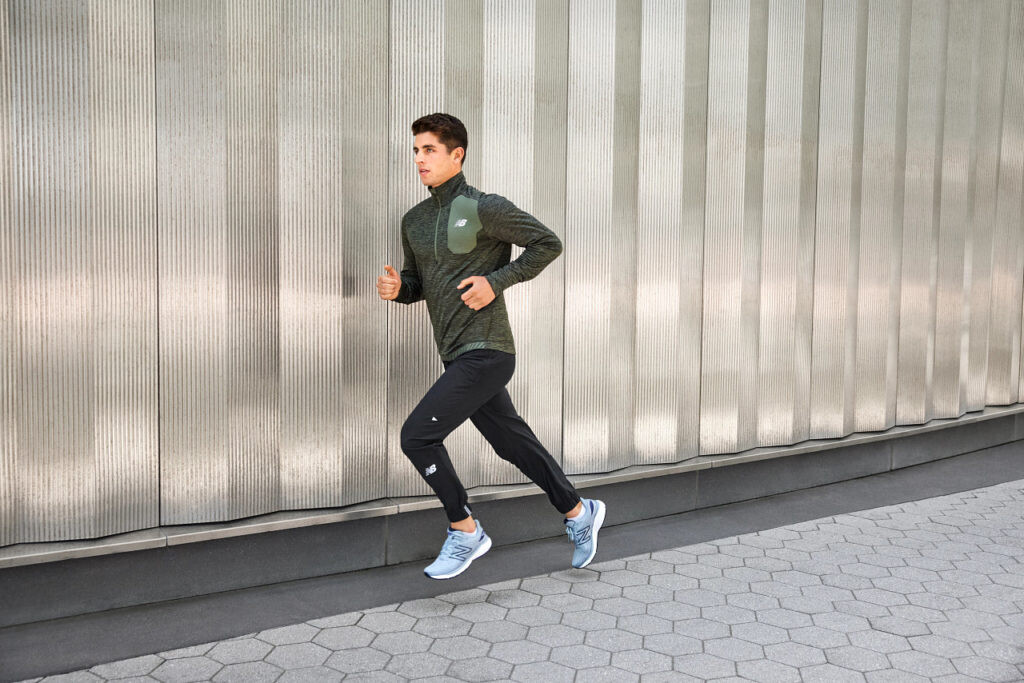
12 versions of success
The original 860 was released 11 years ago it was intended for all types of exercise. Now in its 12th edition, it still has its signature performance fit with added support. What’s changed the most in the 860v12 since the original edition? The shoe now features a seamless and engineered upper with strategic embroidery for support and durability.
What’s remained the same is the stiff medial posting in the midsole, so you can complete your run with the maximum level of support on each step.
What’s new?
The v12 is a step up from v11 with the integration of strategic support into the upper. The shoe also features reflective accents on the upper to catch the light while running in the dark.
The shoe has a full-contact outsole, which features New Balance’s softest foam yet, Fresh FoamX. The shoe is relatively firm with a layered midsole, for those who like a traditional stability shoe with lightweight cushioning.
(11/08/2021) ⚡AMPby Marley Dickinson
Four Fun Track Workouts for Beginners
Although many believe a running track is reserved for track stars, it's actually the perfect place to learn to run, increase your speed, and get away from the repetition of running on the roads.
It's a little like stepping into a yoga studio, as you don't have to contend with honking cars, curious dogs or traffic lights. Tracks are flat and predictable; this makes it easy to hone your pacing skills. The synthetic surface provides a soft, forgiving landing, reducing the impact forces on your muscles and joints.
Before you start running in circles, here are a few things you need to know.
DistanceA standard track includes 4 to 8 lanes, and measures 400 meters around in the innermost lane.
DirectionThe direction of running is usually counterclockwise, but it's best to check the track rules, as some tracks rotate the direction of running daily.
EtiquetteLike driving on an expressway, the inner lane is used for runners who are performing speed workouts. The outer lanes are for slower traffic (walkers and easy running)
Now that you're up to speed, try to tackle these fun track workouts.
Classic Quarters
There's no better way to get to know a track than to run this workout. It ebbs and flows between hard and easy, and boosts your speed and fitness.
Warm-up: Jog four laps (1 mile)
Repeat 4 times:
HARD: Run one lap at a hard, but controlled effort. The goal is to push hard, but not so hard that you can't finish the workout.
EASY: Take one lap to recover by walking until you catch your breath. Jog easy the rest of the way.
Cooldown: Run easy for one lap and walk one lap.
100s
A short, powerful workout to improve your running form.
Warm-up: Jog four laps
Break the track into two parts, the straight-a-ways and the corners.
Sprint the straight-a-ways (100 meters), and walk the corners to recover. Repeat this for 1 mile.
Cooldown: Walk one lap.
Banana Relays
This is a fun, social workout that builds community, speed and stamina. All you need is a banana (aka baton) and a teammate.
Warm-up: Jog four laps
Run two laps (800 meters or about a half-mile) at a comfortably hard effort (not hard, not easy) and, upon finishing, pass the banana to your buddy.
While he or she is running two laps, walk to the start to recover.
Repeat this four times for a total of 2 miles.
Cooldown: Jog two laps at an easy effort with your buddy.
Warm-up: Jog four laps
1: Run one lap at a hard, but controlled effort. Walk while you catch your breath, then jog until you reach one lap.
2: Run two laps at a hard, but controlled effort. Walk while you catch your breath, then jog until you reach one lap.
3: Run three laps at a hard, but controlled effort. Walk while you catch your breath, then jog until you reach one lap.
2: Run two laps at a hard, but controlled effort. Walk while you catch your breath, then jog until you reach one lap.
1: Run one lap at a hard, but controlled effort. Walk while you catch your breath, then jog until you reach one lap.
Cooldown: Walk one lap.
(11/08/2021) ⚡AMP
by Jenny Hadfield
John Korir and Natasha Cockram prevail in Los Angeles Marathon
John Korir of Kenya made a break with 7 miles remaining to win the 36th Los Angeles Marathon on Sunday.
Natasha Cockram of Wales won the women’s race with a similar strategy.
The 24-year-old Korir, who was second here two years ago, finished in 2 hours, 12 minutes, 48 seconds, nearly six minutes better than countryman Edwin Kimutai (2:18:01). Eritrea’s Amanuel Mesel Tikue finished third in 2:18:17.
Korir’s older brother, Wesley Korir, is a two-time Los Angeles champion.
“Now our family is so happy today,” John Korir said. “This is three times our family winning this race. We are happy now.”
Cockram won after placing 13th in the London Marathon on Oct. 3. She ran the 26.2-mile Stadium to Stars course in 2:33:17.
“I wasn’t sure how my body was going to be feeling after London,” Cockram said. “About halfway, I felt sure and comfortable. I kind of wish I’d gone earlier.”
Kenya’s Antonina Kwamba was second in 2:37:36, edging Russia’s Nina Zarina by a second.
Korir and Cockram each won $6,000. The total prize purse was $40,000.
The race traditionally takes place in March. It returns to that spot next year.
(11/08/2021) ⚡AMPby Associated Press
Los Angeles Marathon
The LA Marathon is an annual running event held each spring in Los Angeles, Calif. The 26.219 mile (42.195 km) footrace, inspired by the success of the 1984 Summer Olympic Games, has been contested every year since 1986. While there are no qualifying standards to participate in the Skechers Performnce LA Marathon, runners wishing to receive an official time must...
more...Five tips to stay motivated at an older age
What is the key to running well and enjoying it as you age?
I imagine this intriguing question is asked and answered often by senior runners all over the world. As we leave our youth and the physical abilities that accompany it behind, how do you keep running in a healthy and enjoyable way?
These days there are so many runners who are in their forties and beyond. Every one of them, of course, is an individual, and what works for them may be different to the next person. Being not far off 50 now, and eight years into retirement from life as an elite athlete, I often ask myself these questions. If anyone has any good answers, I’m all ears!
The recent London Marathon on 3 October incorporated the inaugural Abbott World Marathon Majors Wanda Age Group World Championships. This race brought together the world’s best marathon runners over the age of 40. The winners of the various categories were deservedly lauded for becoming world champions, and the sheer energy and enthusiasm of all these senior runners was quite something.
After the race, I was fortunate and humbled to meet Koichi Kitabatake (87) from Japan. A relative newcomer to the marathon, having taken it up at age 78, he was a picture of good health. The sight at these championships of fit, healthy and energetic role models left me feeling incredibly inspired.
From coaching senior runners and from my own, admittedly limited experience of ageing, I offer up a few tips which might answer the questions I posed above.
1 Less is more
As we age, recovery takes longer and we may be more prone to injuries as our bodies get older. To maintain the cycle of super-compensation, in which training stimulates the adaptation that makes you fitter and faster, less training and more rest is often necessary.
2 Set new goals
Looking forwards and creating fresh, exciting challenges is helpful for finding motivation. They need not be outcome goals – process goals are a practical and useful tool for organising a sustainable training routine.
3 Leave your young self behind
Comparing your times and achievements to your younger self risks leaving you feeling disappointed. I spent several years unable to accept the inevitable passage of time – and none of that was helpful!
4 Seek out variety and enjoyment
Making running something you look forward to, a sociable activity with your friends, and overall a positive experience will certainly help with motivation. Trying races you’ve never run before, running on a different surface, or in a new place, are all ways to refresh your routine and keep it interesting.
5 Just keep moving
During difficult times when you can’t or don’t want to run, simply doing some physical activity is key. Once you become inactive, it’s much more difficult to restart. Walking, or a mixture of running and walking, cycling, hiking, swimming… any activity will keep your fitness going.
(11/08/2021) ⚡AMPby World Athletics
How the Dibaba sisters from Ethiopia became the fastest family on earth
Ethiopian distance runner Tirunesh Dibaba made history at the 2008 Beijing Olympics when she became the first woman to win gold in both the 5,000-metre and 10,000-metre races. She defended her gold medal title in the 10,000 metres at the 2012 London Olympics, becoming the first woman to win the event at two consecutive Olympics.
She was inspired by a family of runners. In fact, she and her sisters have been amazing in the field of distance running. The Dibaba sisters — Tirunesh, Genzebe, Anna, and Melat — are the only siblings in recorded history to hold concurrent world records, and they are a fiercely competitive family from a humble background.

They were raised in a round mud hut in the Ethiopian capital, Addis Ababa, without electricity. Their parents were subsistence farmers who grew wheat, barley and teff. As a matter of fact, the Dibaba siblings are seven in all, and all of them run. Tirunesh, however, is the most decorated, having three Olympic gold medals. She had wanted to enroll in school but opted for the Corrections (Prisons Police) sports club.
At age 15, she debuted internationally on Ethiopia’s junior squad at the 2001 world cross-country championships, where she placed fifth. She continued with junior-level silver medals in cross-country and on the track in 2002. She won the world junior cross-country title in 2003, set a 5,000-metre junior world record and won gold in the 5,000 metres at the International Association of Athletics Federations (IAAF) world track and field championships, making her the youngest-ever world champion in her sport.
Her sister, Genzebe, is not doing badly in sports. Ejegayehu, who is their older sister, is also an Olympian who won silver from Athens. Their cousin, Derartu Tulu, was the first Black African woman to win Olympic gold in the 1992 games. She won another Olympic gold medal in Sydney in 2000.
“It’s not a stretch to say they are the world’s fastest family”, Ato Boldon, NBC’s track analyst, told Vogue in 2016. The sisters have remained a household name in Ethiopia, a country that has produced some of the world’s greatest runners, alongside Kenya.
The mother of the Dibaba sisters told Vogue that the siblings are successful thanks to the environment they were raised in, especially the ready supply of milk they get from the family cows. According to Vogue, author David Epstein has said that much of Ethiopia and Kenya lies in an altitude “sweet spot” high enough to cause physiological changes but not so high that the air is too thin for hard training.
The runners’ feat is also attributed to their diet — especially teff rich in iron and calcium — and their “small lightweight frame”. The Dibaba sisters have the body type good for sports, analysts say. Boldon said in 2016 that if one compares the sisters to a car, they would be a Ford Focus with a Ferrari engine.
The Dibabas are good at sports but they don’t really like watching sports. They prefer movies, especially Amharic films, said Tirunesh, who in 2008 married fellow track-and-field Olympic medalist Sileshi Sihine in a nationally televised wedding ceremony.
And just like other successful athletes, the Dibabas have invested their monies back into their communities. The sisters, alongside their in-laws, are real estate moguls owning several buildings in Addis Ababa. Still, the sisters continue to shine brightly in the sports world.
(11/07/2021) ⚡AMPby Mildred Europa Taylor
Molly Seidel breaks U.S. record at New York City Marathon – with two broken ribs
Olympic bronze medalist Molly Seidel ran the fastest time ever by an American woman at the New York City Marathon on Sunday, shattering the previous course record by more than a minute.
Then, a little more than an hour later, she revealed she had done so with two broken ribs.
"It started hurting later in the race, like badly," Seidel said. "But I didn't feel like it was messing up my stride or anything. I went all out with what God gave me today. I think I made the most of the situation I was in."
Seidel, 27, declined to specify how she suffered the injury but said it happened about a month ago. And up until two weeks prior to Sunday's race, she said she was in so much discomfort that she considered withdrawing from the event altogether.
After what she described as "frank" conversations with her coach and agent, the Wisconsin native felt healthy enough to give it a go. She credited a team of physical therapists for aiding in her recovery and said she was grateful that she sustained the injury so far in advance from the race.
"(The broken ribs) definitely hindered training a little bit, but it was manageable for the race," Seidel said.
"There's not a whole lot you can do with that. You kind of just wait for it to heal. Luckily it happened far enough out from the race – it was about a month out – so it gave me the time to be able to heal."
Seidel ended up not just running and finishing the race – which was just the fourth marathon she's ever run – but also placing fourth with a time of 2:24:42.
The previous course record had been held by Kara Goucher, who finished in 2:25:53 in 2008.
"I actually didn't know until I crossed the line, that that was what had happened," Seidel said of breaking the American record. "I'm just so incredibly honored. There are so many good women who have run on this course. I think it's really a testament to the women who were in this race, that I was able to just kind of hang onto that group. Obviously I fell off from the main pack, but kind of just kept pushing."
Peres Jepchirchir ended up pulling away to winSunday's race, which marked the 50th running of the New York City Marathon. Jepchirchir and Seidel both finished on the podium at the recent Summer Olympics in Tokyo, with the Kenyan winning gold and the American taking bronze.
Seidel said one of the reasons she chose to compete in New York, despite her injury, was the promise of being able to celebrate the result with her family members, who had to watch her Olympic performance from home due to COVID-19 protocols at the Games.
A reporter asked Seidel how she planned to celebrate.
"Oh my God," she said, "I hope there's a beer waiting for me at the hotel."
(11/07/2021) ⚡AMPTCS New York City Marathon
The first New York City Marathon, organized in 1970 by Fred Lebow and Vince Chiappetta, was held entirely in Central Park. Of 127 entrants, only 55 men finished; the sole female entrant dropped out due to illness. Winners were given inexpensive wristwatches and recycled baseball and bowling trophies. The entry fee was $1 and the total event budget...
more...Shalane Flanagan saved the best for last, finishing the New York City marathon in 2:33:32
It’s not uncommon for elite runners to take as many as six weeks off from running after a grueling marathon.
Then there is Shalane Flanagan, 40, the New York City Marathon champion in 2017, who did the opposite. With all six of the world’s major marathons packed into as many weeks this fall because of the coronavirus pandemic, Flanagan saw an opportunity to do something extraordinary. She decided to run them all — Berlin, London, Chicago, Boston, Tokyo and New York — in under three hours each.
Flanagan, who is retired from professional running, traveled roughly 10,000 miles round-trip with her toddler son for Berlin and London. She ran Chicago and Boston on back-to-back days. Organizers ultimately canceled the Tokyo race, but Flanagan still ran a marathon on her own near her home in Oregon two weeks ago to make up for it. Her slowest time was in Chicago, which she completed in 2 hours 46 minutes 39 seconds. She completed three of the races in under 2:40, including an extremely fast 2:35:04 in London.
But she saved the best for last, finishing in 2:33:32 in New York.
(11/07/2021) ⚡AMPTCS New York City Marathon
The first New York City Marathon, organized in 1970 by Fred Lebow and Vince Chiappetta, was held entirely in Central Park. Of 127 entrants, only 55 men finished; the sole female entrant dropped out due to illness. Winners were given inexpensive wristwatches and recycled baseball and bowling trophies. The entry fee was $1 and the total event budget...
more...Kenyan duo of Peres Jepchirchir, Albert Korir win 50th edition of New York City Marathon
Peres Jepchirchir pulled off a historic double Sunday.
Three months after she won gold at the Summer Olympics in Tokyo, Jepchirchir turned around and won the 50th edition of the New York City Marathon, emerging from a pack of three in the final mile to cross the finish line in 2 hours, 22 minutes and 39 seconds.
The 28-year-old Kenyan is the first woman to win Olympic gold in the marathon, then win a major fall marathon thereafter.
Meanwhile, countryman Albert Korir won the men's race in dominant fashion, with a time of 2:08:22.
While Korir separated himself from the rest of the field by Mile 20, the women's race proved to be much tighter, with three women neck-and-neck entering the final mile. Viola Cheptoo ended up finishing second, followed by Ababel Yeshaneh of Ethiopia in third.
Cheptoo, the younger sister of retired American marathoner Bernard Lagat, shared a moment with her brother after the race; Lagat was working as a commentator for ESPN's television coverage of the event.
Molly Seidel, who won a surprising bronze at the Tokyo Olympics over the summer, was the highest-placing American in the women's field. The 27-year-old finished fourth with a time of 2:24:42.
Elkanah Kibet, who also placed fourth, was the top American finisher on the men's side with a time of 2:11:15.
Sunday's race marked the 50th running of the New York City Marathon. The event initially consisted of 127 people running laps around Central Park in 1970, with a $1 entry fee. It has since blossomed into one of the largest and most iconic marathons in the world.
Reigning Paralympic champion Marcel Hug of Switzerland dominated the men's wheelchair race, besting the rest of the field by more than six minutes with a time of 1:31:24. Madison de Rozario of Australia also followed up a Paralympic gold with a win in New York, cruising to victory in the women's wheelchair race in 1:51:01.
(11/07/2021) ⚡AMPTCS New York City Marathon
The first New York City Marathon, organized in 1970 by Fred Lebow and Vince Chiappetta, was held entirely in Central Park. Of 127 entrants, only 55 men finished; the sole female entrant dropped out due to illness. Winners were given inexpensive wristwatches and recycled baseball and bowling trophies. The entry fee was $1 and the total event budget...
more...Victor Kiplangat takes debut win in Istanbul, Sheila Jerotich comes from behind in stunning sister act
Running his debut at the classic distance Victor Kiplangat became the surprise winner of the N Kolay Istanbul Marathon. The 21 year-old Ugandan, who is a training partner of Olympic 5,000 m Champion and world record holder Joshua Cheptegei, clocked 2:10:18 after battling with three other contenders in the final mile of the race. Kenya’s Robert Kipkemboi took second with 2:10:23 while Solomon Mutai of Uganda was third in 2:10:25.
There was even more drama in the women’s race: With just 500 metres to go Kenyan Sheila Jerotich came from behind to then triumph on Istanbul’s Sultanahmet Square in 2:24:15. To make it even more stunning: The runner the 32 year-old overtook shortly before the finish was her sister, Jackline Chepngeno. While she was the runner-up in 2:24:21, Ethiopia’s Ayantu Abdi followed in third place with 2:24:45. It is most likely unique that sisters took the first two places in a major international marathon. The men’s and women’s winners receive a prize purse of 35,000 Dollar each.
Including events at shorter distances a total number of over 35,000 runners entered the race. With this figure the N Kolay Istanbul Marathon was one of the biggest races worldwide since the beginning of the pandemic. In view of the Covid 19 situation strict hygiene regulations were in place. The N Kolay Istanbul Marathon is a World Athletics Elite Label Road Race.
Men’s Race
Starting on the Asian side of Istanbul the course has a significant drop once it reaches European territory within the first five kilometres. Despite this drop and good weather conditions the pace was slow. The favorites opted for a tactical race instead of following a pace which was set to break the Turkish allcomers’ record of 2:09:35. A group of 17 men then passed the half way mark in 65:21.
There was no proper attack until very late in the race. Runners knew about the steep climb up to the finish that waited for them in Istanbul’s historic centre and held back. Records were out of reach, but a thrilling race for victory developed.
It was Robert Kipkemboi who finally started a move with around five kilometers to go. Fellow-Kenyan and defending champion Benard Sang lost contact to the group and when the 38th kilometer was covered in 2:53 course record holder Daniel Kibet could not follow as well. He had won the N Kolay Istanbul Marathon in 2019 with 2:09:44. Four runners were still in contention when the climb began with around a mile to go: Kenyans Robert Kipkemboi and Moses Kemei as well as Ugandans Victor Kiplangat and Solomon Mutai. Surprisingly it was the debutant who took the lead and pushed hard all the way up the hill. Kiplangat, who has a good half marathon PB of 59:26, was rewarded with his biggest career win.
“I am thrilled to have won my debut marathon. But I knew that I was in good shape. I train in very hilly terrain and was confident that I would be strong in the final section,“ said the 21 year-old winner, who trains with Joshua Cheptegei in Kapchorka in Uganda at an altitude of around 2,000 m. “Joshua is my idol. And he helps me a lot,“ said Victor Kiplangat, who thinks that he has the potential to run 2:05 to 2:06 in his next marathon in spring. “If I achieve such a time on a flat course I hope to get selected for the World Championships’ marathon next summer. And then I would love to come back to Istanbul to defend my title.“
While the first four finishers ran a negative split which is very rare in Istanbul due to the nature of the course, Turkey’s best runner produced a fine performance as well: Hüseyin Can finished 14th with 2:16:01 and broke the national record for under 23 year-olds.
Women’s Race
In contrast to the men the women ran a blistering pace during the first part of the race. A group of ten runners passed the 10k point in 32:48 which pointed towards a 2:18:30 finishing time. Three years ago Kenya’s World Champion Ruth Chepngetich established a sensational course record of 2:18:35. However the leaders could not hold on to this sort of pace. They reached half way in 70:19 and then passed the 30k mark in 1:40:48.
Four runners were left in the leading group shortly after 30k: Sheila Jerotich, Jackline Chepngeno, Ayantu Abdi and Judith Cherono of Kenya. Cherono soon dropped back and then it was Jackline Chepngeno who moved clear. At 40k she was already 22 seconds ahead and looked certain to win the race. But during the uphill stretch Sheila Jerotich came closer and closer and finally overtook her sister with just 500 metres to go.
“I am not disappointed at all. My aim was to finish on the podium and I have achieved that,“ said Jackline Chepngeno, who improved her PB by 17 seconds with a time of 2:24:21. It was only then when she revealed that it was her sister, who had stopped her from winning the race. „We are best friends, we train together and we are actually sisters. Since we are both married we have different names.“ While Sheila Jerotich, who improved her PB from 2:26:06 to 2:24:15 in Istanbul, can not speak English her sister translated for her: “I am really happy to have won the race. Next year we both want to come back to Istanbul.“
Results
Men:
1. Victor Kiplangat UGA 2:10:18
2. Robert Kipkemboi KEN 2:10:23
3. Solomon Mutai UGA 2:10:25
4. Moses Kemei KEN 2:10:28
5. Benard Sang KEN 2:10:59
6. Daniel Kibet KEN 2:11:09
7. Mengistu Nigatu ETH 2:11:15
8. Chalachew Tiruneh ETH 2:11:20
Women:
1. Sheila Jerotich KEN 2:24:15
2. Jackline Chepngeno KEN 2:24:21
3. Ayantu Abdi ETH 2:24:45
4. Judith Cherono KEN 2:27:23
5. Fetale Tsegaye ETH 2:28:53
6. Zinash Debebe ETH 2:29:45
7. Emily Kipchumba KEN 2:30:25
8. Betty Chepkwony KEN 2:30:28
photo credit:Spor Instabul
(11/07/2021) ⚡AMPby Race-News-Service
N Kolay Istanbul Marathon
At the beginning, the main intention was simply to organise a marathon event. Being a unique city in terms of history and geography, Istanbul deserved a unique marathon. Despite the financial and logistical problems, an initial project was set up for the Eurasia Marathon. In 1978, the officials were informed that a group of German tourists would visit Istanbul the...
more...Ugandan and Kenyan claim wins at Istanbul Marathon
The only intercontinental marathon in the world was held in three categories: the 42,195 meters run, as well as the 15-kilometre and eight-kilometre public run.
Uganda's Victor Kiplangat and Kenya's Sheila Jerotich have clinched the 43rd Istanbul Marathon.
Kiplangat, 21, won the men's title, while Jerotich, 32, claimed women's race in the annual road running event on Sunday that hosted 54 elite athletes.
Both athletes each received a $35,000 prize.
The only intercontinental marathon in the world was held in three categories: the 42,195 meters (138,435 feet) run, as well as the 15-kilometer (9.3 miles) and eight-kilometer public run.
The concept of running from Asia to Europe, which was first brought up by Tercuman Newspaper in 1973, was realized in 1979 with a group of German tourists.
The Istanbul Marathon, which is included in the "Gold Label Road Races" of the World Athletics Association (IAAF), is among the most popular marathons in the world.
(11/07/2021) ⚡AMPN Kolay Istanbul Marathon
At the beginning, the main intention was simply to organise a marathon event. Being a unique city in terms of history and geography, Istanbul deserved a unique marathon. Despite the financial and logistical problems, an initial project was set up for the Eurasia Marathon. In 1978, the officials were informed that a group of German tourists would visit Istanbul the...
more...Powered by plants: elite athletes on the impact of a vegan diet
Changing what you eat might not seem like an obvious solution to environmental sustainability. It doesn’t have the immediacy of plastic reduction or avoiding fossil fuels. But there is increasing evidence that a shift to a plant-based diet can hugely reduce an individual’s impact on the climate, primarily with less energy required in food production from meat and dairy products.
A study from the University of Oxford found that people can cut their carbon footprint from food by up to 73% by switching to a vegan diet. Furthermore, the reclaiming of global farmland used for agriculture would revitalise wildlife conservation and hugely reduce extinction.

All of which makes fascinating reading for any ecological-minded athlete. But what are the implications on athletic performance? Nutrition is a fundamental element of performance at the highest level, so is it possible to help the environment and still succeed as an elite athlete on a vegan diet?
More international athletes are making the change and are proving that it is.
Kaylin Whitney, who ran world U18 100m and 200m bests in 2014, is one such athlete who is now relying upon plants to power her to international success. She switched to a vegan diet in the lead up to the US Trials and Tokyo Olympics, while also transitioning to the 400m from the short sprints.
Whitney reached her first Olympics and left with two medals: gold from the women’s 4x400m having run the opening leg in the heats and bronze in the mixed 4x400m where she ran the third leg.
The US sprinter followed in the vegan spike marks of Morgan Mitchell, who was a member of the Australian 4x400m quartet that finished seventh at the Rio Games. Mitchell has since started to make her mark in the 800m, representing Australia at the Tokyo Olympics on a plant-based diet.
Middle distance runner Andreas Vojta has been representing Austria in major championships for over a decade, including the 2012 Olympic Games, five European Championships and six European Indoor Championships.
He first turned to veganism in May 2018, driven by a passionate belief in animal rights and addressing climate change. “I went vegan for ethical and environmental reasons,” he says. “I was learning more and more about animal agriculture and quickly found out that I could not unite my ethical views with the cruel industries I was actively supporting every day. So, I aligned my morals with my actions and went vegan.
“I suddenly felt like I was doing the right thing, which really frees up your mind. The least I could do was go vegan for the animals, our planet and also my own body. I actually went vegan without any considerations from the health side, but I experienced some benefits from a health and performance standpoint. I started feeling a faster recovery after intense workouts and competitions and also needed less sleep.”
His shift aroused the curiosity of his fellow athletes, particularly as he has set his personal bests over 3000m (7:49.75) and 5000m (13:24.03) and a national 5km road record (13:48) while vegan.
“Even though most people know what veganism is, they don't have a lot of practical experience with it and are curious to know how it works, especially as an athlete,” he explains.
“Like every change in your life, it might be unfamiliar the first weeks, but then it just becomes part of your everyday life. Nearly everyone I talk to already understands the massive ethical issues that come along with animal farming, so as a next step I am trying to help and inform everyone who wants to know how they can easily integrate a vegan lifestyle into their lives.”
For ultra runner and international masters age-group marathon runner Fiona Oakes, veganism has been a way of life since she was a child. The British runner holds the women's world record for the fastest aggregate time to complete a marathon on all sevens continents (23:27:40). But it is through her role as co-founder of the running club Vegan Runners where she has drawn most attention to veganism.
“I had qualified for the championship start of London (Marathon) in 2004 and realised it was an amazing opportunity to promote veganism in a positive way to a captive audience who were already invested in their health and wellbeing,” she says.
“It was an opportunity to wear a 'billboard' promoting the word vegan and run through the closed roads of the capital while spectators, press and media looked on. We went for it, and this is how Vegan Runners was born.”
Since then, the club has grown exponentially and is now the UK’s fastest growing running club, with nearly 3000 members.
“As the years have passed, I have obviously sought and gained much more information on how veganism not only benefits the animals but the planet, the environment, individual and global health. The real beauty is I am constantly learning more about its comprehensive positive universal impact on a daily basis.”
Her most recent project is seeing her create a new endurance event, the Running for Good Ultra, to champion positive change, including environmental sustainability.
“For me, my running has always been about building a positive platform from which to speak about and promote an issue which I am passionate about," she says. "That issue being the positivity of veganism for so many reasons.
“I honestly believe that having an 'ulterior' motive – or at the very least an 'extra' motive – rather than just running races for times, trophies and medals, has enhanced my ability to keep motivated and inspired over many years and to train hard and maintain focus.
“It's truly my belief that when you are out there either training or racing, the idea that there is a deeper reason and that others may be influenced or inspired by your presence, commitment, actions and achievements, is just the tonic you require to keep invigorated and excited at the prospect of your next run.”
For Oakes and many other vegan athletes, going green has become even more important than winning gold.
(11/07/2021) ⚡AMP2021 NYC Marathon: Weini Kelati, Drew Hunter win Abbott Dash to the Finish Line 5K
Two-time NCCA champion Weini Kelati smashed the event record at the Abbott Dash to the Finish Line on Saturday in Central Park.Kelati took the tape in 15:18, while indoor champion Drew Hunter won the men's race in 13:53.Kelati, who became a U.S. citizen in June, finished the race on a solo sprint to win her first U.S. title and finished six seconds faster than Molly Huddle's previous event-best mark.She also finished 29 seconds ahead of runner-up Grace Barnett, a U.S. Olympic Trials finalist.It also marked the first U.S. road title for Hunter, who jumped into the lead with about 100 meters to go in Central Park.About 7,000 runners registered for the Abbott Dash to the Finish Line 5K, a sort of warmup to the 2021 TCS New York City Marathon on Sunday.The 3.1-mile race traverses part of the marathon course, starting near the United Nations Headquarters in Midtown East and ending at the marathon finish line in Central Park.
It was the largest field for an endurance race in New York since the 2019 marathon.It's also a USA Track and Field championship race and the field included five Olympians and 20 championship winners.
The race featured a $60,000 prize purse - the largest of any 5K race in the world.The Kelati and Hunter will each win $1,500 after crossing the finish line first.
(11/06/2021) ⚡AMP
Dash to the Finish Line
Be a part of the world-famous TCS New York City Marathon excitement, run through the streets of Manhattan, and finish at the famed Marathon finish line in Central Park—without running 26.2 miles! On TCS New York City Marathon Saturday, our NYRR Dash to the Finish Line 5K (3.1 miles) will take place for all runners who want to join in...
more...Rock ‘n’ Roll Savannah full marathon event cancelled due to bad weather
The Rock ‘n’ Roll full marathon has been cancelled in Savannah due to inclement weather.
The event will still hold the half marathon and relay event. All marathon runners will have the option of participating in the half marathon.
The official statement reads:

“Due to deteriorating weather conditions we have determined we cannot host the Rock ‘n’ Roll Running Series Savannah full marathon distance. The Rock ‘n’ Roll Running Series half marathon and relay will continue. All marathon participants will have the option to participate in the half marathon.
It may rain during the Rock ‘n’ Roll marathon Saturday in Savannah and concerns are flooding in about how the race may be impacted.
Flooded roads would not be ideal for marathon runners. Rock ‘n’ Roll Marathon organizers said they’ve diagnosed the possible problem areas and have plans to make sure it won’t affect the runners.
“The men and women that prepare the route are some of the best in the business, and they are prepared for multiple contingencies, they always are. I know they’ve worked with the city for tomorrow that if, should there be a point of the route that floods, they already have a plan to make it seamless so that there will be minimal impact. The runners won’t even notice it,” Savannah Sports Council Director Rob Wells said.
And not just the runners, the Savannah Police Department wants to make sure everyone is safe,
“18,000 runners are a lot of people to be on the roads. With those folks running on our course, if you accidentally find yourself on the course, please follow the instructions of the officers. We may have you stop past you and then we will get you off the course as quickly as we can,” Savannah Police Sgt. Jason Pagliaro said.
He went on to say the rain makes that even more of a problem, so he is asking drivers to also be extra careful this weekend and specifically on Saturday while the marathon is happening.
(11/06/2021) ⚡AMPby Tyler Manion
ROCK N ROLL SAVANNAH
The Rock ‘n’ Roll Savannah races has become a landmark event for the Hostess City of the South, featuring charming, scenic courses through the historic downtown district and southern hospitality at every turn. The marathon and half marathon courses are official! Look forward to a Saturday start in historic downtown Savannah at the intersection Bay Street and Bull Street, adjacent...
more...Four ex-Bachelor contestants to run the New York City Marathon
Here are The Bachelor fan favourites set to take the start line on Nov. 7.
Tayshia Adams
Adams was on the 23rd season of the Bachelor and the 16th season of The Bachelorette – where she stepped after the original bachelorette left the show early. This will be Adams’s first marathon, and she will be raising funds for the World Vision Foundation.
Zac Clark
Clark found love on the 16th season of The Bachelorette, getting engaged to Tayshia Adams. Clark will run the race with his fiancée in support of his Release Recovery charity, which aims to make mental health and substance abuse treatment available to underserved populations. Clark has battled with addiction in the past and since then has become a pretty serious marathoner, running 3:43 at the 2021 London Marathon.
Tyler Cameron
Cameron was a fan favourite on season 15 of The Bachelorette, having his heart broken as the runner-up. Cameron has transitioned into a marathon runner, most recently competing at the 2019 New York City Marathon (4:39).
Matt James
The former athlete and bachelor is no stranger to running. In an interview with Bachelor Nation, he said that running is his favourite way to stay in shape. He ran both the Chicago Marathon and New York City Marathon in 2019, alongside his best friend and fellow Bachelor star Cameron. Both James and Cameron will be competing in the marathon for the Andrea Cameron Foundation, which is named for Cameron’s mother, which awards scholarships to less privileged students.
(11/06/2021) ⚡AMPby Running Magazine
Thinking About Bailing During Your Long Run? Here Are 5 Things You Should Consider
Having a tough day? Whether you should persevere or pack it in depends on several factors.
If you’ve ever found yourself in the second half of a long run debating whether you should cut it short, you’re not alone. Mounting fatigue has a way of inducing that internal discussion among many runners.
Making the right decision for you can be tricky. On the one hand, you’re already really tired, and you have several miles to go; won’t mindlessly sticking it out put you in a hole and compromise your upcoming training and racing? On the other hand, isn’t one of the main points of long runs to get used to keep on keeping on when the desire to stop strikes?
As with most matters in running, the best answer is “it depends.” Here are five things to consider when a long run isn’t going well.
Are you having a specific bodily pain?
Discomfort—mild muscular fatigue or tightness, stomach distress, hot spots on your feet—is typical when you’re going long. These unpleasant sensations seldom merit changing your plan for the day.
A specific bodily pain is another matter. Sara Hall, the second fastest marathoner in U.S. history, says she cuts long runs short under only one condition—if she’s worried about an acute pain or tight spot that might become an injury if she runs through it.
A good rule of thumb here is to assess whether your troublesome spot is making you alter your running form. If so, being a disciplined runner in this instance means ending the run. Continuing with compromised form can not only lead to injury in the noticeable area, but also cause problems elsewhere from you compensating for the trouble spot.
If you don’t have a potentially injurious pain, why do you want to shorten this run?
Probably the most common reasons for considering cutting a long run short are that the run is a much greater mental struggle than it should be and that you feel much more tired than usual. All runners have days like these, thanks to the fact that we’re humans, not machines that can predictably perform the same at, say, 8 a.m. every Sunday.
“People only have so much willpower,” Mark Coogan, a member of the 1996 U.S. Olympic marathon team who now coaches the elite group New Balance Boston, tells Runner’s World. “Life circumstances are part of the training process, so you need to account for them.”
If your family or work life has been particularly stressful lately, a long run can be a good way to reboot mentally. But it can also seem like just another obligation, and slogging away to hit an arbitrary mileage goal for the day can further drain you psychologically. If the run you’re doing isn’t a crucial part of your training plan—more on that below—it’s probably not a good idea to spend lots of precious mental capital on it. Cut the run short, and don’t beat yourself up over doing so.
If you feel okay mentally, but physically worn down almost from the start, you’re probably best off cutting the run short, especially if you have an important race in the next week or two. If you don’t have a race you care about in the next week or two, first try slowing your pace. If doing so doesn’t help, and the run isn’t an especially important one, then it’s okay to go shorter than you planned.
After any of these scenarios, do two things. First, focus on maximizing recovery in the immediate aftermath of your run—consume carbs and protein within an hour of finishing, stay on top of rehydrating, and do some gentle stretching or walking later in the day. Take at least one more easy day than usual before your next challenging run.
Second, review your recent training. Have you upped your mileage and/or intensity lately? Was the long run too soon after a race hard workout? Are you trying to train like you “should” even though your non-running life is currently extraordinarily stressful? Are you following a cookie-cutter training plan that might not mesh with how you recover after long and hard runs?
“My training plans are always written in pencil,” Sara Slattery, who placed fourth in the 10K at the 2008 Olympic Trials and is now the head men’s and women’s cross-country coach at Grand Canyon University in Phoenix, tells Runner’s World. “Each athlete is very different in how they can handle training.”
Elite runners constantly adjust their training, and you’re allowed to as well. You might be someone who does best with three easy days before your toughest sessions, or who thrives on doing long runs on something other than a once-a-week schedule.
What are you training for?
Long runs have a place in all training programs. As legendary coach Bill Squires put it, they put the tiger in the cat.
But prioritizing long runs depends on what you’re training for. If you’re getting ready for a marathon, they’re arguably the most important aspect of your buildup. If your focus this season is a 5K PR, not so much. Slattery and Coogan agree that, if you’re not getting ready for a half marathon or longer, the cut-it-short threshold is lower than if you’re training for a long race. Gutting out a two-hour run when you’re overly tired will likely detract from the harder sessions, like kilometer repeats at 5K pace, that specifically prepare you for shorter distances.
That’s not to say that marathoners should do all long runs as planned regardless of how they feel. “Almost all marathoners already know how to persevere,” Coogan points out.
You don’t need to always prove to yourself you’re not a quitter. In his prime, Coogan trained with some of the best runners in the world of that era, such as former marathon world record-holder Steve Jones. Their typical long runs were 20 to 22 miles. “But if they were tired, they would often just cut off and say, ‘I am only doing 15 today.’ It’s being smart and knowing your body,” Coogan says.
If you’re training for a marathon, what is the goal of this particular long run?
Long runs for marathoners have two main types—putting in time on your feet at an easy to moderate effort, and harder outings that incorporate stretches at around goal marathon pace, or sometimes even a little faster. If you’re struggling on the first kind—a just-get-in-the-work long run—see if backing off the pace helps.
You don’t need to always prove to yourself you’re not a quitter. In his prime, Coogan trained with some of the best runners in the world of that era, such as former marathon world record-holder Steve Jones. Their typical long runs were 20 to 22 miles. “But if they were tired, they would often just cut off and say, ‘I am only doing 15 today.’ It’s being smart and knowing your body,” Coogan says.
If you’re training for a marathon, what is the goal of this particular long run?
Long runs for marathoners have two main types—putting in time on your feet at an easy to moderate effort, and harder outings that incorporate stretches at around goal marathon pace, or sometimes even a little faster. If you’re struggling on the first kind—a just-get-in-the-work long run—see if backing off the pace helps.
(11/06/2021) ⚡AMPby Runner’s World
Elite Canadian marathoners Dayna Pidhoresky and Rachel Cliff and ultramarathoner Mathieu Blanchard offer their tips to help runners fuel their training
Nutrition is one of the pillars of athletic performance, and its importance for runners cannot be understated. Put simply, if you want to run well day in and day out, you have to fuel your body properly so you can perform to your maximum potential in workouts and races. Elite Canadian marathoners Dayna Pidhoresky and Rachel Cliff and ultra-marathoner Mathieu Blanchard understand this all too well, and they sat down with Canadian Running to offer their advice to runners who want to fuel properly to maximize performance.
Blanchard explains that runners need to be very attentive to the fuel they are taking in, because it helps their bodies prepare for their training load. It also allows them to maintain intensity during workouts and races and assists in recovery afterward. “Poor nutrition could also make our tissues more inflamed,” he says, “and therefore cause injuries, or even cause gastric disorders during exercise and low energy.”
Cliff agrees and adds that any athlete competing at a high level is following a healthy, balanced nutrition plan. She says that means eating enough calories to support your training, as well as getting a good balance of carbohydrates, fats, protein, vitamins and minerals. As a predominantly plant-based athlete (though not fully vegetarian), Cliff says getting enough protein is her biggest struggle. To improve her intake, she tries to find little ways to include protein-rich foods into every meal and snack.
“A smoothie is a great way to get more protein in because you can add a lot of things like chia seeds, hemp hearts and yogurt,” she says. Cliff also really likes using the Näak Nutrition cricket protein powder, which provides a lot of protein with a low environmental footprint. And before you ask, Cliff says no, the cricket powder doesn’t taste like you’re eating bugs.
“That’s one of the things I love about Näak, that they find ways to sneak protein into food in a way that you can’t taste it, but it’s there,” she says. “The great thing about the cricket powder is that it’s a complete protein.”
Minh-Anh Pham, co-founder of Näak Nutrition, says they understand not everyone is ready to eat crickets yet, which is why the company has also developed a line of plant-based bars and powders. “Our mission is to make sport nutrition more sustainable,” he explains. “We want to give you maximum nutrition with a minimum impact on the environment.”
“I love this stuff,” says Pidhoresky. “The taste, texture, what they strive for as a company as they aimto be kinder to the environment…and if you are scared of crickets you can opt for the vegan protein powder or bars!”
Like Cliff, Blanchard also says adequate protein intake is a priority in his nutrition plan, and if cricket protein really isn’t your thing, he enjoys Näak’s vegetarian products, like their protein bars and powders, to help him meet his needs. Both the cricket products and vegetarian products have a smooth brownie texture, no gastro-intestinal discomfort and long-lasting energy. “I love the recovery protein powder because it is vegetarian and digests very well,” he explains. “I have never had an upset stomach like with other protein powders.”
When asked what nutrition advice she would give to recreational and competitive runners, Cliff says the most important thing is to be aware of your training volume and be really cognizant that you don’t put yourself into an energy deficit. “Don’t try to cheat your body out of the nutrients and calories it needs to recover,” she says. “In the long run, it will pay off.”
In a similar vein, Pidhorseky says runners need to respect the 30-minute window after a workout and fuel appropriately. “You will recover so much better and achieve so much more,” she adds.
Näak Nutrition holds the values of sustainability and community close, and the company donates three per cent of their profits to the B.C. Parks Foundation, which manages the parks in both B.C. and Alberta. To learn more about the Näak products or the company’s sustainability and community initiatives, head to ca.naakbar.com.
(11/06/2021) ⚡AMPby Brittany Hambleton
Rare Puma track spike featured on Pawn Stars
A pair of prototype track spikes from Puma made an appearance on the American hit reality TV show Pawn Stars. The limited-edition 296 track spike was created leading up to the 1968 Olympics in Mexico City, and is widely considered to be worth over USD $100,000.
A pair of prototype track spikes from Puma made an appearance on the American hit reality TV show Pawn Stars. The limited-edition 296 track spike was created leading up to the 1968 Olympics in Mexico City, and is widely considered to be worth over USD $100,000.

The owner brought them to the pawnshop asking for USD $150,000. The shop’s owner brought in a shoe expert to appraise the shoe, and he discovered that the shoes were in their original box and had never been worn. Then a sports memorabilia expert predicted the shoes could were worth six figures at auction, since they were one of only 100 pairs that came from Germany to North America. The shop owner offered $90,000, but the shoes’ owner refused to sell them for less than $100,000, and left.
The 296 prototypes were worn by the ’68 Games 200m gold medallist Tommie Smith at his U.S. Olympic Trials, helping him set the old 200m American record in 1968, which was unratified because the spikes were illegal.
(11/06/2021) ⚡AMPby Running Magazine
Course record holder Daniel Kibet aims to regain Istanbul Marathon title
Kenya’s Daniel Kibet seeks a second victory when he returns to the N Kolay Istanbul Marathon, a World Athletics Elite Label road race, on Sunday (7).
The 25-year-old, who was inspired by former world record-holder Paul Tergat, produced a surprise two years ago when he won the race despite starting as a pacemaker, improving the course record to 2:09:44.
He may well have to break the record again to repeat his victory. With a dozen runners on the start line featuring sub-2:10 PBs, organisers hope that the event can regain the Turkish all-comers’ record it lost to Izmir in April, when Ethiopia’s Tsegaye Getachew ran 2:09:35.
“I am happy to be back in Istanbul and my aim is to regain my title,” said Kibet, who set his PB of 2:06:49 when finishing fifth at the Seville Marathon in 2019.
“I am ready for a faster time than in 2019, but my main focus will be on victory. The question always is: will the favourites in the first group follow the pace of the pacemakers or will they sit back? You will not want to be the only athlete to go with the pacers.”
Kibet first raced the Istanbul Marathon in 2018. “I was in really good shape, but got a hamstring problem after 32 kilometres, which forced me to drop out,” he explained.
“Knowing the course in Istanbul is an advantage. It is fast, but some parts are difficult, especially the last three kilometres with some uphill sections.”
Leading the entry lists with their respective personal bests of 2:05:25 and 2:21:59 are Ethiopia’s Bazu Worku and Mamitu Daska.
Joining Kibet and Worku among the men’s race entries are Ethiopia's Yitayal Atnafu Zerihun, the 2019 runner-up who has a best of 2:06:21, plus 2:06:25 runner Chele Dechasa and Abayneh Ayele, who has run 2:06:45 and finished fourth at the 2016 World Half Marathon Championships in Cardiff.
Kenya’s defending champion Bernard Sang, who ran his PB of 2:11:49 to win in Istanbul last year, also returns.
The women’s race will feature eight runners who have personal bests under 2:28. The former Dubai and two-time Frankfurt Marathon champion Daska, who was third in the 2017 New York City Marathon, is the fastest on paper with her PB set in 2011.
She will line up alongside Kenya’s Jackline Chepngeno, who has shown some promising recent form with a half marathon PB of 1:09:07 set when finishing second in Paris in September, while her marathon best of 2:24:38 was run in 2018.
They will be joined by two other sub-2:26 athletes in her fellow Kenyans Janet Rono and Sheila Jerotich, the 2018 Commonwealth Games marathon fourth place finisher.
(11/06/2021) ⚡AMPby World Athletics
N Kolay Istanbul Marathon
At the beginning, the main intention was simply to organise a marathon event. Being a unique city in terms of history and geography, Istanbul deserved a unique marathon. Despite the financial and logistical problems, an initial project was set up for the Eurasia Marathon. In 1978, the officials were informed that a group of German tourists would visit Istanbul the...
more...2021 Athens Authentic Marathon to be held November 13-14
The 38th Athens Authentic Marathon will be held on the weekend of November 13-14, and a press conference on the annual run will be held on Wednesday, November 10, organizers said.
A new feature this year is that each race will consist of two groups that start at different times, in observance of health protocols due to the coronavirus pandemic. A total of 30,000 runners have registered so far, including 10,000 in the main race.
Deputy Sports Minister Lefteris Avgenakis will run the 5km race that starts from the Bodossakis Mansion on Amalias Avenue, at Syntagma Square, at 8 a.m. on Sunday.
The press conference will be held at 1.30 p.m. at the covered Taekwondo Stadium. Half an hour earlier, the Marathon Expo 2021 fair will be inaugurated and will be open until November 13 (10 a.m. to 8 p.m.).
(11/05/2021) ⚡AMPAthens Marathon
The Athens Classic (authentic) Marathon is an annual marathon road race held in Athens, Greece, normally in early November. The race attracted 43.000 competitors in 2015 of which 16.000 were for the 42.195 km course, both numbers being an all-time record for the event. The rest of the runners competed in the concurrent 5 and 10 kilometers road races and...
more...2022 Union Home Mortgage Cleveland Marathon Opens Registration for its 45th Event
The Union Home Mortgage (UHM) Cleveland Marathon today announced that registration is now open for its 45th race to take place May 21-22 in downtown Cleveland.
After canceling the event in 2020 and postponing the ’21 event because of the pandemic, marathon organizers have worked closely with city officials to return the event to its traditional third weekend in May.
“We’re excited to build on recent momentum and excitement from runners, volunteers and sponsors to bring back this amazing race next spring,” said Race Director Ralph Staph. “Runners have shown they want things to be back to normal and we’re looking forward to seeing everyone back at the start line in seven short months.”
Mass gatherings have been sidelined for nearly two years and race organizers continue to work closely with health and safety officials from the City of Cleveland, Cuyahoga County and the State of Ohio to ensure maximum safety while giving runners the best that Cleveland has to offer.
More than 5,000 individuals participated in the recent event from all over the world, but 90% were from Ohio.
“This is a local event, celebrating local achievements and helping local causes,” Staph said.
Course and route information will be available early next year. Runners are encouraged to register early as events are expected to sell out.
For more information or to register, visit clevelandmarathon.com and connect with the marathon on Facebook, Twitter and Instagram.
About the Union Home Mortgage Cleveland Marathon
One of the 50 oldest races in the country, the Union Home Mortgage Cleveland Marathon features the following opportunities: Full Marathon, Half Marathon, 10K, 5K, Kids’ Run and Challenge Series. Online registration and additional information is available at clevelandmarathon.com.
(11/05/2021) ⚡AMPby Running USA
Cleveland Marathon
The Cleveland Marathon features a relatively flat and fast course, great volunteer support and a scenic view of downtown Cleveland and its major landmarks. The course has been designed for our athletes to enjoy views of Browns Stadium, the Rock and Roll Hall of Fame, Lake Erie and many other Cleveland highlights. The Cleveland Marathon began in 1978 in an...
more...Ethiopian Kenenisa Bekele will be making his TCS New York City Marathon debut this sunday
As a four-time Olympic medalist, 16-time world champion and the second-fastest marathoner in history, Kenenisa Bekele is one of the world’s greatest long-distance runners of all-time. In 2021, he will making his TCS New York City Marathon debut.
Bekele is the second of six children and began running in primary school when he was inspired by Haile Gebrselassie. With the natural ability to accelerate very quickly at the end of long-distance races, Bekele worked his way up the junior and senior international competition circuit, ultimately winning the 10,000-meter world title at the 2003, 2005, 2007, and 2009 World Athletics Championships, in addition to the 5,000-meter title in 2009. He held both the 5,000 and 10,000 meter world records for nearly 15 years until they were broken in 2020.
In his Olympic debut at the Athens 2004 Games, he won gold in the 10,000 and silver in the 5,000, and four years later in Beijing took gold in both distances. During that time, he also won 11 gold medals at the World Cross Country Championships.
In 2014, he produced the sixth fastest marathon debut ever, winning the Paris Marathon in a course-record time of 2:05:04. In 2016, he won the Berlin Marathon in what was then the third-fastest time in history. He has also finished on the podium twice at the London Marathon.
Bekele’s most recent marathon appearance was one for the history books, winning the 2019 Berlin Marathon in the second-fastest time ever, only two seconds off the world-record time set by Eliud Kipchoge in Berlin the year prior.
He is married to Ethiopian actress Danawit Gebregziabher and off the track owns a construction business, having built commercial buildings in the Addis Ababa and Arsi regions of Ethiopia.
(11/05/2021) ⚡AMPTCS New York City Marathon
The first New York City Marathon, organized in 1970 by Fred Lebow and Vince Chiappetta, was held entirely in Central Park. Of 127 entrants, only 55 men finished; the sole female entrant dropped out due to illness. Winners were given inexpensive wristwatches and recycled baseball and bowling trophies. The entry fee was $1 and the total event budget...
more...Two-time Olympic medalist Nick Willis’ advice to injured runners
New Zealand’s Nick Willis is a two-time Olympic medalist whose elite running career has lasted more than 20 years and is still going strong. With a resume like that, it’s safe to say the guy has probably had a few injuries throughout his time as a runner, so when he offers his advice on how to deal with the aches and pains that come with the sport, runners everywhere would do well to listen up.
Recently, he took to Twitter to do exactly that, and his advice is something runners of all levels should take to heart.

Through a series of Tweets, Willis described a recent calf injury he sustained while running on a slippery path in the rain. When dealing with an injury, most runners’ first instinct is to foam roll, stretch and massage right away, but that’s not what the running veteran did: instead, he stopped running immediately and started doing strength work.
More specifically, he began doing three sets of 20 calf raises, three times per day. He began with just his body weight, eventually adding weight as he got stronger. During that time, he began running every second day, stopping as soon as he felt his calf cramping up again, which was at the 15-minute mark for his first run. As he continued to diligently do his calf raises, he was able to increase the length of his run every time he hit the road by 10 minutes, until after 10 days, he was able to do a full 60-minute run.
Here is where the important part comes in: it was not until after 12 days that he finally went and got some massage done, which he knew would act as a diagnostic tool to see how far his injury had improved. If the pain was too much during the massage, he knew there was still inflammation there and he wasn’t yet in the clear.
Fortunately for him, the pain subsided and the massage helped a lot, and he believes that waiting nearly two weeks before getting any massage done was the key to his success. Any earlier, he believes, would have been counter-productive. Biomechanist and ultrarunner Geoff Burns weighed in on the thread, wholeheartedly agreeing with Willis. He points out that a big mistake many runners make is overly treating an injury in the first few days it appears, and stretching, poking, testing and massaging something that hurts will likely only increase whatever structural damage has already occurred. In other words, “wait for the snake to stop hissing,” he says.
Of course, not every injury can be solved in a couple of weeks by doing calf raises, but the takeaway here is that often, when injury strikes, we tend to panic and want to do everything we can to fix it right away. While this is understandable, we’re better off calming down, giving our bodies a break and taking things one step at a time. In most cases, this will ultimately speed up the recovery process and get you back on the road sooner.
(11/05/2021) ⚡AMPby Brittany Hambleton
Sally Kipyego expects good tidings in second attempt at New York City Marathon
Kenyan-born American athlete Sally Kipyego is thrilled at the prospect of competing in a World Marathon Majors race after a long period when she lines up for New York City Marathon on Sunday.
She last competed in a World Marathon Majors race when she represented Kenya during the 2016 New York Marathon and finished second. Kipyegon has since changed her nationality when she was granted US citizenship in January 2017.
New Marathon is being held for the first time since the outbreak of the coronavirus pandemic. The competitors will mainly be elite runners in a much reduced field.
Kipyego told Nation Sport that it feels great to compete in a major marathon once again, and she looks forward to a good performance.
Kipyego hopes to banish the demons of the 2020 Tokyo Olympic Games marathon in which she performed dismally, finishing a distant 17th. Kenya's Peres Jepchirchir won the race, compatriot and women’s world record holder Brigid Kosgei was second.
Kipyego said that the heat in Sapporo, Japan, where the Olympics marathon race was held, overwhelmed her and it took her a long time to recover from the race.
“I was strong when we started the race at the Olympics, but after a few kilometers, my body couldn’t react. My whole body was affected by the rising temperatures, and it was so disappointing because we had really waited for the Games to take place,” said Kipyego, adding that she had little time to prepare for the next assignment.
“The duration for training has been short, but I have done everything that an athlete is supposed to do before a race. I have been juggling my training between Eldoret in Uasin Gishu County and Iten in Elgeyo Marakwet which was really good,” she said before boarding a plane to New York at Eldoret International Airport in Uasin Gishu on Monday.
Kipyego also said that the field will be competitive since the Olympics champion, Jepchirchir, will be present. All in all, she believes that she will be among the top performers.
Competing on Sunday with fans cheering us along the streets is something good and supporters always motivate an athlete.
(11/04/2021) ⚡AMPby Bernard Rotich
TCS New York City Marathon
The first New York City Marathon, organized in 1970 by Fred Lebow and Vince Chiappetta, was held entirely in Central Park. Of 127 entrants, only 55 men finished; the sole female entrant dropped out due to illness. Winners were given inexpensive wristwatches and recycled baseball and bowling trophies. The entry fee was $1 and the total event budget...
more...World Athletics Half Marathon Championships in Yangzhou postponed until November 13 2022
World Athletics and the local organising committee (LOC) for the World Athletics Half Marathon Championships Yangzhou 2022 have agreed to postpone the championships, which were scheduled to be held in Yangzhou, China, on March 27, 2022.
The event will now take place on Sunday November 13, 2022.

The postponement is due to the biosecurity measures and travel restrictions currently in place to prevent the spread of Covid-19 in China.
These conditions may change between now and March, but in order to provide certainty to athletes, coaches and Member Federations, the World Athletics Council agreed to reschedule the championships to allow more time for existing travel and quarantine restrictions to be eased.
World Athletics and the LOC in Yangzhou are committed to the responsible planning and delivery of the half marathon championships, which includes ensuring that athletes from all international federations are able to participate and enjoy an experience that is befitting a World Athletics Series event.
More information about the championships will be released as it becomes available.
(11/04/2021) ⚡AMPby World Athletics
World Half Marathon Championships
The Chinese city of Yangzhou will host the 2022 World Athletics Half Marathon Championships. China, one of the fastest-growing markets in road running, had 24 World Athletics Label road races in 2019, more than any other country. It hosted the World Half Marathon Championships in 2010 in Nanning and will stage the World Athletics Indoor Championships in Nanjing in 2021. ...
more...What is your heart rate telling you?
Almost every smartwatch and fitness tracker these days has a heart rate monitor built into it. This data can be very useful for runners to gauge effort level and training adaptations, but if you want to get the most out of this information, you need to understand what exactly it’s telling you. Confused by the numbers? Consider this a crash course in heart rate data.
Resting heart rate
Before you can make sense of the numbers your watch is spitting out at you during a run, you need to know what your baseline, or resting heart rate (RHR), is. Most people have a resting heart rate that sits between 60 and 100 beats per minute (bpm), however, some runners’ heart rates can be in the 50s or even 40s, particularly highly-trained athletes.
To get your true resting heart rate, you should measure it first thing in the morning, before you’ve even gotten out of bed. A heart rate monitor is the easiest way to do this, but you can also take your heart rate manually by following these steps:
Place your first two fingers inside your wrist and find your pulse
Using a stopwatch or the second hand of a clock, count the beats for 30 seconds
Multiply by two to find your RHR.

Max heart rate
Your max heart rate is the highest number of beats per minute your heart can pump under maximum stress. The standard formula for calculating your maximum heart rate is 220 minus your age in years, so if you’re 30 years old, your maximum heart rate should be around 190 bpm. It’s important to note, however, that this is a general guideline and not a hard-and-fast rule, and studies have shown that this formula often overestimates for women and underestimates for men.
Unlike your resting heart rate, which will change as you become fitter, your maximum heart rate is not a trainable attribute. Instead, a higher-trained individual will require greater stimulus to reach their maximum heart rate and will be able to work at their max HR for a longer period of time. In other words, your maximum heart rate does not indicate how fit you are, but how long you’re able to work at that level does.
Your heart rate during exercise
Most experts agree that during vigorous exercise, you should aim to get your heart rate up to between 77 and 93 per cent of your maximum heart rate. For the 30-year-old runner, then, that equals a heart rate of about 146 to 177 bpm. Of course, everyone is going to be slightly different, so it’s important to consider your heart rate alongside your perceived exertion. For example, vigorous exercise should feel like a seven or eight out of 10, and you can only say one or two words before needing to gasp for breath.
Many runners prefer to train according to their heart rate, and there are several advantages to this method for tracking effort. Pacing yourself according to your heart rate is a great way to control your pace on your easy days, and gives you a more accurate depiction of how hard you’re working on your workout days. Training according to your heart rate is also a good way for beginners to get into the sport gradually. When you first start running, shorter runs at slower paces will increase your heart rate more, and as you continue to run, you can increase distance or pace gradually according to how your heart responds to the activity.
When should you be concerned about your heart rate?
Sometimes it can be alarming to see your heart rate spike considerably during exercise, but for the most part, this increase is normal. An abnormally high heart rate, a condition called tachycardia, can happen, but this is usually associated with a high resting heart rate. If, however, you feel your heart rate is too high for the activity you’re doing, you should take note. If it happens again, you may want to talk to a doctor.
Your resting heart rate can also indicate if you’re overtraining, which is why it’s always a good idea to record your resting heart rate before you begin a new training cycle. If it increases by more than seven bpm once you’ve started the program, overtraining is likely the cause. Finally, if you notice a high heart rate accompanied by dizziness or nausea, you should talk to a doctor right away.
Your heart rate is an excellent tool to inform and guide your training, but always remember that you should listen to your body above everything else. If you’re feeling sore and tired from your training, you’re likely overdoing it (or under-recovering), and if something feels off, it probably is.
(11/04/2021) ⚡AMPby Brittany Hambleton
Olympic silver medalist Keely Hodgkinson to race at Müller Indoor Grand Prix Birmingham
Olympic silver medalist Keely Hodgkinson (coach: Trevor Painter, club: Leigh) will take on the world at the Müller Indoor Grand Prix Birmingham on Saturday February 19, 2022.
The British 800m record holder is the first leading athlete to announce their intention to compete at the event, which returns to the Utilita Arena Birmingham in the new year.
Star-studded fields are set to align for the World Athletics Indoor Tour Gold event, one of seven marquee indoor events across the globe, with Hodgkinson to the fore.
With tickets now on general sale, you can secure your seat to watch Hodgkinson in the second city.
“I’m so excited to be running at the Müller Indoor Grand Prix Birmingham,” said the 19-year-old. “It’s going to be one of my big races of the season and I can’t wait to be back in front of a home crowd.
“I had a great indoor season in 2021 and that set me up perfectly for the outdoors and the Olympic Games.
“Competing at home with a big crowd in Birmingham, will hopefully set me up for the same in 2022 with some massive major Championships on the horizon.”
Hodgkinson made her big breakthrough in the 2021 indoor season. She smashed the world under-20 indoor 800m record in Vienna last January with a clocking of 1:59.03 seconds.
The Leigh Harrier then won 800m gold at the European Athletics Indoor Championships in Torun, becoming the youngest British winner of a European indoor title for more than 50 years.
Hodgkinson’s feats in the 2021 outdoor season need no introduction as she claimed a landmark second national title at the Müller British Athletics Championships. She then took Tokyo by storm, smashing Dame Kelly Holmes’s national record with 1:55.88 to win Olympic silver on her Games debut.
The Müller Indoor Grand Prix Birmingham was last staged in 2019, when Hodgkinson’s fellow Olympic silver medallist Laura Muir broke the 31-year-old British mile record. Women’s middle-distance running took centre stage with Britain’s Shelayna Oskan-Clarke, who went on to win European indoor gold that season, taking 800m victory with 2:01.16.
Ethiopia’s Samuel Tefera broke the men’s 1500m world record two years ago and hopes will be high once again for fast times and packed crowds in Birmingham.
Tickets are on sale NOW.
(11/04/2021) ⚡AMPMuller Indoor Grand Prix Birmingham
The Müller Indoor Grand Prix Birmingham is one of the leading indoor meetings in the world with world-class athletics as part of the World Indoor Tour Gold series. The event will be staged at its traditional home at Utilita Arena Birmingham setting the tone for what is set to be an incredible year of track & field. ...
more...High-profile coach Rana Reider will be investigated for sexual misconduct
According to a report in The Guardian, Florida-based coach Rana Reider is the subject of multiple complaints of sexual misconduct, and is about to be investigated by the U.S. Center for SafeSport.
Reider’s roster of high-profile clients includes 200m Olympic gold medallist Andre De Grasse, in addition to British sprinters Adam Gemili and Daryll Neita (who won bronze in the women’s 4x100m relay at Tokyo 2020). The report claims UK Athletics has instructed its athletes to cut ties with Reider.
Sources say that Reider is also a coach to Blessing Okagbare, the Nigerian sprinter who was sent home from Tokyo after testing positive for human growth hormone.
The report says that Reider’s lawyer claims his client had not been notified of any investigation and protests that the allegations have not been tested or proven.
Gemili, 28, was the first British man to sub-10 over 100m and sub-20 over 200m. According to the report, he has been coached by Reider since 2017. He won gold in the 4x100m relay at the 2017 World Championships, and silver in 2019. At Tokyo 2020, he got injured during the heats in the 200m (his only event) and did not advance.
The U.S. Center for Safepsort is an independent body that handles investigations and complaints into abuse and misconduct in Olympic sports. In July 2021, SafeSport issued a lifetime ban on U.S. coach Alberto Salazar for sexual and emotional misconduct.
(11/04/2021) ⚡AMPby Marley Dickinson
Olympic champion Peres Jepchirchir sets sights on winning World Marathon Majors this weekend
Peres Jepchirchir is the favorite to bag the World Marathon Majors crown set to conclude this weekend with the New York race.
Jepchirchir, who is a two time World Half Marathon champion, needs a win to tie Olympic silver medalist Brigid Kosgei and Joyciline Jepkosgei, who are locked on 50 points .
Kosgei, who is the Olympic silver medalist, won the 2019 Chicago and 2020 London 2020 Marathon while Jepkosgei triumphed in New York City in 2019 and London in 2021.
In the men's category, a new overall champion will be crowned with Olympic champion and world marathon record holder Eliud Kipchoge not taking part.

Kipchoge has won the last four editions of the World Marathon Majors but his only victory this time round was at the Tokyo Olympics in August.
Ethiopia's Sisay Lemma currently has the advantage having amassed 34 points from his victory at the 2021 London Marathon and third place at the same venue in 2020.
Only two men can deny the Ethiopian a first AbbottWMM series crown and they are both scheduled to run the New York City Marathon.
His compatriot Kenenisa Bekele’s nine points earned at the 2021 BMW Berlin Marathon mean he can equal Lemma’s 34 points if he wins in the Big Apple.
Belgium’s Abdi Nageeye finished second in the Olympic Marathon and could overtake Lemma if he registers his first Abbott WMM victory this weekend.
Should Bekele triumph, there is no head-to-head contest during the series between the two Ethiopians, so the six race directors of the Majors would each have a vote to decide the champion.
If neither Bekele nor Nageye make the top two, Kenyan pair Vincent Kipchumba and Lawrence Cherono will claim second and third respectively.
Kipchumba bagged the Vienna and Amsterdam marathons in 2019, clocking 2:06:56 and 2:05:09 and finished second in the London in 2020, where he posted 2:05:42 before registering 2:04:28 in 2021.
Cherono clinched the Boston and Chicago marathons in 2019 ,posting 2:07:57 and 2:05:45 respectively and came home second in the Valencia marathon in 2020 in a time of 2:03:04.
(11/03/2021) ⚡AMPby William Njuguna
TCS New York City Marathon
The first New York City Marathon, organized in 1970 by Fred Lebow and Vince Chiappetta, was held entirely in Central Park. Of 127 entrants, only 55 men finished; the sole female entrant dropped out due to illness. Winners were given inexpensive wristwatches and recycled baseball and bowling trophies. The entry fee was $1 and the total event budget...
more...2021 Standard Chartered Singapore Marathon to welcome up to 4,000 runners in person
The 2021 Standard Chartered Singapore Marathon (SCSM) will feature in-person races again, after it adopted a virtual format last year owing to the Covid-19 pandemic.
This year's event will take on a hybrid format, with a Virtual Race (VR) Grand Finale that will take place from Dec 1 to 12, and an in-person Grand Finale from Dec 4 to 5 at The Float @ Marina Bay.
The return of in-person racing marks yet another step in Singapore's reopening amid the pandemic.
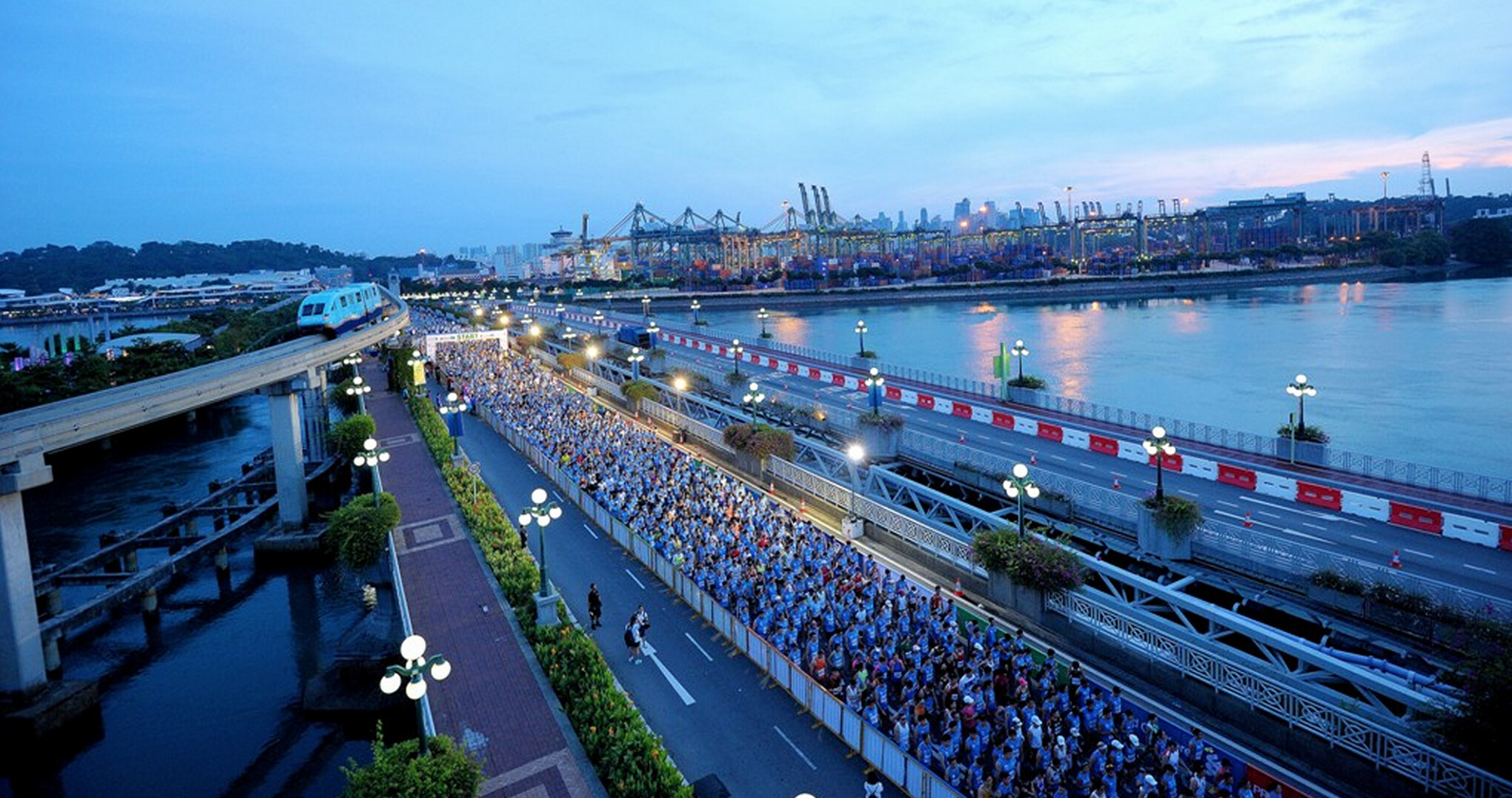
Earlier on Wednesday (Nov 3), it was revealed that the Republic would stage a prestigious table tennis tournament organised by World Table Tennis, which would see the world's top players, including China's Olympic champions Fan Zhendong and Chen Meng, grace the OCBC Arena.
Other sports events set to be staged here are the Dec 5 to Jan 1 Suzuki Cup football tournament, with golf's Asian Tour also having two events pencilled in for January next year.
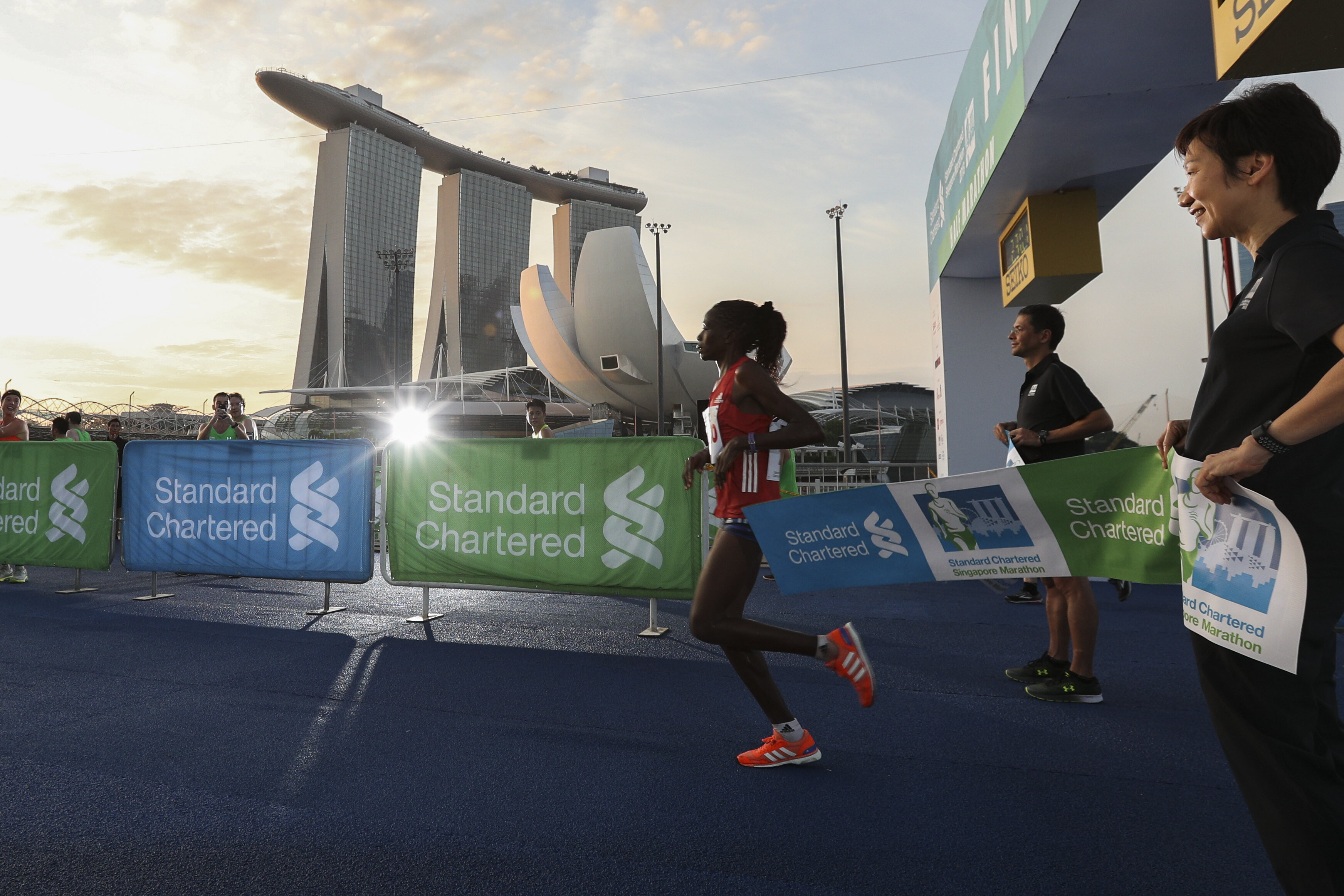
SCSM organisers made the announcement on Wednesday afternoon, as registration for the events opened at 4pm on the same day.
The number of in-person participants over the two days will be capped at 4,000. They must all be fully vaccinated or own a valid negative pre-event test result for the duration of the event - and they will be spread out over four sessions of 1,000 people each.
The two sessions on Dec 4 are the Toyota Ekiden (team of four), from 6am to 1pm, and the 5km event, from 4pm to 9pm.
The following day, the 10km event will be held across two sessions, from 6am to 11.30am and from 4pm to 9.30pm.
Runners in each session will be further split into different groups and flagged off in waves of 50 runners, with three runners moving off every 10 seconds.
This, organizers said, may be adjusted to align with prevailing Covid-19 safe management measures and guidelines. Unlike previous editions of the SCSM, there will be no road closures this year.
Those opting for the VR options can choose from more race categories, namely the 5km, 10km, Half Marathon, Kids 1.5km and Kids 3km.
The SCSM typically attracts close to 50,000 runners annually.
It is the nation's largest mass participation sports event, and in 2019 - the last time it was held in the physical format prior to the arrival of the pandemic - the event saw 70,000 spectators line local streets to cheer participants on.
Last year, the SCSM took on a hybrid race format incorporating a virtual race and augmented reality. The latter allowed participants to run on a treadmill to complete their races, and create avatars and see themselves competing with fellow runners in real time. This edition attracted 12,000 entrants.
"We remain committed to bringing sport back safely and hope to see more individuals develop an interest in the sport, and further grow our local running community."
Singapore Tourism Board chief executive Keith Tan said he was glad this year's event will give runners an opportunity to run in an in-person event safely, while allowing more local and international runners to be part of SCSM virtually.
"We hope that this event will help keep Singapore top of mind among the global running community and inspire them to experience Singapore in person soon."
(11/03/2021) ⚡AMPby Sazali Abdul Aziz
SINGAPORE MARATHON
The Singapore Marathon is an annual international marathon race which is held in December in the city of Singapore. It is an IAAF Gold Label Road Race. It has grown significantly since its inaugural race in 1982 – the 2013 event attracted a total of 60,000 entrants for all categories. There are four separate categories of competition: the full marathon,...
more...Shalane Flanagan will conclude her six major marathon at New York City Marathon
Sometime before noon in Central Park on Sunday, Shalane Flanagan should cross the finish line of the NYC Marathon. That, alone, will be no small feat for the 40-year-old former Olympic runner.
Now consider this: She will become the first person to ever run the six World Marathon Majors in just six weeks.
Because of the pandemic, the Boston, London and Tokyo Marathons were moved from their traditional spring dates to October, and now all six races are being staged in a 42-day stretch for the first -- and likely only -- time.
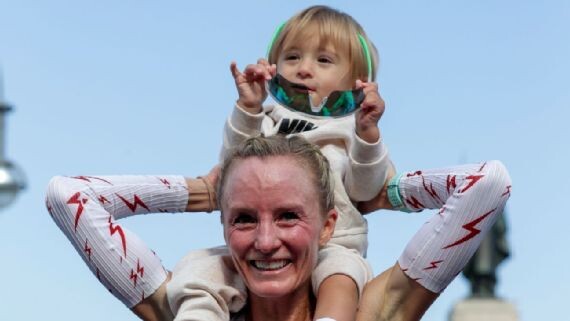
"When I saw how the marathon schedule unfolded, it felt like a once-in-a-lifetime opportunity," said Flanagan. "I coined it an eclipse because it was just so rare this would ever happen. It didn't take long for me to think, 'Why shouldn't I be the one to do it?'"
While Flanagan is no stranger to the marathon distance -- she won the New York Marathon in 2017 -- her mission is all the more improbable as she is technically retired, after announcing her departure from the sport two years ago.
"My retirement coincided with two reconstructive knee surgeries, and I basically couldn't run for a year. Then we hit a pandemic," Flanagan said ahead of Sunday's race (8:30 a.m. ET, ESPN2/ESPN App). "During that time I became a mom and a coach, so there were a lot of life changes, and I realized how much of my mental health is tied into running. I actually really need running. It's not a job for me, it's a passion. I missed having goals. Athletes are so goal-oriented and everyone was goal-less during the pandemic.'"
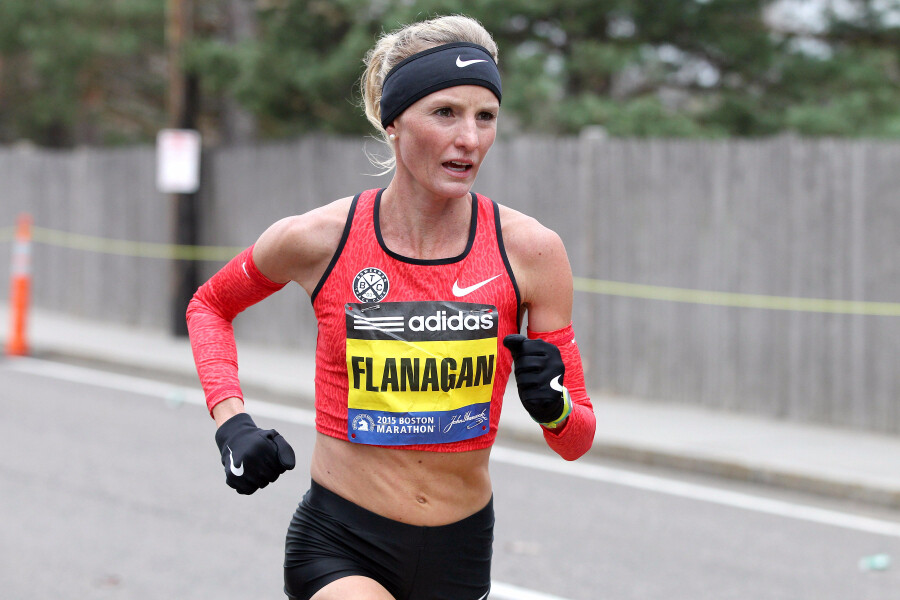
She set a sub-three-hour goal for each of the races and has shattered the mark in each race so far, including a 2:35:04 time in London.
Her current quest has pushed her physically and mentally but she's loved every minute of it. Joined by her 18-month-old son Jack as well as a tight-knit, all-female group that includes her physical therapist, a photographer and a Nike brand manager, Flanagan has awed fans around the world with her globe-trotting journey.
But it's just Shalane being Shalane, according to those who know her best.
"Shalane is always the type to just go after something," said 2020 Olympic steeplechase silver medalist Courtney Frerichs, who trains with Flanagan at Bowerman Track Club in Portland, Oregon. "I remember a few weeks after she won in New York [in 2017], she was back in training with us, fully right back in it, and I could barely keep up with her. That's just who she is.
"I wasn't surprised when she said she was doing this but I have been surprised at just how much fun she's having with it."
For many athletes, the idea of running 157.2 miles of competitive races would hardly be the retirement dream, but most athletes aren't Flanagan, who made a career of the unexpected. She was the first American woman to win in New York in 40 years when she crossed the finish line first in 2017 and is one of just two Americans to medal in the 10,000 meters at the Olympics. Flanagan earned the bronze medal in Beijing in 2008 (and it later was upgraded to silver following a failed doping test by Elvan Abeylegesse). She's always blazed her own trail.
And she didn't venture far away from the sport after officially retiring. She almost immediately began coaching at Bowerman, where she had been based for over a decade. She now worked with many of the younger runners she had been training alongside, including Frerichs.
"She was the driving force in creating a women's team here. She's always been such a leader and has truly always wanted to help others succeed," Frerichs said. "When I look back at this last year, she has played such an instrumental role."
"I basically prepped in six weeks, which is really short in the marathon world," Flanagan said. "But given the context of my lifetime of training, it was appropriate. I wouldn't recommend that though for most people."
After Sunday, she said she has no plans to run for at least a month. But the break likely won't last much longer than that.
"I think at the end I'll be thinking of how much fun we've had. I guess now I've got to dream up another hard challenge."
(11/03/2021) ⚡AMPby D'Arcy Maine
TCS New York City Marathon
The first New York City Marathon, organized in 1970 by Fred Lebow and Vince Chiappetta, was held entirely in Central Park. Of 127 entrants, only 55 men finished; the sole female entrant dropped out due to illness. Winners were given inexpensive wristwatches and recycled baseball and bowling trophies. The entry fee was $1 and the total event budget...
more...How Long Should Your Longest Marathon Training Run Be?
Marathon training has many nuances, but one of the most common questions is also one of the most basic. How far should you run before a marathon? What’s the longest long run you need to do in order to finish, PR, or qualify for Boston?
If you look at popular training methods, you will receive answers ranging from 16 miles (Hansons) to 26 miles (Galloway). Other plans follow the framework that a long run should not comprise more than 25% of the overall weekly mileage nor exceed three hours in duration. The wide array of answers can be overwhelming and confusing.
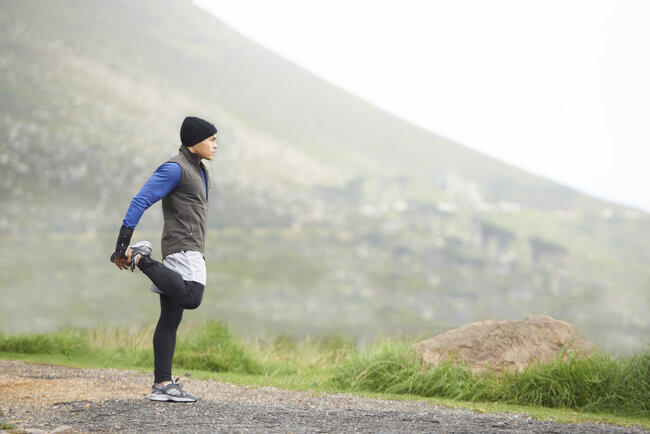
The truth is, the answer is not the same for every runner. These are some factors to consider when determining how far you should run before a marathon.
This post talks about the longest long run of training. This does not mean that every long run should be this length! You want to gradually increase your mileage, add in variety, incorporate cutback weeks, and include an appropriate taper.
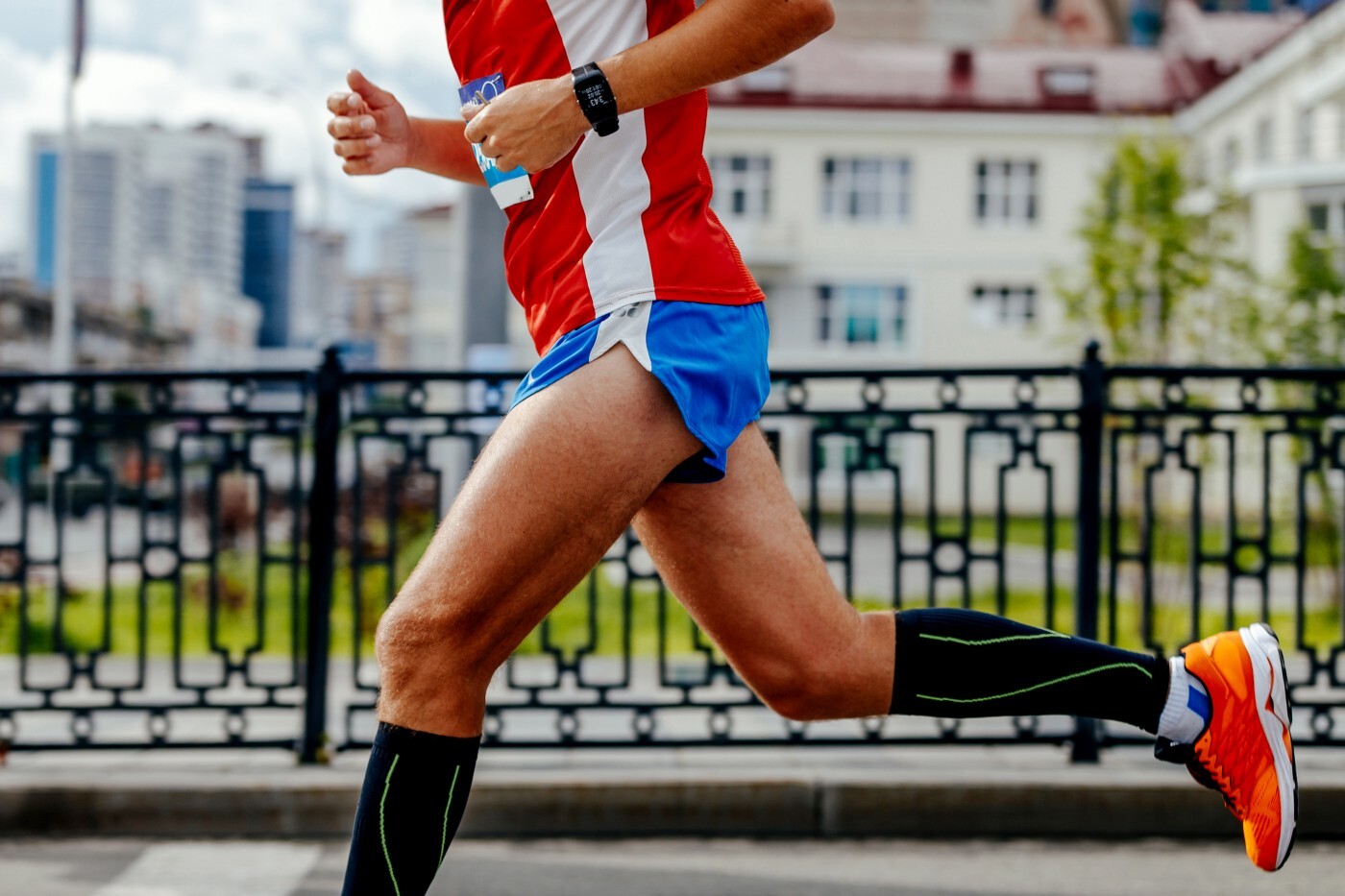
CONSIDER TIME ON FEET, NOT DISTANCE
The marathon is 26.2 miles regardless of how fast you run. However, the training of a 3:00-3:30 marathoner will look much than the training of a 5+ hour marathoner. Several factors differentiate their training, but one of the biggest differences will be the long run.
A 5 hour marathoner will take longer to run 20 miles than a 3:30 marathoner. Yes, the 5 hour marathoner will have to prepare for more time on their feet on race day. However, a point of diminishing returns exists; too long of a long run will increase injury risk and include recovery so long that it interferes with the next week of training.
The exact duration of the longest long run during marathon training depends on your anticipated finish time. A 3:30 marathoner needs to prepare for 3.5 hours on their feet. A long run of 3-3.5 hours is both practical and safe (although be sure to consider the factors below) – roughly 20-22 miles. No need exists for the 3:30 marathoner to run for four hours in the long run.
However, a 5:00+ marathoner needs to prepare for time on their feet and will likely complete 4 to 4.5 hour long runs. They might cover 18 miles or 19 miles total in this time. It is not recommended to run for longer than 4.5 hours due to the prolonged recovery period and increase the risk of injury.
For more on the difference in long run training times, reference this article from Greg McMillan. The advice is practical to the average marathoner and scientifically sound.
CONSIDER INJURY RISK
We could try to break down all the reasons why, but one of the most basic variations between individual runners is that some are prone to injury and others are not. Some runners can make all sorts of training errors and cross the finish line of their marathon injury-free. Others endure injury in marathon training no matter what precautions they take.
(11/03/2021) ⚡AMPby Colorado Runner
The 2021 Los Angeles Marathon returns on Nov. 7 debuting a new 26.2-mile course that is expected to draw thousands of runners from around the world
The marathon’s new “Stadium to the Stars” course begins at Dodger Stadium, runs through West Hollywood and Beverly Hills before ending on Avenue of the Stars in Century City.
That means that the course will follow its traditional route until Brentwood, where runners double back on San Vicente, Sepulveda and Santa Monica boulevards before finishing at Avenue of the Stars. Organizers say this will allow for a more interactive finish and greater spectator participation.
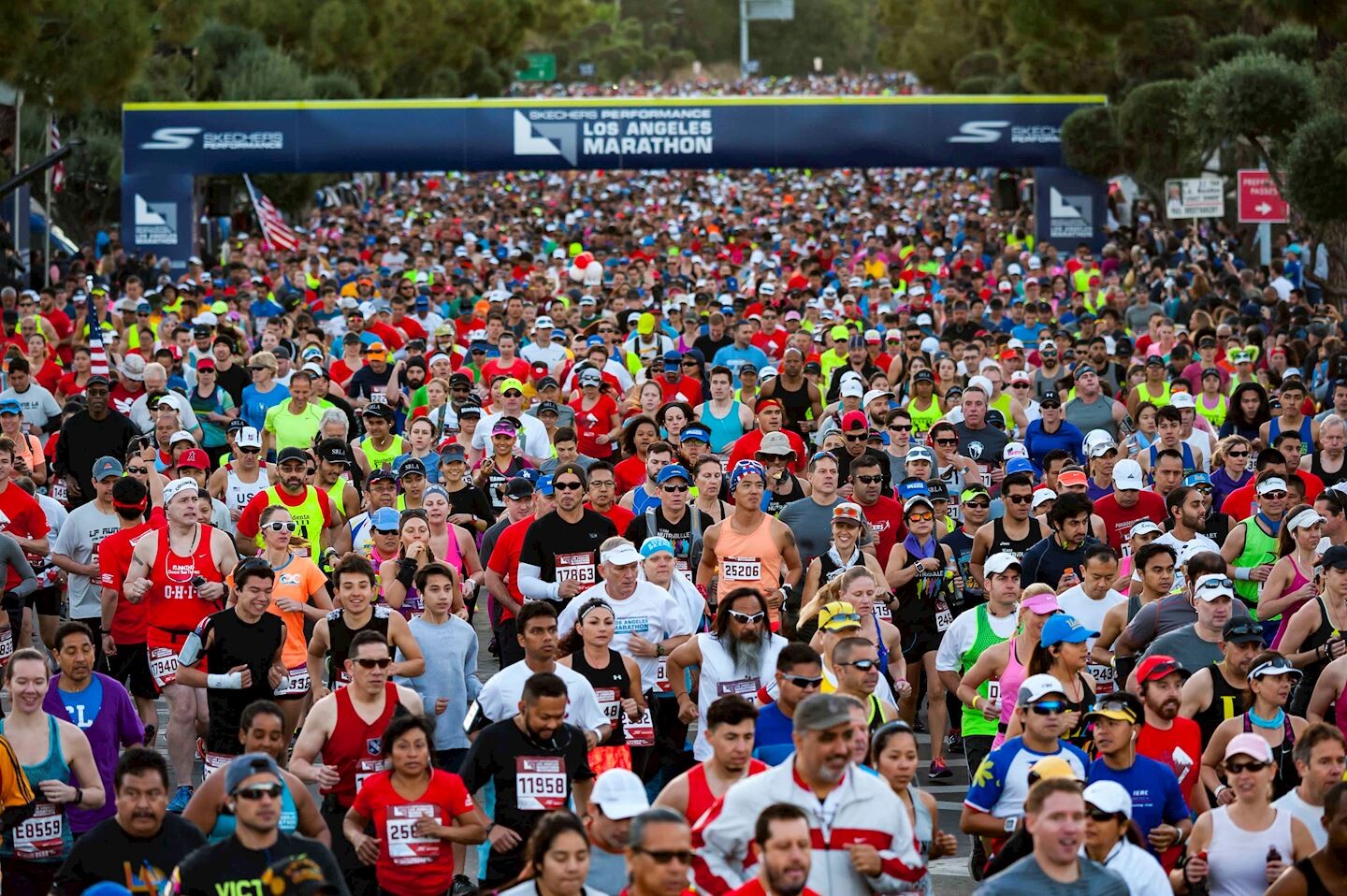
Because of pandemic-related delays, it will be the first time the L.A. Marathon will be run in November. And since it’s considered a mega event, runners will be required to show proof of full COVID-19 vaccination, or negative test results to participate.
When does the marathon begin?

The main event will begin with the wheelchair start at 6:30 a.m. Sunday, Nov. 7, followed by the elite women at 6:45 a.m. and the elite men and full field at 6:55 a.m.
At 8:14 a.m., Charity Challenge 13.1 participants will start.
Since daylight saving time ends at 2 a.m. the same day, don’t forget that clocks fall back an hour.
How to watch
KTLA Channel 5 will have live coverage of the event, starting from 6 a.m. until 11 a.m. that Sunday.
Viewers can also watch the race on KTLA.com, the KTLA 5 News app, KTLA’s YouTube or KTLA+, which can viewed on the KTLA+ app on Apple TV, Roku and Firestick.
KTLA’s Facebook page will also have a livestream from the finish line cam.
The finish line will be open for six hours and a half after the start of the race.
For those hoping to get an in-person look at the finish line, organizers say spectator access will be limited on Avenue of the Stars from Santa Monica to Constellation boulevards.
Spectators who want to watch runners cross the finish line will need to head to the area of Santa Monica Boulevard and Avenue of the Stars.
(11/02/2021) ⚡AMPLos Angeles Marathon
The LA Marathon is an annual running event held each spring in Los Angeles, Calif. The 26.219 mile (42.195 km) footrace, inspired by the success of the 1984 Summer Olympic Games, has been contested every year since 1986. While there are no qualifying standards to participate in the Skechers Performnce LA Marathon, runners wishing to receive an official time must...
more...The Best Places to Watch the New York City Marathon
It has become the city’s biggest block party. Here’s where to cheer for the 30,000 runners in every borough.
By Ashley Wong
The New York City Marathon, one of the world’s largest marathons, is back. This year’s race will be smaller, with 30,000 runners instead of the usual 55,000. But it is expected to be a major, and emotional, milestone in New York’s recovery from the coronavirus pandemic.
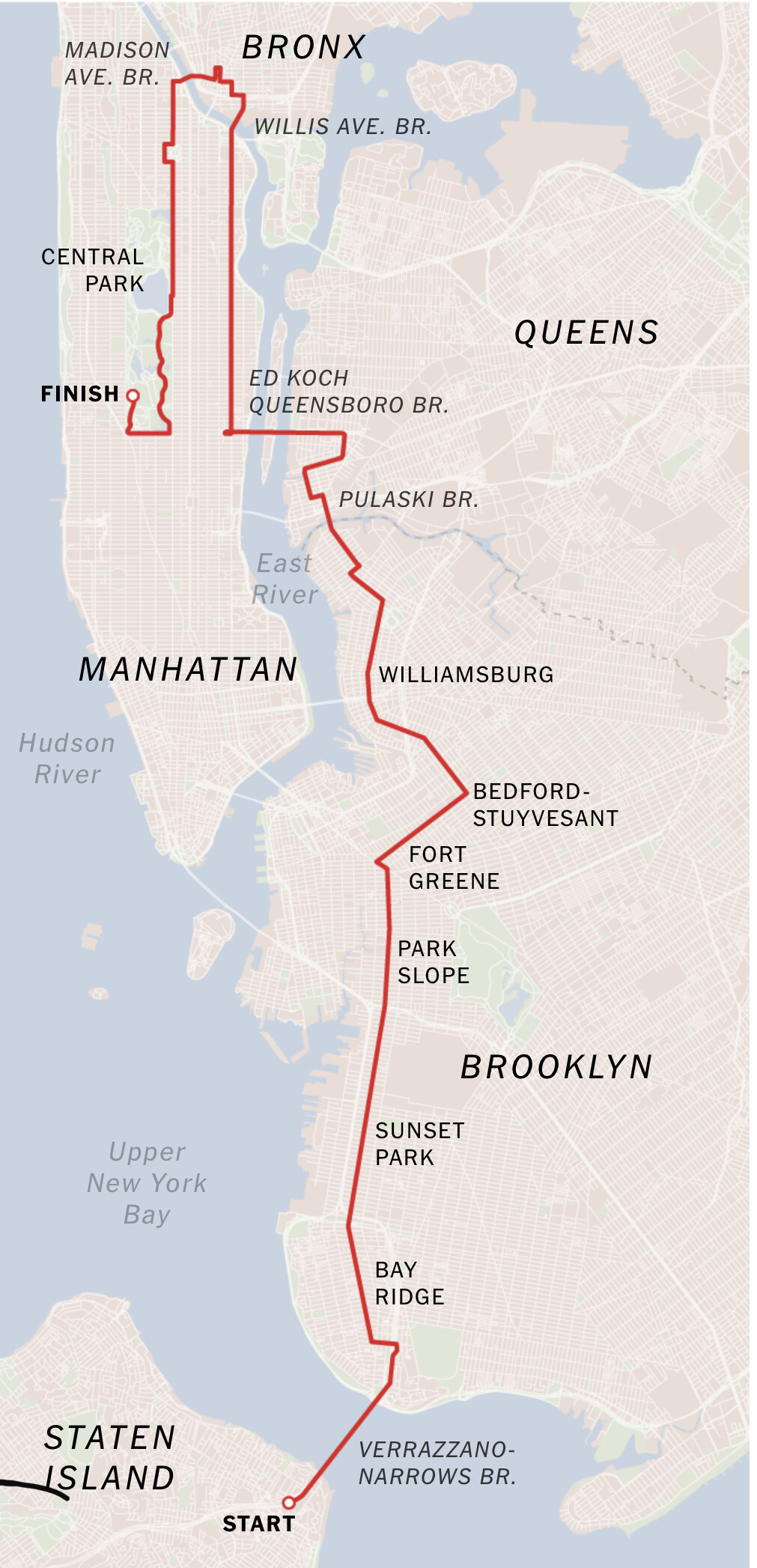
A big part of marathon Sunday is the crowd. Spectators dot the 26.2-mile course and keep tired runners motivated.
People who line the course and pull for the participants power the runners forward, Ted Metellus, the New York City Marathon race director, said.
“The single greatest thing in the world is navigating through this city, and every single person is cheering your name, every single person is excited to see you,” Metellus, a 15-time marathoner, said. “They are part of the participant’s journey and their story.”
Here’s a breakdown of the best places to watch the race in each borough:
Staten Island
It is nearly impossible to cheer in Staten Island, as marathoners spend most of their time there in the Fort Wadsworth start village before the cannon goes off on the Verrazzano-Narrows Bridge. But some New Yorkers put encouraging signs in their yards, just in case a bus shuttling runners passes by.
Brooklyn
One of the best places to spot runners also happens to be the first. Without any spectators at the start or along the Verrazzano-Narrows Bridge, the first two miles of the race are quiet. So participants are eager to see spectators along Fourth Avenue in Brooklyn, right after they exit the bridge. The closest subway stop is Bay Ridge-95th Street on the R line, and you can hop on and off the R train along Fourth Avenue to catch runners through Bay Ridge, Sunset Park and Park Slope.
If you’re looking for an easy transit option from across the city, go to the intersection of Fourth Avenue and Flatbush Avenue, served by the B, D, N, Q, R, 2, 3, 4 and 5 trains. Walk from there to Lafayette Avenue between Fulton Street and Bedford Avenue, where you’ll be treated to one of the best parties along the course. Expect to hear “Gonna Fly Now,” the theme from the movie “Rocky,” on loop.
You can catch runners at multiple points in Williamsburg and Greenpoint, along Bedford Avenue from Flatbush to Nassau Avenue. Take the L train to Bedford Avenue, the M or J train to Marcy Avenue or the G train to Nassau Avenue or Greenpoint Avenue.
Queens
About two miles of the race go through Queens. Catch runners as they exit the Pulaski Bridge on the Queens side, which is right around the race’s halfway mark. This is where some runners realize they are only halfway done, so a little extra energy can go a long way. You can take the 7 train to Hunters Point Avenue, Vernon Boulevard or Jackson Avenue, or the G train to 21st Street.

Bronx
Though the Bronx is one of the shortest stretches of the race — from Mile 19.5 to Mile 21 — it is also one of the best places to cheer. The race’s 20-mile mark, around 135th Street and Alexander Avenue, is a notoriously challenging part of the race where runners may hit the proverbial “wall.”
Many local running clubs set up there to ring cowbells and cheer, so it is guaranteed to be a boisterous spot for spectators and runners. Take the 6 line stopping at Brook Avenue or Third Avenue-138th Street, or the 4 and 5 lines to 138th Street-Grand Concourse.
One tip? Do not, under any circumstances, scream, “You’re almost there,” along this stretch. They are not, in fact, almost there.
Manhattan
The race moves through Manhattan twice — first coming out of Queens from East 59th Street to 125th Street (Mile 16 to 19.5), and then again heading out of the Bronx before ending in Central Park (Mile 21 to 26.2).
If you’re the kind of person who likes a crowd to cheer with, First Avenue from 59th Street to 96th Street in Manhattanis always lined with spectators, especially with all the bars and restaurants on this part of the course.
In East Harlem, catch the runners just before they head into their 20th mile anywhere along First Avenue from 110th Street to 125th Street, served at multiple points by the 6 subway line. The further north you go, the less crowded it is and the more needed your encouragement will be for the marathoners.
You can also catch runners just before they finish in Central Park at Fifth Avenue from East 105th to East 90th Street. This is a particularly iconic section of the race, dotted by museums on the east and bordered by Central Park on the west. Many train lines will take you here, including the 4, 5, 6 and Q lines.
And if you want to scream and shout as runners triumphantly cross the finish line, you can purchase tickets for the grandstand event at West 67th Street and West Drive.
(11/02/2021) ⚡AMPby New York Times
TCS New York City Marathon
The first New York City Marathon, organized in 1970 by Fred Lebow and Vince Chiappetta, was held entirely in Central Park. Of 127 entrants, only 55 men finished; the sole female entrant dropped out due to illness. Winners were given inexpensive wristwatches and recycled baseball and bowling trophies. The entry fee was $1 and the total event budget...
more...













